





THE temperature of the imported beef market in the United States could be about to be turned up again after President Donald Trump’s latest tariff announcement threatened to shut out the country’s biggest supplier as early as next month.
Exporters had reported a slight cooling of the US market for grinding beef in recent weeks as importers digested record-high prices and a surge in Australian and Brazilian shipments to the US ahead of Trump’s April 2 Liberation Day tariff announcements.
The United Kingdom and Canada have been increasingly featuring in industry trade statistics as exporters sought alternatives to the US, where importers have been attempting to pass the 10% tariff back to New Zealand exporters in the form of lower prices.
But a fresh Trump threat to impose a 50% tariff on all imports into the US from Brazil from August 1 could supercharge the imported beef market in the US once again – although the reaction from buyers so far had been “muted”, one exporter said.
Exporters said the threatened tariff, which would be on top of Brazil’s existing 26.4% beef tariff into the US, would be a “trade stopper” for the South American beef powerhouse, which exported
175,000 tonnes to the US in the first five months of the year, accounting for 21% of US beef imports over the period. Over the same period NZ exported 96,000t.
Wellington-based Taylor Preston’s beef sales manager, Cameron Kyle, said there had been a pick-up in interest from US buyers since the latest announcement, although they remain sensitive to price rises.
With prices for 90CL and 95CL beef trim “historically high”, buyers are acting “cautiously”.
“I have gone out with some pricing but there is definitely a reluctance to commit to the pricing I have indicated,” Kyle said.
Greenlea Premier Meats chief executive Tony Egan reported a “muted reaction” so far from US customers.
“There is an amorphous soup of tariff discussions swirling around the world.
“Everybody is a bit confused about where this is all going and whether [the tariffs] will end up being slapped down again.
“There will definitely be an impact if it transpires but it is probably too soon to say.”
Alliance Group’s global sales director James McWilliam said a trade-stopping tariff on Brazilian beef exports has the potential to “rebalance competitive dynamics in the US market” in favour of NZ and Australian exporters. However, the extent to which
Continued page 3

Gisborne high country sheep and beef farmer Rebecca Williams has a special talent for capturing a range of farming scenes, but it’s the loyal working dog that she most loves to photograph.
PEOPLE 10

Camera trials in woolsheds mooted to monitor shearing standards.
Rebecca Williams
Great colostrum management and strong animal health policies have helped Jo Earwaker grow healthy replacement calves on the dairy farm she runs with husband Michael.
DAIRY 17-27
3 Legal showdown looming over registration of kiwifruit variety.
5
Photo: Jo Earwaker
Rob Hewett reflects on 17 years at Silver Fern Farms.
PEOPLE 12


Bryan Gibson | 06 323 1519
Managing Editor bryan.gibson@agrihq.co.nz
Craig Page | 03 470 2469 Deputy Editor craig.page@agrihq.co.nz
Claire Robertson
Sub-Editor claire.robertson@agrihq.co.nz
Neal Wallace | 03 474 9240
Journalist neal.wallace@agrihq.co.nz
Gerald Piddock | 027 486 8346
Journalist gerald.piddock@agrihq.co.nz
Annette Scott | 021 908 400
Journalist annette.scott@agrihq.co.nz
Hugh Stringleman | 027 474 4003
Journalist hugh.stringleman@agrihq.co.nz
Richard Rennie | 027 475 4256
Journalist richard.rennie@agrihq.co.nz
Nigel Stirling | 021 136 5570
Journalist nigel.g.stirling@gmail.com
PRODUCTION
Lana Kieselbach | 027 739 4295 production@agrihq.co.nz
ADVERTISING MATERIAL
Supply to: adcopy@agrihq.co.nz
SUBSCRIPTIONS & DELIVERY 0800 85 25 80 subs@agrihq.co.nz
PRINTER
Printed by NZME Delivered by Reach Media Ltd
Andy Whitson | 027 626 2269
Sales & Marketing Manager andy.whitson@agrihq.co.nz
Janine Aish | 027 300 5990
Auckland/Northland Partnership Manager janine.aish@agrihq.co.nz
Jody Anderson | 027 474 6094
Waikato/Bay of Plenty Partnership Manager jody.anderson@agrihq.co.nz
Palak Arora | 027 474 6095
Lower North Island Partnership Manager palak.arora@agrihq.co.nz
Andy Whitson | 027 626 2269
South Island Partnership Manager andy.whitson@agrihq.co.nz
Julie Hill | 027 705 7181
Marketplace Partnership Manager classifieds@agrihq.co.nz
Andrea Mansfield | 027 602 4925 National Livestock Manager livestock@agrihq.co.nz
Real Estate | 0800 85 25 80 realestate@agrihq.co.nz
Word Only Advertising | 0800 85 25 80 Marketplace wordads@agrihq.co.nz
Dean and Cushla Williamson Phone: 027 323 9407 dean.williamson@agrihq.co.nz cushla.williamson@agrihq.co.nz
Farmers Weekly is Published by AgriHQ PO Box 529, Feilding 4740, New Zealand Phone: 0800 85 25 80 Website: www.farmersweekly.co.nz
ISSN 2463-6002 (Print) ISSN 2463-6010 (Online)

Three new directors have been elected to the board of Horticulture New Zealand. Simon Cook, Dermott Malley and Shaun Vickers will take up their positions after the HortNZ annual general meeting on August 26. HortNZ chair Bernadine Guilleux said they bring a valuable mix of governance experience, operational expertise and sector insight.
PGG Wrightson has revised its earnings before interest, taxes, depreciation and amortisation operating guidance for the financial year ending June 30 from $51 million to $54m.
This forecast reflects stronger-thananticipated performance across several businesses. The agricultural sector has rebounded and has built momentum as the financial year has progressed, PGW chair Garry Moore said.
New Zealand and Malaysia have committed to boosting trade in high-quality halal meat products.
Minister for Food Safety Andrew Hoggard said Malaysia is facilitating the approval of several New Zealand halal meat premises seeking first-time access to this market, which is crucial to growing exports. “With a population of more than 35 million people, new access will help set the stage for significant growth in the Malaysian market.”
Multi-award-winning farmer Ben Purua has been named Meet the Need’s first ambassador.
The south Waikato-based dairy farm manager was the 2024 Ahuwhenua Young Māori Farmer of the Year, Central Plateau Dairy Manager of the Year, and is a National People & Leadership Award winner. As ambassador, Purua will use his voice, platform and experience to champion the charity’s mission: ensuring every New Zealander has access to nutritious protein.



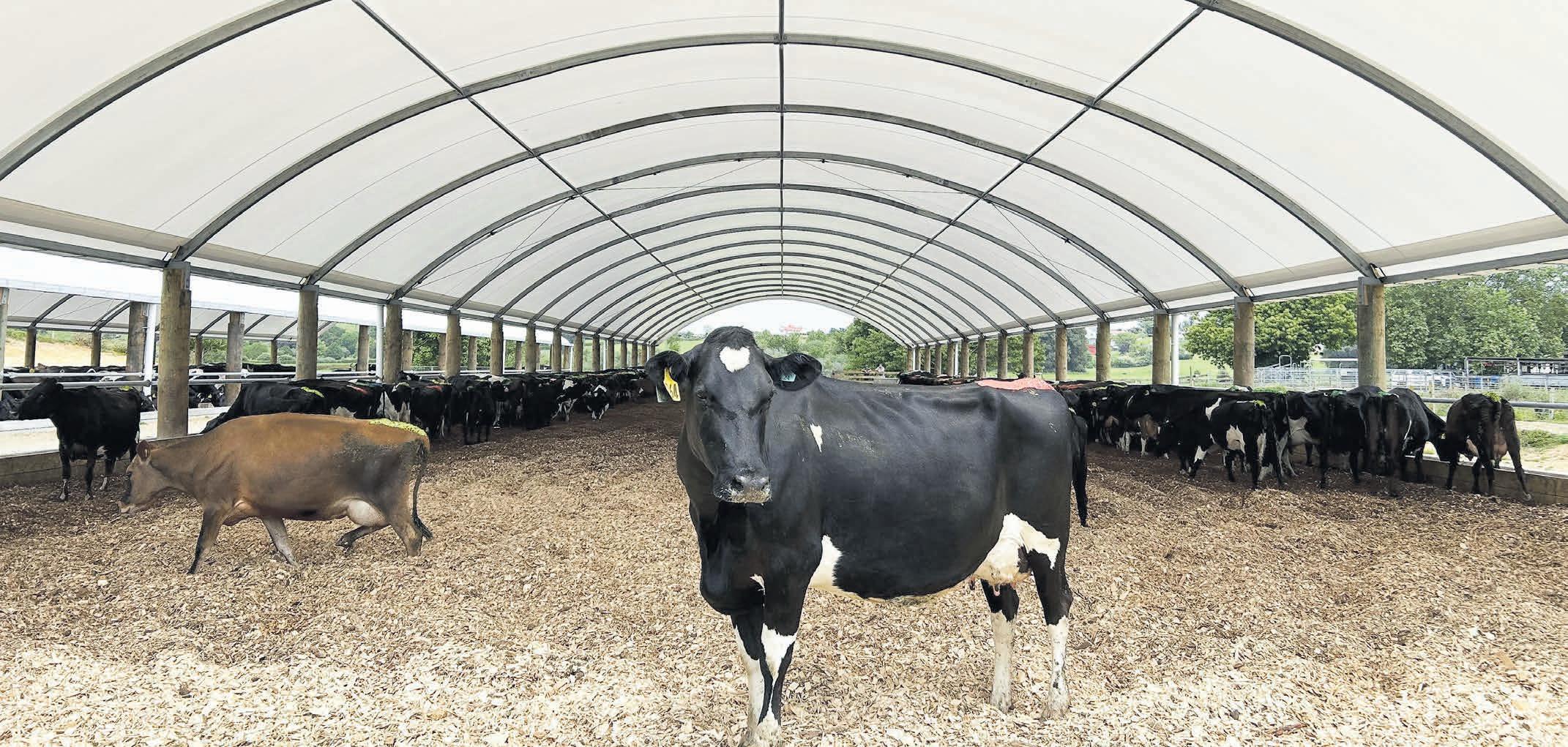


Wallace NEWS Food and fibre
ATRIAL of cameras in woolsheds to monitor shearing standards will be offered to some New Zealand Merino suppliers in response to apparent animal welfare breaches covertly filmed by an animal welfare group.
The shearing monitoring trial, which will run for up to two years, is for suppliers to NZ Merino’s ZQ quality assurance programme, who will also have the choice of appointing a trained in-shed animal welfare officer.
This is not going to go away without us taking action.
From July 1 ZQ accredited farms will be subject to unannounced spot inspections at key stock handling periods, such as shearing, by third party auditors from the Control Union and NZ Merino (NZM) staff.
“This is an extension to our existing contract with these auditors, and we are covering all associated costs,” said Matt Hand, NZM’s global supply manager. A new animal welfare module will be added to the existing brand
Continued from page 1
exporters could profit from Brazil’s exit is limited by quota allocations for the US market.
Exporters face a US$0.04 tariff for every kilogram of beef sold up to the NZ’s annual quota limit of 213,402t, and a tariff of 26.4% once the quota is exceeded, and since April 5 a further 10% tariff has been added to all NZ products entering the US.
partner funded shearing and woolhandling training programme, which will also be expanded.
Plunge dipping – which is not common practice on ZQ farms –will be prohibited, Hand said.
He said animal welfare is a core tenet of the ZQ programme and the footage filmed in multiple sheds by PETA and released at Christmas showed unacceptable acts.
“While most of it wasn’t filmed on ZQ properties, over 1.6 billion people have been exposed to the worst of the wool industry.
“This isn’t us responding to PETA, this is us ensuring our brand customers and their consumers have confidence in the excellent work the vast majority of wool growers do.”
He said PETA’s campaign is continuing, with customers in key markets receiving daily appeals to drop wool.
“Just two weeks ago, PETA posted up an activist influencer outside one of our customer’s stores in New York to film members of the public reacting to horrific imagery.
“This is not going to go away without us taking action.”
In-shed cameras are one option for growers to monitor shearing. Their use in other industries provides impartial, indisputable coverage and context.
Hand said the trial will give growers and brand customers the opportunity to share their ideas and concerns.
Exporters are allocated a share of the quota, recalculated annually according to recent production history.
The last time NZ came close to exhausting its quota was in 2015 when it used 99.97%, according to figures provided by the NZ Meat Board.
Last year 85.16% was used.
Australia used 97.29% of its 378,214t quota in 2024, up from 57.72% the year before.
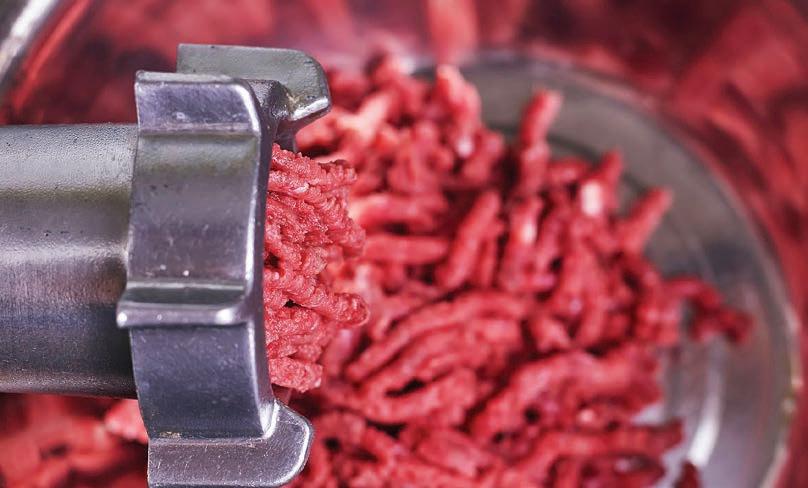

“These trials are in place to ensure that we can implement a pathway to achieving those benefits, without undue burden falling on our community of growers.”
Growers will also be provided with additional training, an induction video for new shed staff
outlining expectations, an updated shearing pack and stock handling workshops.
The new standards were recommended by a working group that included NZ Merino and representatives from the sheep and wool industry including ZQ growers, brand partners,
INSPECTIONS: From July 1 ZQ accredited farms will be subject to unannounced spot inspections at key stock handling periods, such as shearing.
shearing contractors, veterinarians and animal welfare advocates.
Gary Orr, the Ministry for Primary Industry’s director of investigations and compliance support, says its investigation into the abuse allegations is continuing.

Gerald Piddock NEWS Dairy
LAST year’s controversy when Arla Foods came under fire for selling dairy products with milk made from the methanereducing additive Bovaer shows the need for both data and transparency when using such products, AgriZero says.
Speaking at a webinar organised by the Ag Emissions Centre, AgriZero head of ventures David Macdonald said there are lots of lessons to be learnt from how Arla handled the issue.
“We have to be aware that farmers are very protective and conscious about what they are feeding their animals and so are consumers about what they are eating.
“We have to make sure all of the right tests and trials are done properly to ensure there is a full dossier there in behind everything we sell and promote.”
Transparency will be key in ensuring the public is on board, with one of AgriZero’s investments, Ruminant Biotech, set to release its methanereducing bolus to the market early next year, head of catalyst at AgriZero Deborah Roche said.
Established in 2023, the publicprivate joint venture is owned half by the government and half by private companies and was set up to invest in companies that are creating tools to help reach the target of 30% reduction in ag emissions by 2030.
The pair presented an overview of the current state of play of
AgriZero’s investment portfolios.
Macdonald said out of the $191 million put up for its first four years of operation, they have invested $61m.
The majority of that is in tools and technologies involving nine different companies located both domestically and abroad that they have invested in.
Farmers are very protective and conscious about what they are feeding their animals and so are consumers about what they are eating.
David Macdonald AgriZero
There are also five catalyst investments.
“We also have a fair number on our radar because we realise we will need a few more investments to make sure we have covered all of the technology types that will assist in helping the
different dairy, beef, deer and sheep systems in New Zealand to reduce emissions.”
Their remit includes assurance from those international companies that they will commercially release their product in New Zealand.
Chief in their investment criteria is that it has to be applicable to a pastoral farming system and key to that is having a slow-release mechanism within the animal’s rumen.
They also have to be commercially viable, he said.
As well as Ruminant Biotech’s bolus, looking promising are solutions around methanereducing pastures and the development of a methane-inhibiting vaccine.
While some companies are focusing on northern hemisphere feedlot-style farming systems, 80% of livestock globally is on pastures.
“There is a huge market for this tech, and it will be the natural evolution to try and roll out this technology globally.”


THE country’s meat companies are willing to look for solutions to address excess processing capacity, Silver Fern Farms chief executive Dan Boulton told farmers last week.
Boulton told more than 300 people attending the company’s Farmer Conference in Hamilton that discussions with other meat companies indicate a willingness to discuss the issue and find solutions.
“We will play a role driving these conversations forward but we can’t do it without farmers.
“Something has to change. The ‘last man standing’ is not a sustainable scenario.”
There has been speculation that more than six plants may eventually close given the rate at which livestock numbers are declining.
Boulton said with more than 60 processing plants in New Zealand, companies are spending money keeping them operating instead
of investing in areas that provide greater returns.
That money is coming from the pockets of shareholders.
“I would much rather be spending on value-added projects and production gains in-market or digitising the supply chain – real investment that grows returns instead of maintaining stainless steel.”
I would much rather be spending on ... real investment instead of maintaining stainless steel.
Declining livestock numbers was another issue discussed, prompting multiple calls for farmers to be loyal to their company by supplying all their animals.
Boulton said with the world wanting more protein, it creates difficult discussions when customers can’t get product.
Retailers will not accept empty
shelves too often and one option could be to collaborate with other processors to ensure high value customers have product.
SFF chair Anna Nelson said global volatility means companies working more closely with their customers but they also need the support of their suppliers.
SFF chief customer officer Dave Courtney said all options are on the table as it addresses livestock shortage issues over the next decade, and that includes consideration of partnering with like-minded producers offshore.
He said any decision must add value to shareholder-suppliers and provide customers with product that meets their requirements and SFF’s standards.
Other options include looking at its customer base, the mix of markets, extracting more value from new products and the fifth quarter, attracting more suppliers through supply contracts, and partnering with like-minded producers.
“These are challenges we need to think through, but they’re challenges worth thinking about in the context of being suppliers

Richard Rennie MARKETS Trade
THE free trade agreement between New Zealand and the United Arab Emirates is not only the fastest ever to be signed by this country, it is also a welcome lever to grow and rebalance trade between the two countries, says NZ Trade and Enterprise commissioner Ahmad Zakkout.
Announced last September, the agreement was concluded in only four months and eliminates duties on 99% of all exports within three years.
Already NZ’s main Middle East export market, it comprises $1.3 billion of trade to June 2024.
Speaking at an inter-agency seminar on exporting to the UAE, Zakkout said at present there is a significant deficit between NZ and the UAE, with about $1.2 billion of NZ exports there, but only about $160 million a year of imports from the UAE.
“We do end up with a lot of empty containers coming south, and the hope is we can be filling more of these in coming years,” he said.
In 2023 the main exports from the UAE to NZ were carpets, glass bottles and ethylene polymers.
There was a concerted effort by the country’s government to build on its manufacturing capacity, particularly for finishing products already partially completed in other countries.
This included products from India where manufacturers may wish to leverage off FTAs to help access other countries.

“UAE has signed or is negotiating on 28 FTAs and looking at advancing that to close to 100. There is a vision there that by 2031 UAE will also be a global transit hub.”
Dubai international airport already has almost 100 million passengers a year passing through it, making it the world’s busiest international airport
“There is a real focus on working on diversifying out of oil and gas –how can we attract talent that will stay in the UAE to live?”
A “golden visa” programme offers numerous benefits to expat workers, providing access to healthcare and education. It is aimed specifically at investors, entrepreneurs, scientists and graduates.
Simon Cartwright, treasurer
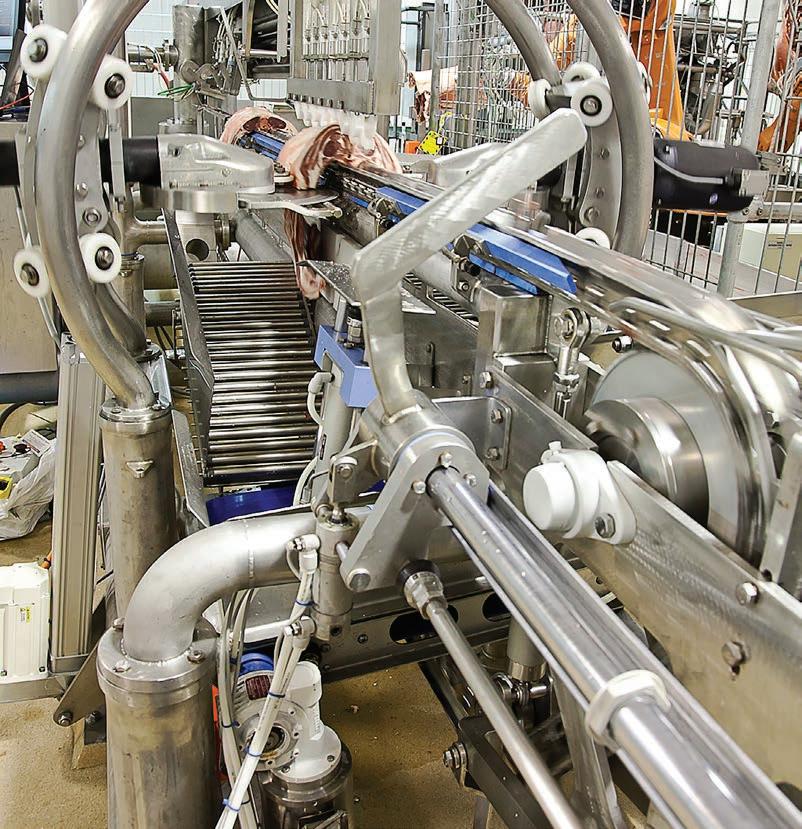
to key customers and driving value for NZ suppliers.”
Courtney said looking for an offshore supplier-partner is an option worth considering in the context of a broad ranging 10-year plan but said it would come with challenges such as aligned values and production standards.
INVESTED:
NZ Trade Commissioner to the UAE Ahmad Zakkout says the nation is committed to expanding out of its oil and gas roots, into manufacturing, tourism and technology.
of the NZ Middle East Business Council, said it is a region that recognises resilience and effort.
“It is a diverse, open market which rewards face time, trust and repeat visits.”
He urged would-be exporters to be prepared to invest years to see results if need be, and not assume success simply because they are from NZ.
David Turner, CEO of Kaweraubased timber company Sequal Lumber, said the market has surprised his company with its success, pushing sales to $50m against original expectations of $10m.
His company has used the UAE as a transit point to enter the Somalian market, one proving highly successful.
“If we did work with others, it would have to add value to our farmer’s bottom line.”
Zespri launched its global supply programme in 2021 but Courtney said it took many years to establish and Zespri has the benefit of retaining plant proprietary rights and control of the brand.

Richard Rennie NEWS Environment
A NAME change has accompanied the recent funding boost supplied by Rabobank to the national catchment group collective, now known as Catchment Communities Aotearoa.
The group, previously known as Aotearoa NZ Catchment Collective, has been granted $100,000 over 12 months by the government and Rabobank to build on the network of catchment communities nationally.
The privategovernment commitment sends a strong signal to farmer members their work needs to continue in the long term.
These are: to communicate the impact of catchment work, support long term sustainable funding for catchment communities, support knowledge and capability between and within catchment communities, and partner for success between government, not-for-profit groups and industry.
“A workplan has been developed with projects across these four pillars and the new funding will go a long way to helping us to deliver these,” Ensor said.
Agriculture Minister Todd McClay said the investment is part of a wider government package to support farmerled catchment groups that are focused on practical, local solutions that work on the ground.
Chair Ben Ensor said the private-government commitment sends a strong signal to farmer members that their work needs to continue in the long term.
The funding will be allocated to projects that align with the four main priorities of Catchment Communities Aotearoa (CCA).
Rabobank NZ CEO Todd Charteris said the bank’s impetus for investing in the project came from its client council, which had identified the important role catchment groups play in strengthening rural communities.
The client council asked the bank to look at what more it could do to support these groups, and “CCA was the ideal organisation for us to get in behind”.
Charteris said the bank is also keen to examine how its employees could assist CCA in local areas.

Richard Rennie NEWS Horticulture
LEGAL showdown
Ais looming between Zespri and a Te Pukebased plant breeding company as that company moves to register a kiwifruit variety that Zespri maintains is a version of its own fruit.
Farmers Weekly understands the variety labelled “E2” was considered by Zespri five years ago as an additional cultivar for its portfolio, but was abandoned when it was determined it had the same DNA as SunGold kiwifruit.
But late last week Zespri CEO Jason Te Brake advised growers that the Plant Variety Rights (PVR) office intends to consider a separate PVR application for the variety, on the grounds it is sufficiently different to be eligible for such protection.
Te Brake said Zespri will strongly oppose the move in the coming months, through a formal process.
In January Zespri notified its growers it was aware of the Te Puke company, Baker PVR Limited, applying for a PVR
registration and had initiated legal proceedings to obtain more information about the variety and its development.
The High Court ruled in Zespri’s favour, requiring the owner of the variety to provide Zespri with information on where the E2 plant material had been sent, and to whom.
Some of the fruit was also sold in Sydney earlier this year. Selling under the Zespri label is not compulsory in Australia. Zespri checked samples of this fruit and is said to have found it contained SunGold G3 DNA.
Plant variety rights have come to play a significant part in Zespri’s income over the past decade, particularly off its SunGold G3 variety and more recently the RubyRed fruit.
Last year the company reported revenue of $217 million in PVR licence sales, and $308m the year before, about 10% of its gross revenue.
Zespri is working to use the court’s advice to inform action to oppose the PVR application.
Baker PVR Ltd is registered on No 2 Road Te Puke, with its registered shareholders being

Russell Baker died in February this year, and was replaced as director by Gary Baker of Auckland. Leonie Baker’s directorship was replaced in June by Grahame Woodd of Waikato.
The company has appointed King’s Counsel Clive Elliott, a past president of the Intellectual
Property Society of Australia and NZ, and past president of NZ Bar Association. Elliott said he was unable to comment on the case as it passes to the PVR office.
Speaking from Japan, Te Brake said Zespri views the fruit as an infringement of its grower’s rights and product.
“We are looking at extensive legal discussions as we believe it is
to get underway immediately.”
FARMING leaders have welcomed
an infringement and we intend to see this through.
“We are open to competition, but this fruit is clearly derived from one of our own products.
“As far as I am aware this is the most direct challenge to Zespri’s PVR we have had to date,” said Te Brake.
He said he expects the discussion with the NZ PVR office to continue over coming months.
The late Russell Baker had a small orchard that was in Psa’s “ground zero” when the disease broke out in late 2010. He was also in a dispute with Zespri at the time about payment on a block of his G3 fruit requiring a licence.
Gaby Cowcill, patents science manager at the Intellectual Property Office NZ, confirmed an application has been filed for the E2 variety.
She said any person can make an objection to an application before or after granting. If an objection is made pre-granting, both the applicant and objector have a right to be heard.
“We are not able to comment further on this application or any actions that third parties including Zespri, may wish to take,” she said.
a $100,000 contribution by the government and Horticulture New Zealand to help the horticulture sector.
Langford said Federated Farmers will be playing a key role in coordinating this work, but more donations will still be required to fund recovery efforts over the coming weeks. Staff reporter
a $600,000 support package from the government and organised agriculture to help flood-affected rural communities in the NelsonTasman region.
The money is desperately needed to help recovery efforts and will make a big difference, Federated Farmers president Wayne Langford said.
“We’re incredibly grateful that the government have recognised this need early and taken practical steps that will allow clean-up work
Agriculture and Forestry Minister Todd McClay said the two regions have experienced significant damage to forests, farms and rural infrastructure.
“This funding will help meet immediate recovery needs and help rural businesses get back on their feet.”
The support package includes a $300,000 contribution by the government to the Mayoral Relief Fund tagged to the rural sector, a $100,000 contribution by the government and Federated Farmers to the Farmers Adverse Events Trust of which the federation contributed half, and
The package is on top of $100,000 announced by the government in June to support and coordinate recovery efforts, including $20,000 for the Top of the South Rural Support Trust.
“Many farmers and growers are facing their second clean-up in a fortnight from floods and storm damage.
“Rural communities are resilient, but the relentless wet weather conditions have taken a toll. This support is designed to provide
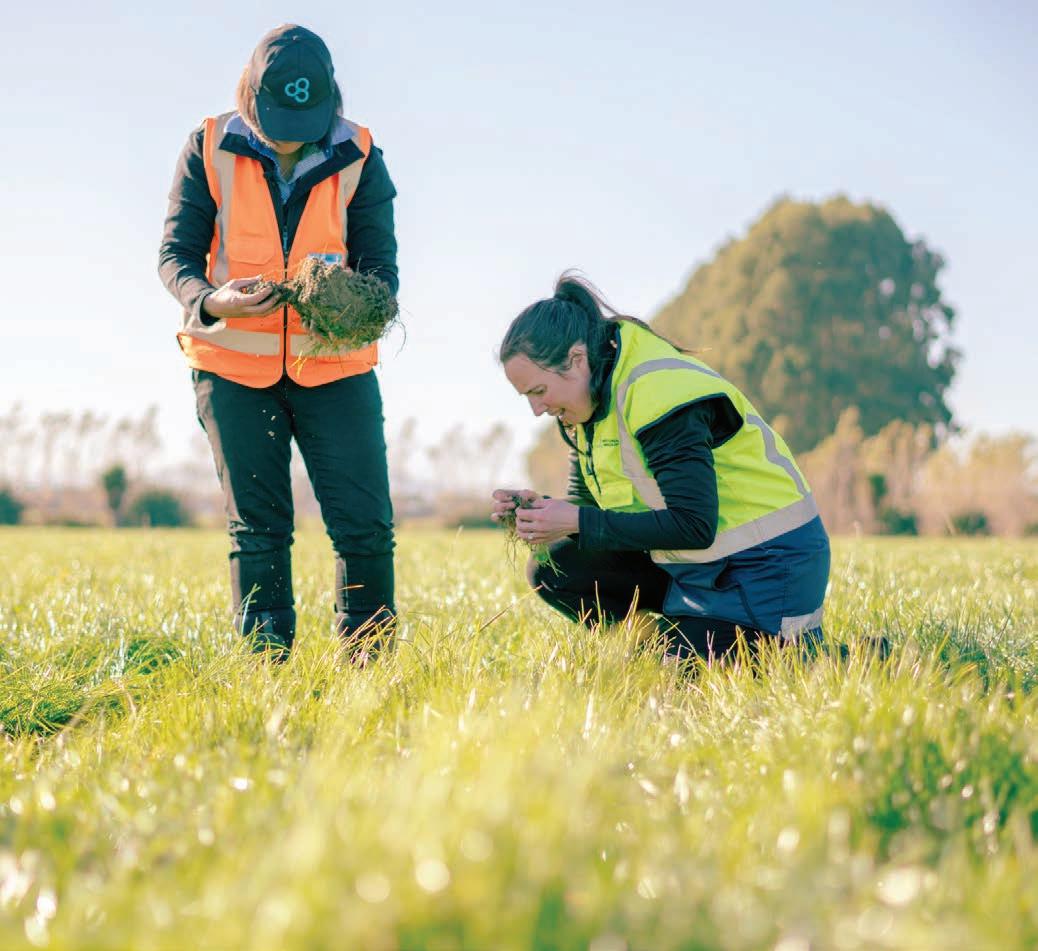

meaningful and direct assistance quickly,” McClay said.
MORE:
The Farmers Adverse Events Trust is a registered charity and donation receipts will be available. 100% of the funds received will go directly to support farming families on the ground.
Account Name: Farmers Adverse Events Trust
Account Number: 06-0594-0028181-30
This week’s poll question:
Do you think central government contributes enough to help rural communities recover from extreme weather events?
your say at












































Hugh Stringleman POLITICS Governance
THE considerable impact of local government on the national economy has been quantified by consultancy BERL in a report released at the SuperLocal25 conference in Christchurch.
Local Government New Zealand president Sam Broughton said it is the first time the productivity benefits of local government have been assessed like this, using hard data.
BERL found three types of economic impact:
• $2.2 billion from local public administration;
• $20.1bn in operational and capital spending; and
• $500 million annually in longterm productivity benefits from network infrastructure investment to the wider economy.
Broughton said the $500m every year in pure productivity benefits isn’t money that councils spend, it’s the money they generate.
“This productivity comes from work that only councils can do, specifically the network infrastructure that councils build and maintain.
“For example, if you build roads, you can develop housing.
“If you increase public transport, you can reduce congestion, which benefits commercial trucking and allows for greater labour mobility.
“And if you invest in water infrastructure to minimise water
losses, you’re allowing that water to be used more productively.”
He said the infrastructure investments by local councils are almost twice as productive as spending by central government in the same way.
He forecast that councils will spend $77bn on capital expenditure programmes over the next 10 years, which is significantly higher than in past decades because of the need to catch up on historic under-development.
Many district and regional plans put a chokehold on your local economies.
Chris Bishop Minister for RMA Reform
The Minister for Local Government, Simon Watts, addressed the LGNZ conference the following day, introducing a local government Bill that aims to refocus councils on roading, core infrastructure, water and rubbish.
He said the Local Government (System Improvements) Amendment Bill will help restore discipline, transparency and performance across the sector, to the benefit of ratepayers.
“This refocusing of our councils will help to deliver better value for money and ultimately help with addressing the number one issue people are dealing with right now, which is cost of living.”
The average rates increase across all councils this year is over 8% when inflation is only 2.5%, and Watts said non-core and vanity projects contribute to that extra load on ratepayers.
The Bill addresses public frustration over deteriorating infrastructure, rising rates, expanding bureaucracy and lack of financial focus.
The Minister for RMA Reform, Chris Bishop, said that he repeatedly tries to convince councils that restrictive planning leads to higher house prices, higher rents and intergenerational inequity.
“Right now, many of your district and regional plans put a chokehold on your local economies and housing markets. That case is now incontrovertible.”
Bishop said Resource Management Act reforms will make the planning system simpler and greatly reduce the number of zones and the costs of consenting.
Changes to the RMA Amendment Bill before Parliament would suspend requirements for councils to complete 10-year plan and regional policy statement reviews, as well as implement national planning standards.
“Councils will not be able to notify new plan or policy statements or changes to them unless they meet certain exemption criteria.”
Bishop said this aims at stopping councils wasting time and money on plan changes that would be incompatible with the new planning system.

JIM Ward, manager of Molesworth Station, has resigned from his post after dedicating 24 years of his life to the operation. Ward declined to speak to Farmers Weekly but reportedly told Stuff that he resigned because of growing frustration with wilding pines on the station and uncertainty about the station’s future. He said he had not yet come to terms with the resignation.
Wilding pines are the biggest
FRUSTRATED: Jim Ward, manager for 24 years at Molesworth Station, has resigned, reportedly citing growing frustration with wilding pines and the lack of a clear vision for the station’s future.
threat to the station’s future and within 20 years 60% of the station will be covered in pine trees, Ward said. Large sums of money have been spent to control the problem.
Molesworth is leased by Pāmu and managed by the Department of Conservation on behalf of the Crown.
According to Pāmu, Molesworth Station spans 180,787 hectares and is New Zealand’s largest farm.
Pāmu chief operations officer Will Burrett told Farmers Weekly that Ward and his wife Tracey’s expertise, consistent presence and devoted service have been instrumental in shaping the
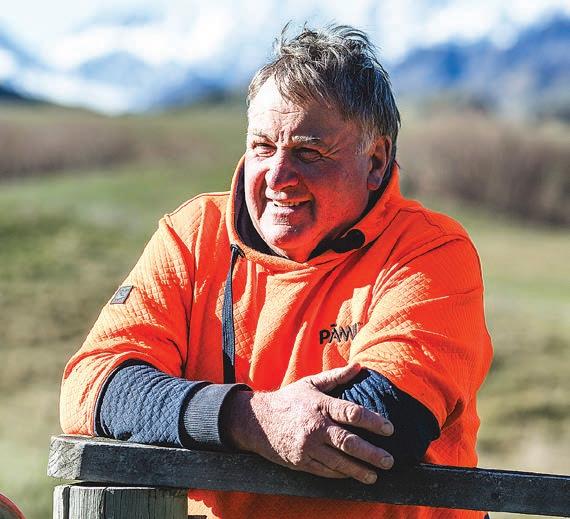


Gerald Piddock NEWS Fonterra
THE Australian Competition and Consumer Commission says it would not oppose French dairy giant Lactalis BSA from purchasing Fonterra’s consumer, dairy ingredients and food service businesses across the Tasman.
Both companies currently get raw milk from dairy farmers in Victoria and Tasmania, as well as processing and supplying a range of dairy products across Australia.
This means Lactalis can proceed with discussions with Fonterra around this potential purchase.
The transaction would combine two of the largest buyers of raw milk in Victoria and lead to some further consolidation in Tasmania, Australian Competition and Consumer Commission (ACCC) deputy chair Mick Keogh said.
station’s presentation and success as a taonga of the country.
With 112 farms across the country, management changes are a natural part of Pāmu’s evolving landscape, he said.
The Wards have left their mark on the station by mentoring numerous young staff and by advocating for the high-country community, Burrett said.
“Jim’s influence has been farreaching. His efforts have been recognised through multiple accolades and awards, reflecting the high regard in which he is held. Jim’s work has helped shape Molesworth Station into what it is today,” Burrett said.
The station is located inland from Blenheim and is surrounded by the inland Kaikōura mountains to the east, the Wairau River to the west, and Hanmer Springs to the south.
It is home to approximately 6000 Angus and Angus-Hereford cross cattle
The station is managed by a team of five permanent staff, supported by additional stockhands during busy periods.
Up to 80 horses and 45 working dogs are involved in seasonal operations.
“While we acknowledge the concerns raised by some representative bodies, after careful consideration we have determined that the acquisition is unlikely to result in a substantial lessening of competition.”
In May 2024, Fonterra announced its intention to divest its consumer, Oceania and Sri Lanka businesses. Its consumer business includes the Anchor, Mainland, Kāpiti, Anlene, Anmum, Fernleaf, Western Star and Perfect Italiano brands.
Its Oceania business includes Fonterra New Zealand and Australia and comprises consumer, foodservice and ingredients businesses.
The divestment is being done either as a trade sale or as an IPO.
However, Australian Dairy Farmers (ADF) president Ben Bennett said the ACCC had left farmers vulnerable in allowing Lactalis’s proposed takeover of Fonterra’s Australian dairy business.
The decision risks further weakening processor competition in Victoria and Tasmania – two of the country’s most critical dairy regions, he said.
“Combining two major buyers reduces choice and bargaining power for farmers. That’s a major threat to farmgate prices, especially in a shrinking milk pool.”
ADF said farmer supply options are already limited, market concentration will grow, reducing competition and that Lactalis has a record of Australian Dairy Code breaches, including a $950,000 fine.
Court-enforceable undertakings to protect farmers are also needed, he said.
“Without enforceable protections, we risk further processor consolidation that hurts farmers and undermines supply security.”



Richard Rennie NEWS Sheep and beef
TRANSFORMING sheepskin into supplements is adding value and opportunities beyond simply sending pelts to landfills across the country.
The decline in sheepskin pelt values has proven problematic for the sector in recent years but Christchurch company Tertiary Extracts Õtautahi (TEO) has found they are a reserve of amino acids extracted as ovine collagen, a valuable health supplement.
Co-founder Dr Rob Kelly, who has spent years developing niche dietary supplements and taking them to market, said he first noticed New Zealand’s absence from the booming collagen supplement market at trade shows.
“There was no NZ presence there. We just don’t operate significantly in that market, yet we have an ample supply of grass-fed, ethically sourced raw materials.”
The global collagen supplement market was estimated to be worth US$6.9 billion in 2024, with
growth projection to US$11bn by 2032 as awareness of its value in improving skin, joint and gut health grows.
For Kelly and his team the breakthrough in extracting it came through their Ovitage proprietary technology. It extracts the collagen and other functional proteins and can be stablised for ingredients use.
It’s a bio-available protein not just good for skin, hair and nails but also for muscle tone, gut health and cognition.
Rob Kelly Tertiary Extracts Õtautahi
“We have a product that contains significantly higher levels of cystine, tyrosine and glutamic acid than traditional bovine or marine collagens.
“It’s a bio-available protein not just good for skin, hair and nails but also for muscle tone, gut health and cognition.”
As demand for collagen grows and Gen Z consumers seek out products with proven provenance
and ethical production methods, Ovitage’s sourcing plays well with the market.
“We are managing to not only close the loop on a key byproduct of the meat industry, but also use it to provide a far more ‘complete’ collagen product from a technical standpoint.
“We can use the entire skin in processing, and get all structural proteins that are in it.”
The Ovitage collagen is the key ingredient in the company’s Everee Women product, designed specifically for women’s health.
The product’s formulations cover peri/post menopause, along with active aging and balanced formulations.
The science behind the product includes three years and $1 million worth of investment in research, focusing on bioavailability, efficacy and delivery formats.
Support from AGMARDT and Callaghan Innovation and a “friends and family” funding round resulted in a dedicated manufacturing plant being opened in Christchurch this year.
“We don’t have the scale in NZ, so it’s important we do the science to differentiate what we offer from the rest of the market.
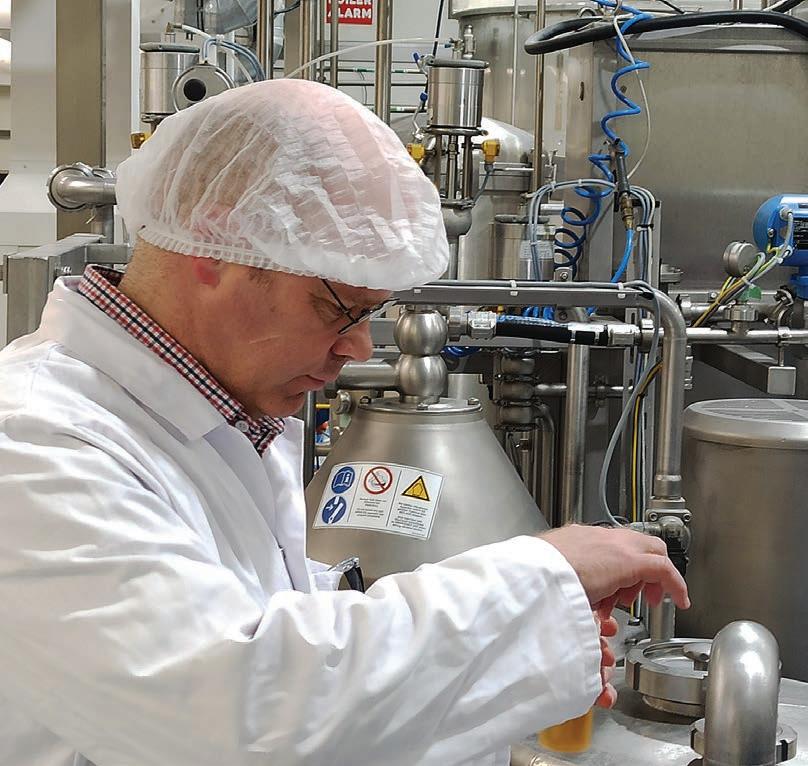
“Meantime we are also adding value to a zero-value material in a way that offers a solution for the entire red meat sector.”
He said the company is getting a positive reception from meat processors keen to be seen to be doing something of value with the problematic byproduct.
Alongside the Everee Women brand the company is developing its ingredients business and Kelly said they have good capacity to sustain future growth.

“We have focused on sheepskins, but have the ability to process cattle skin too.”
Kelly said his company would also be exploring other extractable components in the red meat sector.
“It’s critical we find ways to increase value from these almost valueless products. If we are going to double the sector’s value in 10 years, it can’t come from simply processing and selling more animals.”



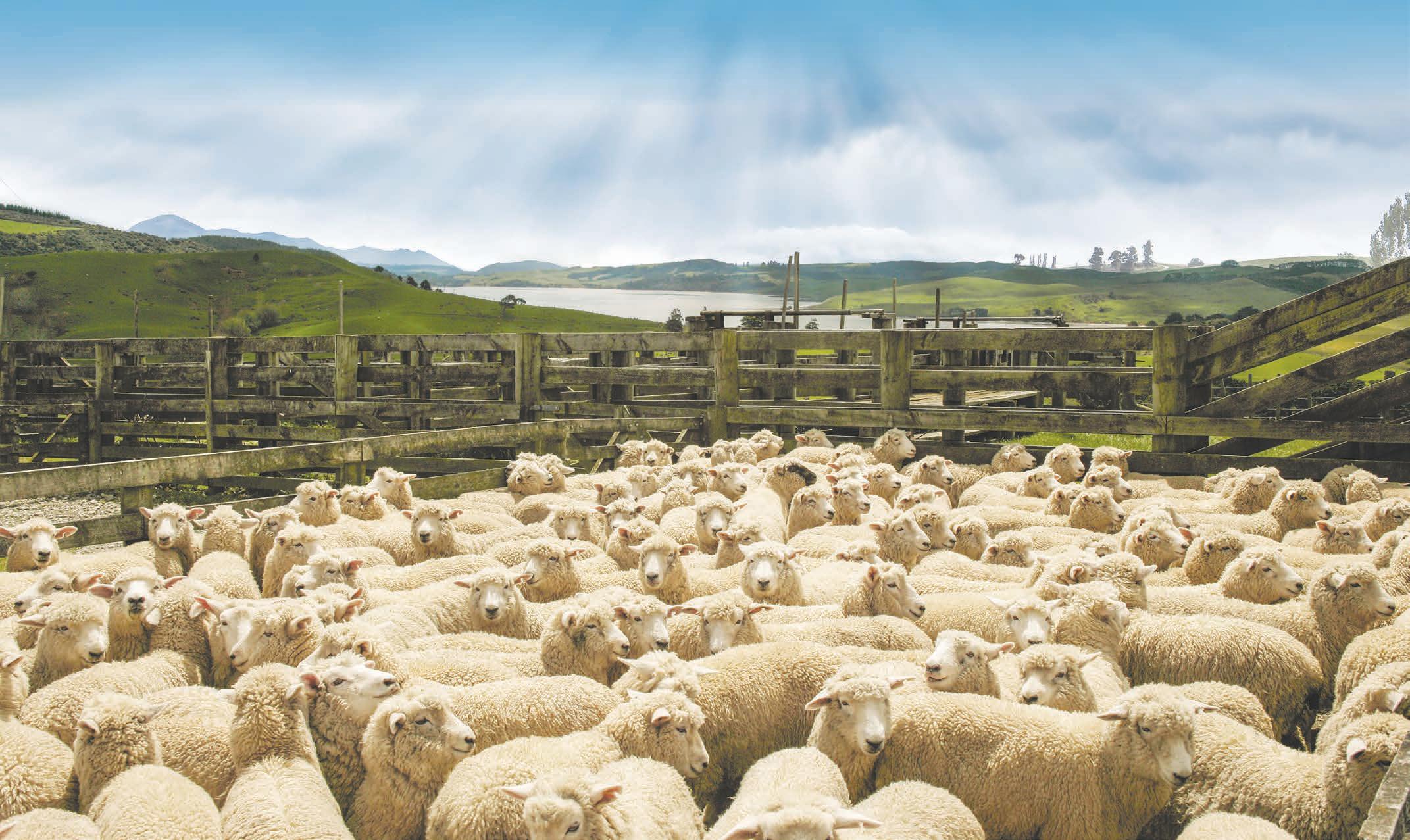

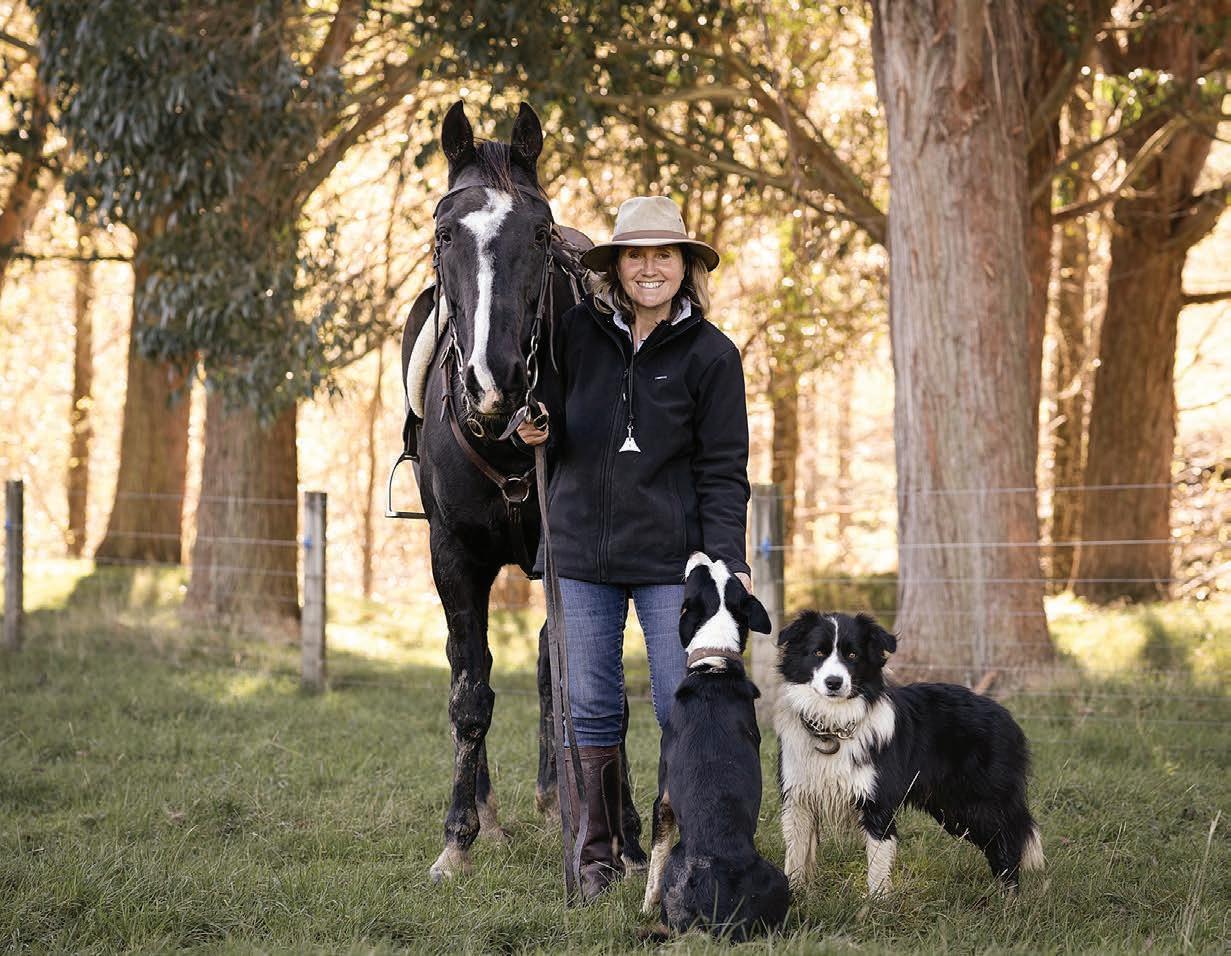

REBECCA Williams has a special talent for capturing farming scenes, but it’s the loyal working dog that she most loves to photograph.
She and her husband Guy farm Highland Station, a hill country sheep and beef breeding and finishing property inland from Matawai, Gisborne. When she’s not farming, Rebecca can be found roaming the hills, camera in hand.
“Guy’s family bought Highland in 1990 as a summer safe block, and in 1997 we were able to take it over in our name. We were really lucky and thankful to get the opportunity. Guy’s family set us up and I have worked on the farm the whole way,” she said.
Originally from Wales, Rebecca met her Kiwi farmer in Israel while they were both travelling. Rebecca wasn’t from a farm – she worked in an office in Cardiff in estate management – but had often spent her school holidays on farms.
Ready for an adventure, she
moved to New Zealand and never left. She has come to love everything about the rural lifestyle, being able to ride horses and the dog work, as well as juggling raising their three children with farm tasks.
She’d always been interested in photography and it was when the children went off to boarding school that she pursued it more seriously, studying towards a diploma online through the Southern Institute of Technology.
Truly early morning light, you can’t beat it. It’s
always worth the early start.
Rebecca Williams Gisborne
“That really spurred me on to have the confidence to go out and go to events and capture some images people were interested in.”
Always learning, Rebecca still attends workshops and participates in online photography challenges.
What she loved most, and


ALLIANCE Group has asked farmers to ensure all plastic baleage wrap and twine is removed from paddocks after feeding out.
In a newsletter the processor says it is seeing an increasing number of cases where wrap is making it through to processing after livestock eat it. At its Mataura plant, key equipment is being blocked and delays caused.
Blockages take up to 35 minutes to clear, with certain machinery needing to be cleaned between every shift to prevent further issues, the processors said.
The commercial manager at plastic recycler Plasback, Neal Shaw, told Farmers Weekly recycling is voluntary and that many farmers still buried or burned their farm plastics, which was against many council rules.
wanted to get good at, was taking dog photos.
“Often farmers don’t think their dogs are worth taking photos of, yet they’re so proud of their dogs. I love the team photos.”
Capturing dog teams has become a pet passion project and every year Rebecca compiles and publishes her popular dog calendar, The Shepherd’s Team.
“I also enjoy landscapes, mobs moving, getting onto someone else’s place and seeing how they run things, capturing the essence.
“I like it when there’s action, something happening, in the yards or stock being moved, when everything is focused on the job, looking natural, not focused on the camera. It’s cliché, but truly early morning light, you can’t beat it. It’s always worth the early start. And the early evening light, when everything has a glow.”
As well as attending events (plenty of bull sale and dog trial content on her Instagram account) Rebecca increasingly shoots for clients who ask her to come on farm and take photos, like breeders wanting catalogue photos.
Photography has been a good fit for Rebecca, as she’s able to fit shoots around farm work.
“It’s my ‘off farm’ thing. It’s a job but not really a job because I love it. I feel like I’m still learning, I learn something every time I go out, and I still enjoy taking photos at home to practice.”
As for the dogs, Rebecca said they are a tool, they do the work, but they’re a companion as well.
“Farmers love their dogs, even if they don’t admit it. I love the fact the dogs love the work. I find it fascinating that people have teams of dogs, I think that’s something quite special and unique to New Zealand.”
She loves the animals, but she equally loves the rural communities. “Rural people are great, aren’t they?”
split about 50/50 between islands. Shaw said bale wrap is manufactured from high quality plastic, but its characteristics make it hard and slow to process, with a low return on investment for processors.
Recycle South closed its Makarewa plant that recycled bale wrap earlier this year for this reason.
Shaw said the plant initially asked farmers $150/tonne to recycle plastic, but had to increase it to $1000/tonne.
The government is currently seeking public feedback on proposed regulations to streamline farm plastic recycling by uniting Agrecovery and Plasback into a single national scheme.
If recycling is mandated there would be a levy but it would still be up to individual farmers to actually recycle, he said.
New Zealand uses over 10,000 tonnes of plastic for bale wrap every year. Progress is being made in recycling, with 2600t of baleage wrap recycled by year end 2021 and 6300t by the end of last year, Shaw said. He said uptake of recycling is
Southland dairy farmer Nigel Johnston said changing the way plastic is managed on the farm is a step towards solving the issue.
“We used to have issues getting plastic out of winter feed paddocks, but now we use a tractor to remove all plastic before we put out bales. We can then clean and recycle it and nothing is left in the paddock.”
NEW Zealand avocado production is expected to see an increase in volumes after a challenging two years, according to a new report by Rabobank.
In its Global Avocado Update 2025, Rabobank says after significant crop losses in 2023 due to Cyclone Gabrielle, New Zealand’s avocado industry saw a strong recovery in the 2024 calendar year.
“Improved growing conditions have supported a rebound in production, and industry sentiment has turned positive,” report co-author RaboResearch senior analyst Jen Corkran said.
“Despite a 17% decline in planted area in 2024, NZ Avocado forecasts a production increase of around 2 million trays (about 11,000 metric tons) for the 2024/25 season compared to 2023/24.”
Corkran said NZ Avocado revised its export strategy for 2025 with the aim of better aligning supply with offshore demand and improving grower returns.
“This strategy revamp appears to have paid dividends in the early months of 2025 with export returns from January to April 2025 rising 162% year-on-year to 2944 metric tonnes, led by a
1366 tonne increase to the key Australian market,” she said. Meanwhile, the report says, the world’s appetite for avocados continues to grow at a rapid rate, with an average annual market value – in terms of consumer prices – now estimated at US$20.5 billion ( NZ$34bn).
RaboResearch senior horticulture analyst David Magana said three main regions represent 88% of this market value – Latin America, North America and Europe.
While Latin America leads global consumption, the market value in the rest of the world is still low (at 12%), he said, presenting opportunities for growth.

RECOVER: Rabobank says after significant crop losses in 2023, New Zealand’s

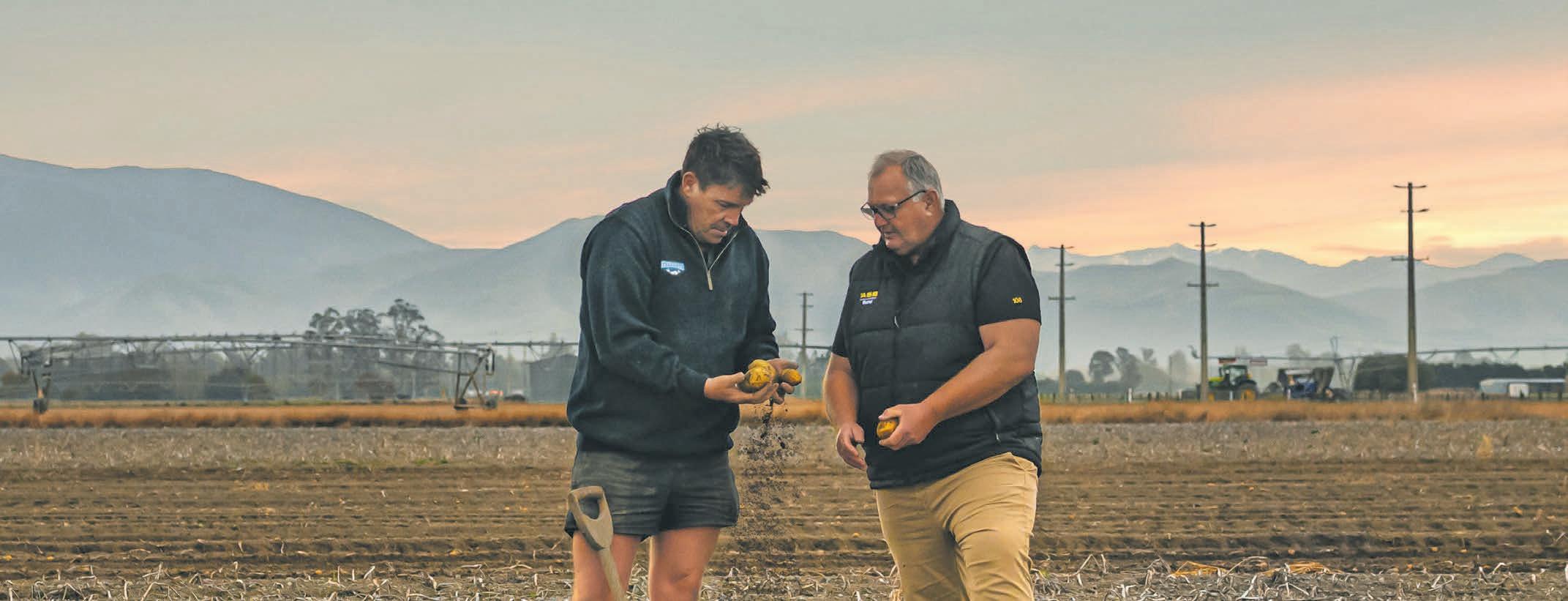





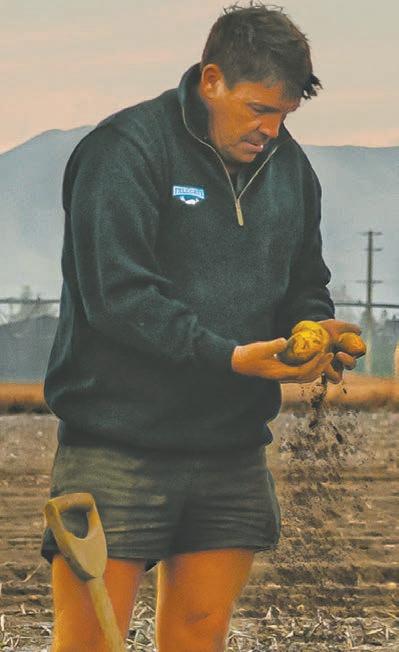




When a major supplier closed its factor y, the Bowan family didn’t just pivot they built their own . Fifteen years on, Hear tland is New Zealand’s only locally owned and operated chip company, with three generations still hands-on from paddock to packet
But there’s one vital ingredient not listed on the packet: ASB. The bank has backed Hear tland through seasonal highs and lows, brand grow th, and business expansion with local bankers who understand farming, cashflow, and ambition .

ASB rural banker Andrew says it ’s about shared ground literally. Born and raised on a farm, he brings deep knowledge of soil types, water schemes, and seasonal risk. “That ’s how you make good decisions together,” he says.
ASB’s suppor t has gone well beyond financing helping consolidate farmland, fund warehousing, and invest in tech like a potato sor ter that ’s improved both efficiency and safety. For a business with deep roots and a bold future, that kind of backing makes all the difference.


THE meeting room was packed with bankers, with others tuned in online from overseas. All up, about 50 people representing Silver Fern Farms’ banking syndicate were waiting for answers on how the meat company was going to address its dire financial position.
It was 2013 and one of Rob Hewett’s first meetings as SFF chair. Here he was, alongside newly appointed independent director Jane Taylor and former chief executive Keith Cooper, staring down the firm’s bankers.
“They were sitting there like birds on a powerline, all lined up,” Hewett recalled.
SFF had accumulated $387 million of debt from several years of financial struggles. Its bankers had run out of patience.
Hewett, who resigned from the SFF board earlier this year after 17 years as a director and 11 as chair, said they had few answers for their bankers.
“In fact we had no idea what we were going to do. We were just buying time,” he said.
Two years later shareholders approved Shanghai Maling buying half of SFF Ltd for $261m, with SFF Co-op owning the other half.
Hewett said the offer exceeded what they expected and was a vote of confidence.
“It validated our brand strategy and everything we were trying to do but didn’t have the horsepower to do.”
Coming from a sixth-generation farming family, Hewet embarked on a corporate career with Shell
after he left Lincoln University. He was in charge of Asia and Pacific logistics for non-fuel-related retail.
His portfolio included $900m in annual cigarette sales.
Significantly, it spurred a lifelong fascination with capturing value through value chains.
With his three children getting older, the decision was made to set down roots, so in 2002 they bought Wainui, a property in South Otago’s Manuka Gorge.
For six years he continued working as a part-time consultant to the retail sector, a role he maintained until his governance career grew.
Hewett has sympathy for the Alliance Group’s current recapitalising challenges.
The key to SFF overcoming its financial issues was the strength of its negotiating team and, when the deal was ready, informing shareholders and selling it to them.
The ace up its sleeve was its value-creating plate-to-pasture marketing strategy, which he said gave SFF products an attributebased point of difference.
It led to the launch of Net Carbon Zero beef and Nature Positive branded products.
“They are differentiable and defendable on a number of metrics.”
Hewett said SFF has been fortunate in having the right chief executive with the right skills for the right time: Keith Cooper, Dean Hamilton, Simon Limmer and now Dan Boulton.
“Each of those individuals was the right guy for the right time.”
During covid, Hewett studied the expanding regenerative movement and concluded that, because New

They were sitting there like birds on a powerline, all lined up.
Rob Hewett Silver Fern Farms
Zealand was already doing much of what the system advocated, it provided NZ food production with a huge opportunity.
“This plays right into our hands. It is about system attribution. It is what SFF is doing and it is also a New Zealand opportunity.”
Hewett said with 80% of the country’s trade going to countries that have or are considering sustainability goals, remaining a

Neal Wallace NEWS Food and fibre
A SHORTAGE of domestic prime cattle has led to domestic food retailers importing record volumes of Australian beef.
Between January and May of this year New Zealand retailers imported 2600 tonnes of Australian beef, according to the Australian Bureau of Statistics. This was up from 1400t for the same period a year earlier.
From July to November last year, 4500t was imported, which was higher than previous years due to a shortage of domestic prime cattle.
Senior AgriHQ analyst Mel Croad said imports usually ramp up over winter but last year’s cattle shortage drove export and domestic buyers into a procurement war.
Croad said there was also a shortage of domestic prime cattle in May-June this year but, given
the high amount of beef already imported and better stock flows, imported volumes may drop off. That, however, depends on the flow of cattle between now and September-October.
Beef + Lamb NZ Inc is responsible for the domestic promotion of beef and lamb.
We’d urge Kiwis to shop around and continue to support local where they can.
Its chief executive, Kit Arkwright, said the recent increase in imported Australian beef reflects lower livestock numbers, land use changes, seasonal supply constraints during winter, and greater exports given the improved trade access to Europe, particularly for prime beef.
This has prompted some retailers
to supplement domestic beef supplies with Australian beef.
“It’s encouraging that retailers are maintaining consumer choice during this period,” said Arkwright.
“We’d urge Kiwis to shop around and continue to support local where they can.”
Arkwright said if NZ consumers choose to try Australian beef, “we hope it delivers an experience on par with what they know and expect from New Zealand beef”.
Woolworths New Zealand said it is committed to stocking 100% New Zealand fresh beef through winter, as it did last year.
Woolworths New Zealand’s general manager of meat, James Miles, said it is not easy to source beef at the moment.
“There’s huge international demand for top-quality New Zealand meat, which is great news for our farmers, but it also means supply is tight and as a local retailer we’re getting big price increases on beef and lamb.
signatory to the Paris Accord on climate change is crucial.
He estimates export prices would fall by up to 20% should NZ exit Paris, due to the loss of premiumpaying markets and becoming a weaker seller.
As for issues facing the meat industry, Hewett said excess processing capacity especially in the South Island needs to be addressed.
“Nobody is dealing with the elephant in the room,” he said, noting SFF and Alliance have closed multiple plants.
Given the many challenges facing the export food industry, Hewett has instigated a primary sector group called Tacking Through the Headwinds.
It involves senior leaders from the various sectors discussing and finding common approaches and solutions to issues such as trade disruption.
While optimistic there will always be demand for red meat, Hewett includes a caveat that growers need to provide consumers with reasons to buy it through their values and product attributes.
Hewett currently chairs eight companies and is a director on one other. He said he enjoys governance roles.
“I enjoy it and I’ve been fortunate to be involved in companies that did good stuff that is meaningful and with people I enjoy working with.”

“Not many people are aware of this, but we have procurement managers in-house at Woolworths and they work directly with our beef and lamb farmers to buy meat at a price that’s sustainable for farmers, and good for our customers.
“We’re the only grocery
retailer to do this and our direct relationships with over 1000 farmers across the country are what’s made this commitment possible.”
Woolworths customers buy
190,000 kg of beef every week with mince, sirloin and scotch fillet steak being the most popular.
John Connell’s award-winning books draw on his experience of returning to the family farm in Ireland. He talks to Farmstrong about the life lessons he learnt in the day-to-day routines of farming.

farmstrong.co.nz
IT’S not easy to describe Irishman John Connell in a few words. He’s a very successful author, a journalist, a documentary producer, wellbeing ambassador and a man in love with farming. His debut book, which spent 37 weeks in the Irish book charts and won the Best Non-Fiction Book Award in Ireland, is The Cow Book.
“It’s the story of a young man coming back to work on the family farm after a bad time,” Connell said. “And it’s the story of me and my dad working together and coming to understand each other better. Ultimately, it’s a story of family farming and the ties that unite us all.”
Connell, who was a guest speaker at this year’s Featherston Booktown, runs a medium-sized farm in County Longford, in the midlands of Ireland. He returned to the family farm after living a very different life in Sydney and Toronto for more than a decade.
“I’ve really enjoyed getting back to a simpler life as a farmer. Farming is the bedrock of my days now,” he said.

He has a sheep flock, yearling heifers and bullocks “which are maturing nicely and the price is really good at the moment”, he’s pleased to say.
“It’s the best it’s been in years. There’s actually a shortage of livestock right now, of cattle and sheep, so the prices went up. Even the weather is good, making up for a bad summer last year. Farming people are in a good mood here at the moment.”
For Connell, farming is not just an enjoyable way of life. It has also been a lifeline, a path to restoring his health mentally and physically. When he was living an intense, busy life in big cities, he suffered bouts of depression and, later on, the publishing success of The Cow Book led to burnout.
It was in the simple rhythms and regular routines of farming that he found his way back to good health.
Connell can identify a number of factors that helped him on that journey. He enjoys being his own boss and the flexibility that being a farmer brings.
“As a farmer, I have more time for myself, more time to be in nature. Just today, for example, I had a million things to do but I went up and was looking at the cattle, and the horses and the sheep and I just felt relaxed.
“We converted to organic farming a couple of years ago and I’ve been interested to see the impact of that on the farm. I was up on the hill farm a couple of weeks ago and there was a pair of nesting hawks which I’d never seen before. There are things like that you notice.
“We have a river on the farm and I like fishing. The mayflies are up at the moment. There is a whole little world there.
“I’ve become good mates with our family vet, and he’s a fisherman so we catch up and have a chat.”
Slowing down is a key part of maintaining mental health, he said.
“I know that slowing down is not possible all the time, but you have

to take the opportunity when you can.
“There was a time there when I ran myself into the ground. The Cow Book had come out and was a big success and I was travelling all over the world and I just ended up being chewed up a bit.
To be a modern farmer is to know when to ask for help.
John
“I said to myself, I’m a farmer. Go back to farming and nature. I’m going to put the computer away, not write for a while. I had this idea to buy 12 sheep and just follow them over a lambing season and keep a diary of it. That’s what I did and that’s how the book Twelve Sheep came about.
“There’s always pressure and bills and paying your mortgage and all that kind of stuff. It can be a real challenge to slow down but it’s important.”
Exercise is also fundamental to a sense of wellbeing, said Connell.
“I was someone who didn’t exercise in my 20s. Now I cycle and run with my buddies and do triathlons.
“Some days are really busy, but you have to find an hour for yourself to do it. For me, even if I am having a lousy day, it picks me up. I go for a run and it shakes out any annoyance or bad feeling and I feel centred again.”
Having a network of friends is really key to a good mental outlook, said Connell. He looks back to when he lived in Toronto

and he didn’t have friends as he had previously had when he lived in Sydney.
“That’s when my mental health took a dip, when I had no one to turn to.”
It’s different now. As well as his local friends, and friends who are coming home to Ireland, he keeps in touch with friends he has made round the world through WhatsApp.
“I have a list of friends on WhatsApp who I talk to once a week or once every two weeks, and it’s free. I have mates in Australia, mates in America, mates in different parts of Ireland who I ring up for a good chin-wag.
“This technology wasn’t available to previous generations. It’s meant I have been able to maintain close friendships that I probably would have lost.”
Connell is well-placed to write about mental wellbeing and to be a motivational speaker on the subject. He speaks from experience.
“I haven’t suffered from depression for over a decade. I put that down to the way I have lived my life – the exercise, the eating right, the network of friends, going to bed on time, things like that. A steady regular routine has helped a lot.
“I’m very proud that I have been able to look after my own mental health and help other people to talk about it. Conversations about mental health have become more normalised. When that happens, people aren’t afraid to ask for help.
Thirty or forty years ago, it was a taboo subject.
“To be a modern farmer is to know when to ask for help. That’s
why the Farmstrong initiative which you have in New Zealand is so important. It’s not a sign of weakness to ask for help. It’s the sign of an intelligent person who knows that maybe this thing is a little too big for me and I need to talk to somebody about it.”
The issues faced by farmers in New Zealand are the same as those in Ireland, said Connell.
Rural isolation and the loneliness that can go with it are issues that need to be dealt with positively by getting people involved in community. The Five Ways to Wellbeing promoted by Farmstrong are great, he said. They focus on what it takes to make yourself mentally stronger.
“New Zealand and Ireland are similar places. Farming is very central to our societies. I’ve been in America a few times and you tell someone you’re a farmer and you may as well say you are an astronaut. They have no concept of what’s involved.
“But in rural communities like Ireland and New Zealand, farming is part of the bedrock of who we are. We have to look out for our farmers because if there are no farmers, there is no food and if there is no food, there is nothing!”
Farmstrong is nationwide, rural wellbeing programme that helps farmers and growers to manage the ups and downs of the industry. Last year more than 15,000 farmers and growers attributed an increase in their wellbeing to the programme. For free farmer-to-farmer tools and resources, head to www.farmstrong.co.nz

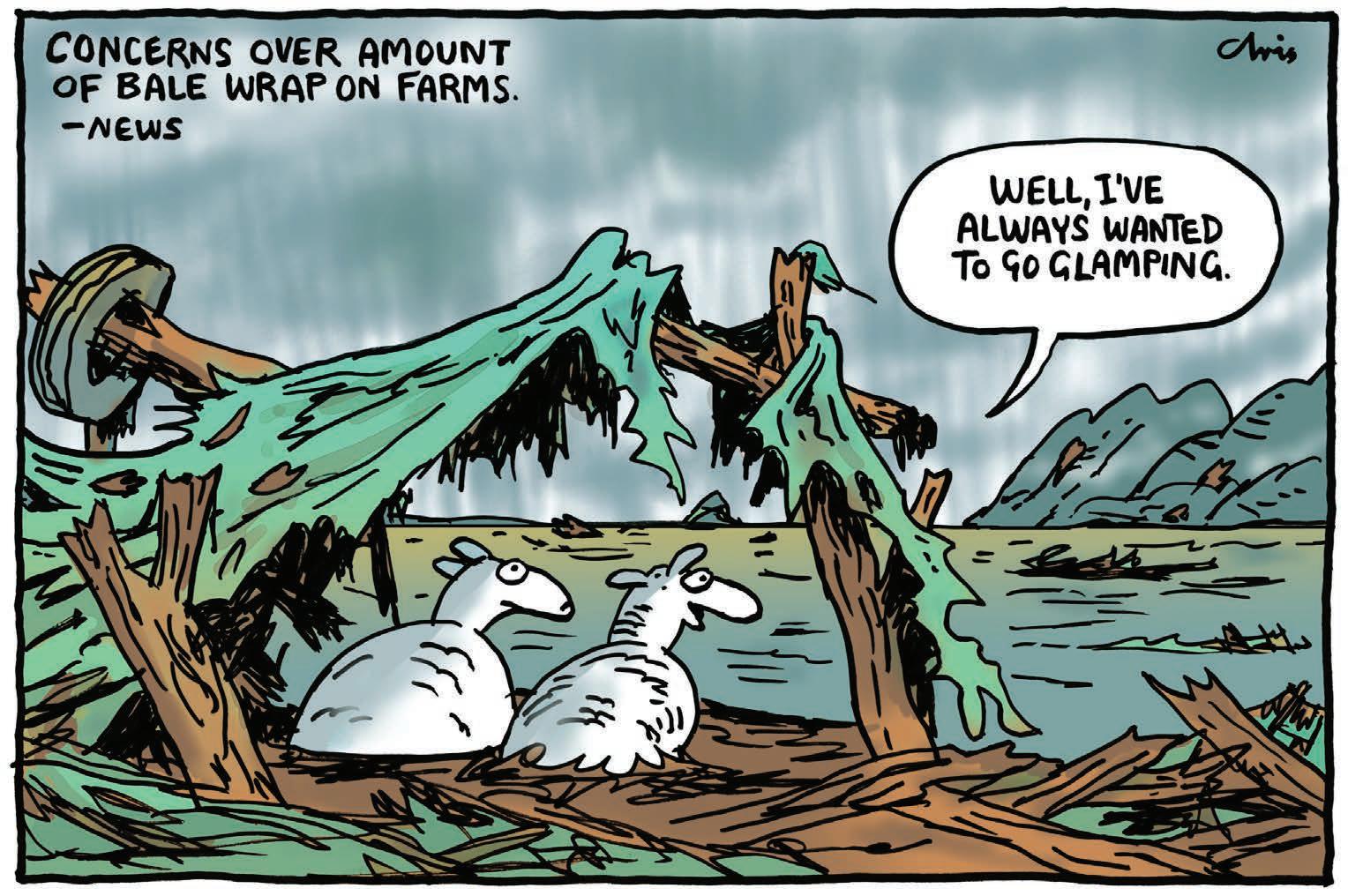
When a brand’s good name is at stake

Neal Wallace Senior reporter
IN 2017 United Airlines saw its market value drop by $2.34 billion after cellphone footage of a passenger being manhandled from one of its planes went viral.
The airline needed the seats to ensure its crew made their next flight, but one of the four passengers asked to make room had refused.
That passenger was carried from the plane unconscious after the violent incident with security staff. Viewers of the footage were outraged.
United then compounded the problem with its response, which many saw as disingenuous and shrouded in corporate waffle.
The days of half-baked responses to issues that could harm an organisation are over and, thankfully, the New Zealand
This week’s poll question (see page 5):
Do you think central government contributes enough to help rural communities recover from extreme weather events?
Have your say at farmersweekly.co.nz/poll
Merino Company (NZM), faced with its own brand-damaging video, understands this.
As we report this week, NZM has introduced new standards that its ZQ accredited fine wool suppliers must meet to comply with the quality assurance programme.
Those standards include unannounced spot checks when stock are being handled, more training and a trial of accredited in-shed animal welfare officers or in-shed cameras.
This response follows the publication of unfavourable video footage, covertly gathered last year by a supporter of the animal welfare group PETA and released to the media.
For several months he or she filmed shearers and shed hands working in ZQ accredited sheds and documented actions that raised animal welfare concerns.
These claims could have been dismissed as anomalies – that the alleged perpetrators were having a bad day, that the footage was taken out of context or that this was just another attack by PETA, which rallies against sheep being shorn.
But that is irrelevant. NZ Merino’s reputation, built up over 39 years, was under threat and could have suffered irreparable harm.
NZM has successfully built its brand and reputation, and that of the NZ Merino wool
industry, on the quality of its fibre, coming from free-range sheep that enjoy the highest standards of animal welfare. It had to act, but it is not alone.
Greenpeace repeatedly attacks the use of palm kernel extract (PKE) by NZ dairy farmers in a campaign to stop land being cleared for the planting of oil palm trees.
PKE is a byproduct of palm oil and farmers could justifiably argue that Greenpeace would be better targeting the primary users, food and cosmetic producers, manufacturers of cleaning agents and biofuel.
Greenpeace knows that the risk to the reputation of dairy companies from being associated with deforestation and threatening native wildlife is a powerful tool to help it achieve its ultimate goal.
Given the ag sector’s dependence on livestock farming, we are at risk from campaigns by groups who oppose animal farming.
Fortunately there are others, like the SPCA, who accept the farming of animals with controls, and contribute to a more realistic animal welfare benchmark we can usually all live with.
Threatening a reputation is a frustrating and often unfair tactic based on the unachievable assumption that every farm practice will be perfect all of the time.
It also once again highlights the enormous power of social media.
Almost all voters thought that food products should state if they have been genetically modified. Most said that consumers are entitled to know what they are eating, and some even thought that if livestock feed is genetically modified, that too should be stated on the animal proteins sold.
“This is so important and I am horrified to think this might be covered up. What damage that would do to the reputation of New Zealand products. I just think of all my overseas friends who constantly talk about the clean, green image and Pure New Zealand, which has been a tremendous marketing tool and is getting more and more important.”
Another issue highlighted was the growing concern in export markets.
“Our markets want it. Why wouldn’t we be transparent about everything in our food? Are we trying to hide something from our customers? Not a good look.”
Of the small number who didn’t see a problem, several pointed to what they saw as an overstatement of possible health effects. “Food labelling for GMOs should be voluntary so the rest of us don’t have to pay for anti-GM paranoia.”
Andrew Luddington Christchurch
SUPERB from Patricia Hosking in her letter “The last generation” (July 14), in which she deals with the line “Climate change is not an existential threat to our children.” She uses respect and decency whilst not withholding the punches.
We are in trouble. Since the Industrial Revolution we have gone too far, too hard and now we realise that we have to put on the brakes or suffer dire consequence. And it is happening already. We only need to go to Nelson right now or the glaciers on the West Coast to see it.
We can listen to men like Donald Trump, who has surrounded himself with sycophants telling him what he wants to hear, not what he needs to hear. Or Elon Musk, who promises to take the billionaires to Mars once this planet has become unliveable whilst failing to address the root cause of the problem and thus bringing it along with them.
Or Groundswell, who are calling on us to leave the Paris Agreement.
Or we can get on top of this job. A bit of sacrifice, to find a way, so that the next generation can receive an inheritance of stability and not one resulting from boneheaded stupidity and all-out greed.
Best letter WINS a quality Victorinox Hiker Knife

Send your letter to the Editor at Farmers Weekly P.0. Box 529, Feilding or email us at farmers.weekly@agrihq.co.nz
Last week’s question:
Do you think all food products should state on the label whether they have been genetically modified?
In this series, the regular Eating the Elephant contributors ask big questions of four farming New Zealanders with a history of taking on big challenges.
LINDY Nelson has touched the lives of thousands of food and farming New Zealanders – particularly women – over the years. As the founder of the Agri Women’s Development Trust, she built an organisation around her personal philosophies – that diversity is our sector’s strength, everyone belongs and no one gets left behind.
She has been rightly recognised for this work, as a Member of the New Zealand Order of Merit for services to agriculture and women, among other titles and awards. In 2020 she took on a new role as the chair of Safer farms NZ, spearheading the Farm without Harm strategy to make sure every farming Kiwi makes it home.
To listen and learn from Lindy, her podcast series Amplifying Us is a place for raw and real conversations about women’s leadership.
Why did you choose a life in food and fibre?
I met, fell in love with and married my sheep and beef farmer. The sector, in effect, chose me.
But I fell in love with it. Living and working in a community and understanding our combined challenges, aspirations, impact on the world and contribution to NZ
have kept me here. Agriculture is the oldest “culture” in our human history, developed when man put down roots and started to grow food. It sustains all human life on this planet and its future is in our hands. Preserving this and enhancing the success of the people who live and work in agriculture has become my life’s mission.
What are you most proud of and why?
Being prepared to take on challenges and find new ways of solving these. Starting without knowing the answers but committed to a vision of better, whether that was building a new hospital for our district when closure was eminent, changing women’s participation in leadership and their farming businesses through the AWDT, or now finding new ways solve the human harm that can occur through farming.
I have lived my life believing the following quote from anthropologist Margaret Mead: “Never doubt that a small group of thoughtful, committed individuals can change the world. In fact, it’s the only thing that ever has.”
I have seen the effect of working with others to identify, solve and create change. This is the strength
of both rural communities and our agri sector. We are doers, problem solvers and innovators.
What is something unusual about yourself that you love?
My courage and persistence. Courage gets you started. It’s the energy to do something knowing you can fail, but being prepared to try anyway. I have a belief that it is better to fail because you tried, rather than fail because you did not. Persistence is the backbone to courage, it keeps you going through the obstacles.
What is the best investment that you’ve ever made (time, money, energy, product etcetera)?
Investing in learning and development. I self-funded the research for the AWDT. I had looked at doing a Master’s degree but couldn’t see how it would give me the answers I was seeking. Instead, Kelloggs gave me the “permission” and support to keep going with the research and it gave me the network of people I needed to take the leap.
Two of my fellow Kelloggers became my first trustees. That research created the AWDT “product”, which in turn created more learning and research opportunities for me. That next

bout of learning took me to the APEC stage in Papua New Guinea and elsewhere.
What advice would you give to a young person today?
Your personal skills will take you further than your professional skills. Invest in them.
What is the biggest thing that makes you optimistic for the future?
Our ability to build communities to solve any challenge.
What is the biggest thing that makes you pessimistic for the future?
Our lack of tolerance and true connection to one another.
DIVERSITY: Founder of the Agri Women’s Development Trust Lindy Nelson has built an organisation around her philosophies that diversity is the sector’s strength, everyone belongs and no one gets left behind.
Your personal skills will take you further than your professional skills. Invest in them.
What will the food and fibre sector of 2040 look like?
Probably not much different in terms of how we are growing food and fibre.
Of course there will be system changes and adaptations, but I feel we will grow meat, wool and milk pretty much the same as we have for centuries.
I hope we are doing so without harm to ourselves and the environment.
Second-year Lincoln University agribusiness students were asked to write an opinion piece about their field tour, rather than the usual report. We’re publishing some of our favourites over the coming weeks.
Mitchell Gilmore Lincoln University student
‘
LAST year took the fun out of farming.”
So said farm manager Ross Bowmar, describing the recent drought.
And it was just one of the many challenges he has faced over the past six years, since returning to his wife Jess’s family farm, Redcliffs Station, in 2019.
Welcome to high country farming in Canterbury.
I have always had great admiration for farmers, but as we departed Redcliffs down the shingle road running next to the Rakaia River, I found a new level of respect for their resilience and determination to find a way around every obstacle thrown at them.

In a world where climate change is causing havoc with weather patterns, it is no longer a matter of who is the strongest in the farming world, but who is the most adaptable and resilient.
Since 2019, the couple have been hit with multiple severe floods, one of them a one-in-200year event, followed by droughts, followed by more floods ... There seemed to be a pattern emerging.
Listening to Ross talk about
What do we want to do to still be here in 10 years?
these events, I thought, why are they still here? Why haven’t they sold up? Have they not learnt the hard way yet? Surely this would be a better option?
Instead, Ross and Jess decided to dig in, not just physically but
also mentally. They were faced with difficult decisions: to feed the stock up around the house, to sacrifice some paddocks to save others, to run the cows on the riverbed, making use of natural resources.
There is a difference between panic and performance under pressure. This was performance under pressure at its very finest. It made me ask myself, would I do it the same way?
Resilience is a word that Redcliffs Station lives by. The soil on the property, fine, windblown and pallic, is the kind of soil that struggles without rain. So, Ross had to add organic matter to it, which has allowed them to drill crops such as lucerne into the soil.
They have made many calculated investments, such as buying soil probes so Ross can check the soil moisture levels. They have also invested in in K-Line irrigation, enough to cover 85ha, so if droughts hit again, they at least have a small portion of the farm that can be irrigated.
An interesting addition to the farm is a glamping setup tucked onto the corner of a peninsula that overlooks the Rakaia River. It was introduced to increase cash flow and has done just that.
The occupancy rate of 8590% makes it a reliable income
stream. A second glamping set up is already in the works to help smooth out the boom and bust of farm income.
The wool from the Merino sheep on the farm goes directly from the farm to Icebreaker, with which they have a 10-year rolling contract. The contract involves animal welfare and wool checks such as pain relief, strong fibres, good colour and 75-95mm cuts of fine wool. This requires precise management.
From visiting Ross and Jess’s farm Redcliffs Station, I learnt as a young and upcoming farmer that I am going to need to learn how to be resilient. It may mean I have to wake up in a drought, or flood, or it may be having to watch $50,000 disappear on feed for the animals due to Mother Nature providing challenges.
And it could even be asking myself a hard question: not “What do we want to do now?” but “What do we want to do to still be here in 10 years?”
I learnt what high country sheep and beef farming really looks like up close. A good mix of science, tradition and a whole bunch of courage and resilience.

DESCRIPTION
FARMERS WEEKLY ANNUAL VOLUNTARY SUBSCRIPTION
1. We’ll keep Farmers Weekly posted to you and every farmer, every week.
2. You’ll continue to get your comprehensive bundle of information; News, opinion, on farm stories, sector coverage, market insights, real estate, marketplace, livestock and weather.
3. The Farmers Weekly team is first class. They’re upcoming and veteran journalists with invaluable experience and institutional knowledge. Let’s work together to keep that capability.
4. We’ll continue to support the farming community in every way we can.
5. The paper and website combine to give you all the farming industry news that matters.
6. You, and every farmer, are kept right up to date with Federated Farmers and other sector advocate activities.
7. Farmers Weekly informs with curated, thoughtful news that is chosen to be insightful, not to enrage. You don’t get clickbait.
8. Our journalists hold your political and industry leaders to account.
9. The jokes are mostly funny.
10. Digital might be cheaper, but for most of us, the newspaper is still perfect with smoko.
11. Most of the team here at Farmers Weekly are farming or off farms. We care as much as you do. 1
See below for payment options. Thank you!
Your 100% voluntary subscription helps ensure rural New Zealand stays informed, connected, and never left out of the conversation.
farmersweekly.co.nz/donate | 0800 85 25 80 | voluntarysub@farmersweekly.co.nz

Start your voluntary annual subscription today. $120 for 12 months. This is a voluntary subscription for you, a rural letterbox-holder already receiving Farmers Weekly every week, free, and for those who read us online.
Choose from the following three options:
Scan the QR code or go to www.farmersweekly.co.nz/donate
Email your name, postal address and phone number to: voluntarysub@farmersweekly.co.nz and we’ll send you an invoice.
Call us on 0800 85 25 80
Note: A GST receipt will be provided for all voluntary subscriptions.


GREAT colostrum management and strong animal health policies have helped Jo Earwaker grow healthy replacement calves on the 400 hectare dairy farm she runs with husband Michael.
Jo, who trained as a veterinarian, rears 250 spring-born calves every year on their 1050-cow farm near Pirongia, and credits her system for keeping the calves healthy and disease free in their early stages of life.
She outlined that system at an on-farm field day organised by the Smaller Milk and Supply Herds group.
When calving starts in July, all of the animals are collected by them or their four staff with bobbies and non-replacements kept in a separate shed to their rearing shed and sold as four-day-old calves.
The
biggest thing I ever did was that I started vaccinating my herd for
rotavirus.
Jo Earwaker Pirongia
The shed has seven pens capable of holding 22 calves each with a maximum capacity of 150 calves. It has a woodchip floor for bedding that is replaced every two years. The calves are unloaded from the trailer. They are navel sprayed and examined, and any that are looking cold and miserable are given first aid when they arrive. They are also given a Multimin trace element injection.

Jo then leaves them for an hour to settle before feeding them warm colostrum from a bottle.
She feeds her calves once a day in the afternoon, feeding the animals as much colostrum milk as they want to drink for their first two to three feeds.
After that, they are each fed around four litres a day using a plastic compartmental feeder. Colostrum from the herd is stored in a 900L vat and is used for rearing along with some whole milk.
Jo also is a big believer in the use of probiotics for improved gut health. She also uses anti-inflammatory Metacam medication for any calf looking “off”, she says.
She tries to make sure these weaker-looking calves are properly fed and will check them again after three hours and give them electrolytes if required to help reduce dehydration and acidosis.
Jo used to have a lot of health issues with the calves in the shed including cryptosporidiosis four to five years ago, E coli and rotovirus.
“The last four years I have had no scours and for the last two years I have not lost a single calf.” It is difficult to pinpoint
whether it was the probiotics, the vaccinations or just learning each year and getting better, she said.
“The biggest thing I ever did was that I started vaccinating my herd for rotavirus. That was a huge turning point for scours for us.”
This is done five weeks before calving with a Rotavec injection. It is expensive, but makes up for the cost in peace of mind.
“The year I had crypto [cryptosporidiosis] go through my shed, it cost me $9000 and that doesn’t include the heifer calves I lost as well. It’s a no-brainer for me.”
But good colostrum management is still required, she said.
“The biggest thing it does is that local immunity. While that Rotoavec milk is floating around in the calf’s gut, it’s providing extra protection.”
The other big change she made was to her colostrum management and being very pedantic about keeping her colostrum storage buckets as clean as possible.
Jo also never puts time pressure on herself to feed the calves because it comes back to bite the next day if corners are cut.
“It takes the time that it takes. If I’m going to spend an extra five minutes in here, handfeeding a calf from a bottle, I know tomorrow I won’t be kicking myself thinking why didn’t I do that.”
After two weeks, the calves leave the pen and are shifted outside where there are eight dedicated calf paddocks.
They are run in mobs of 55-60 and are fed on an 80-teat feeder once a day as well as calf meal.
After three weeks the calves are brought back in and are given an oral worm drench, which is repeated every three weeks. At five weeks the animals are given a 5 in 1 vaccination. By the second drench the calves are also weighed, allowing Jo to start drafting the calves via weight. This helps her judge when to wean the calves off milk, which is at 85kg. She also wants the calf mob to be eating at least two bags of meal a day and have a well-rounded stomach, evident of a good working rumen.
The calves are then weaned off the meal at 100kg and are ready to go off farm.

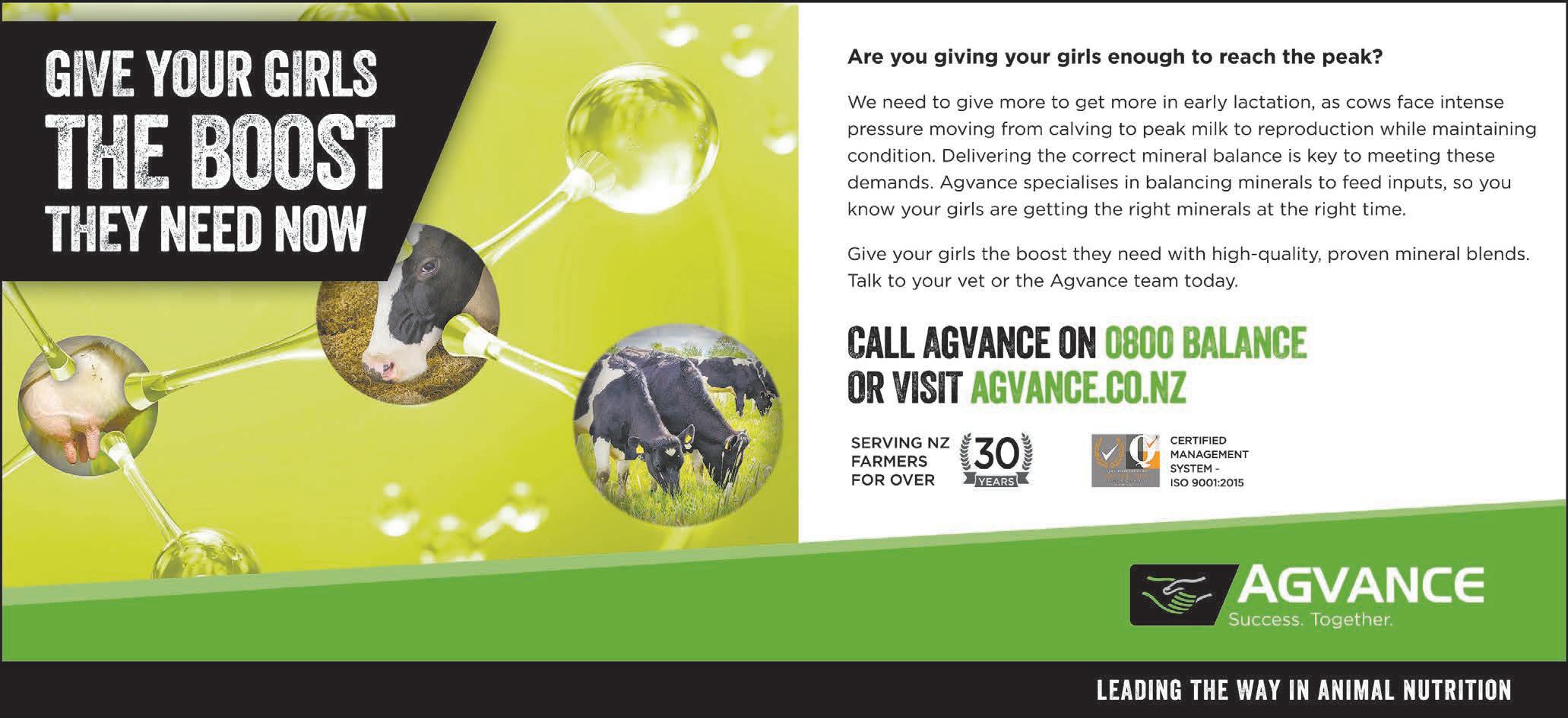

Richard Rennie TECHNOLOGY Dairy
RESULTS from work done by leading dairy researcher Dr Scott McDougall and his Waikato team have found a simple lever for dairy farmers to pull to improve their herd’s reproductive performance.
The research results just published in the international peer-reviewed Journal of Dairy Science are based off the study of 1550 non-cycling dairy cows in 11 herds.
The study compared reproductive outcomes resulting from treating one group with the commonly used progesterone and OvSynch programme, versus also administering a prostaglandin injection prior to the progesterone and OvSynch programme.
“Basically, what we achieved by adding in a single ‘pre-synchrony’ prostaglandin injection up front at the start of the programme to treat anoestrus cows was a 5% lift
in the 6-week in-calf rate.
“It worked remarkably well and has certainly proven to be cost effective,” McDougall said.
Without any hormone treatment prior to the planned start of mating, anoestrus cows typically take several weeks longer to get in calf.
Nationally the challenge for New Zealand’s dairy sector has been to lift its 6-week in-calf rate, with DairyNZ’s InCalf targeting 78%.
Last season’s data indicates the sector achieved a record high of 70%, up 2.7 percentage points from the year before.
The challenge with existing treatment programmes comes with the treated cows all falling across all stages of the oestrus cycle when they start the programme. This means only about 50% will ovulate following the start of the treatment, resulting in lower conception rates.
The use of “pre-synchrony” has been well researched in the United States, but using programmes with multiple injections prior to breeding.
“We have known about presynchrony programmes being used in large herds in the United States where milking is all year round.
“But these systems did not fit with NZ’s seasonal focused mating programmes. They were too complex, and time frames did not work. We needed something that was simpler and easily administered.
“We hypothesised that presynchrony using a single prostaglandin injection before the progesterone programme started would increase conception rate in these anoestrus cows.”
The use of a prostaglandin injection prior to the treatment programme would “line up” cows’ oestrus cycles together for a more predictable, better, fertility outcome.
The trials results proved the programme can increase the proportion of cows likely to ovulate after their first hormone treatment and be in calf at weeks three or six by five percentage points, compared to those not injected pre-programme.
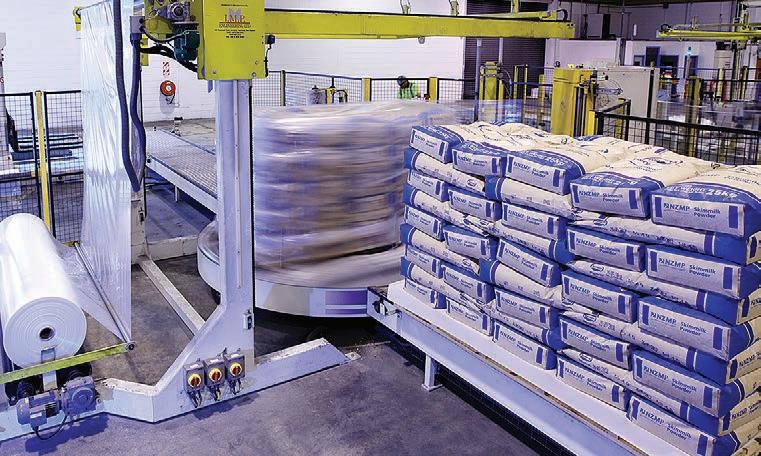

Hugh Stringleman MARKETS Dairy
PRICES on the Global Dairy Trade platform rose slightly in last week’s auction after two months of downwards movements in four consecutive auctions totalling 7%.
In the second July auction the GDT price index rose 1.1% under the influence of whole milk powder prices, up 1.7%, and skim milk powder, up 2.5%.
lead for SMP, anhydrous milk fat, and cheddar,” she said.
“Cheddar was the notable underperformer, dropping 5.6% across all contracts. With the United States continuing to supply cheddar robustly into the global market, this result was in line with expectations.”
AMF prices rose 0.8% while butter prices were unchanged. Lactose was down 1.5% and mozzarella 0.7%.
BOOSTED: Dr Scott McDougall’s team’s research has highlighted the value of a pre-synchrony injection to lift a herd’s incalf outcome, and deliver an additional $4.50 per cow profit on average.


The approach is recognised as a novel world first and McDougall said the returns to farmers are measurable in revenue terms.
“Total cost for a 435-cow herd was $1000, with a total benefit of $2940, or a net value of $1930 per herd.”
But this also had significant variance, ranging from $650 to $7604.
McDougall said it was still too early to say definitively that the use of pre-synchrony programmes had contributed to this year’s lift in national 6-week in-calf rates.
“But vets have been aware of it and there has been a level of national uptake. It has been widely adopted by farmers within our practice.”
The auction confirmed that solid demand remains in place, particularly in the forward curve.
Cristina Alvarado NZX
NZX head of dairy Cristina Alvarado said the buying power came from southeast Asia/ Oceania where the overall share of GDT purchases rose by 25% to 34% in total alongside the north Asia region at 35%.
“North Asia remained the top buyer of WMP and butter, while southeast Asia/Oceania took the
Alvarado noted various supply influences beginning to be felt, including very dry weather in Europe and the renewed 30% tariff threat on the European Union from the US.
“These add another layer of uncertainty to forward supply and trade dynamics.
“With the New Zealand season just beginning and these GDT contracts aligned to peak spring deliveries, the auction confirmed that solid demand remains in place, particularly in the forward curve, despite current global volatility.”
Dairy commodity prices are still historically high, despite the two months of GDT price falls, and farmgate milk price predictions around $10/kg milksolids remain firm.
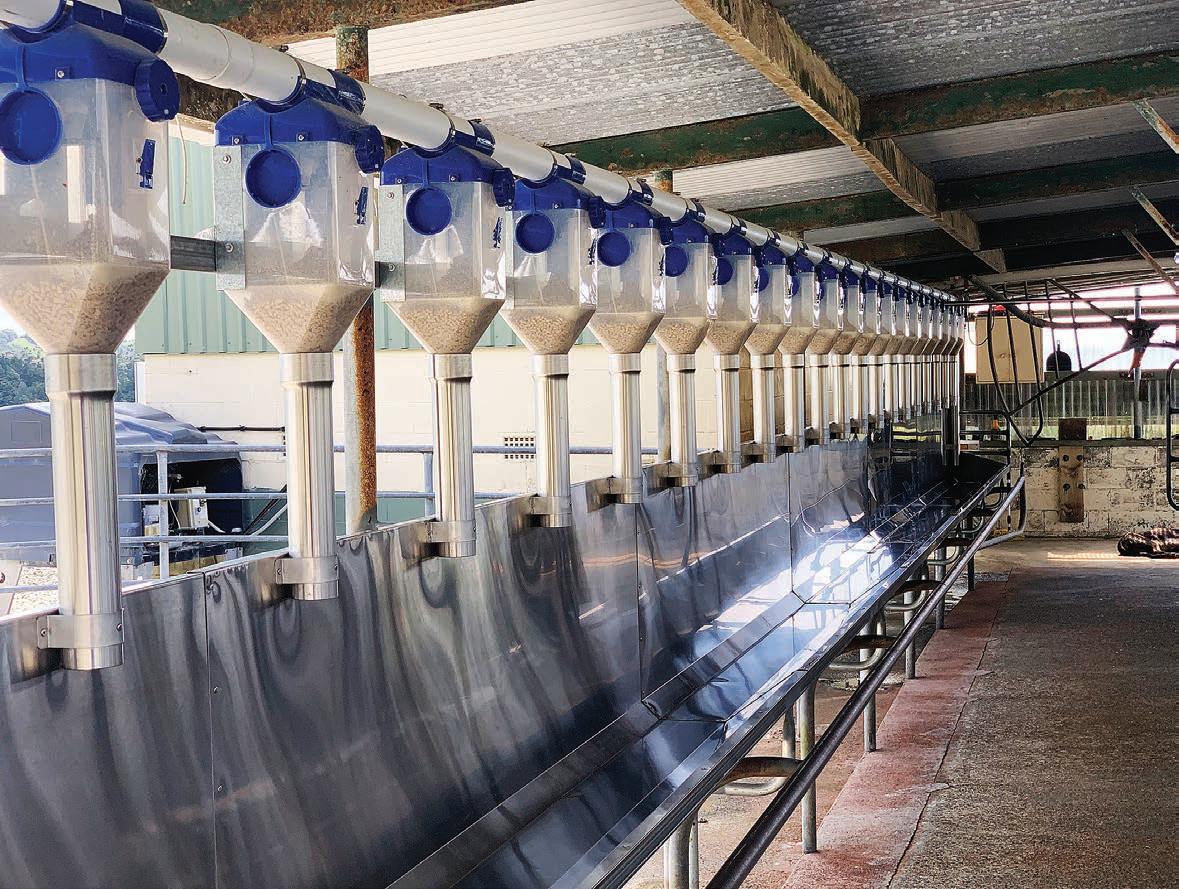


Gerald Piddock NEWS Animal welfare
MASSEY University researchers are beginning a project to determine if ultrasound technology can be used to remove horn buds from dairy calves.
The project, which received funding from the Ministry of Business, Innovation and Employment’s Endeavour Fund, will take this from being an idea into a proof of concept.
It will be led by Dr Preet Singh, who will spend the next two to three years establishing that proof for what will be a world-first technique if successful.
Disbudding is a common practice in the dairy industry, preventing animals from injuring others, themselves or farm staff
and avoiding entanglement in equipment.
The industry currently disbuds a calf’s horns using hot irons, with local aesthetic, and Singh has been researching alternatives to this practice for the past five to six years.
The current method often provides insufficient pain relief during healing and can result in long-term complications.
Singh came across research papers where focused ultrasound was used successfully in nonsurgical cancer treatments for people.
“We thought, that’s a good idea.”
It is hoped that these ultrasound waves will target and destroy the cells responsible for horn growth.
“The research is about whether we can use ultrasound to do that.
“The device developed for this
project will focus on a small area, automatically scanning to complete the procedure quickly and effectively without affecting surrounding cells.
“This approach will provide a humane and highly effective alternative to the traditional method,” he said.
Horn-producing cells are located on the calf’s skull and only a thin bone separates them from the brain.
Making sure the ultrasound waves are precise and targeted so other important cells are not harmed will be one big challenge.
Discovering the best scanning frequency and the duration for using the ultrasound is another, he said.
By precisely targeting hornproducing cells and using lower temperatures, the method should reduce pain and minimise damage to surrounding tissue.

This approach will provide a humane and highly effective alternative to the traditional method.
Dr Preet Singh Massey University
While the initial application is focused on improving disbudding practices, the technology has the potential for broader use in veterinary medicine and even
ULTRASOUND:
Massey
University’s Dr Preet Singh will lead a project to see whether ultrasound can be used to disbud calves.
tumour treatment in animals and humans.
Singh hopes the project will improve animal welfare and reinforce New Zealand’s position as a global leader in sustainable and ethical dairy practices.
“Around 2 million calves are disbudded in New Zealand each year. By improving a practice within such a vital industry, we can not only advance animal welfare but also strengthen our international reputation for innovation, sustainability and care in agriculture.”
CALIFORNIA-based Tamarack Biotics has secured United States Food and Drug Administration acceptance for using UV light technology to treat raw milk.
Tamarack’s TruActive process uses advanced UV light technology to eliminate harmful pathogens while preserving the enzymes, proteins and immunity-supporting compounds that are often destroyed by traditional heatbased pasteurisation.
The result is a scientifically verified, safe, raw milk equivalent – a first in the dairy industry, the company said in a statement on its website.
It said this is not simply another

method of pasteurisation, which has been normalised with its heat-based treatment for decades.
“Tamarack Biotic’s light-focusing treatment preserves the taste and creaminess of raw milk, which a
Set your farm up for a successful season with support from Farm Source. We’ve got proven products, the latest insights and practical advice to help your farming business thrive.
growing number of people have rediscovered.”
Tamarack Biotics CEO Bob Comstock said safe treatment of milk hasn’t fundamentally changed in over 150 years.
“We’ve created a solution that
brings raw milk safety into the 21st century, without sacrificing what makes milk truly nutritious.
Our UV process actually achieves a greater level of safety than thermal pasteurisation, which is truly remarkable.”
The FDA’s decision confirmed that Tamarack’s method meets the official efficacy criteria for pasteurisation, allowing it to initially be used in the production of powdered dairy ingredients such as whey protein concentrate, milk protein concentrate and immunesupporting compounds like lactoferrin.
Tamarack has already started expanding TruActive to other dairy products such as cheese, yoghurt, kefir and colostrum.
These steps pave the way for acceptance of TruActive treatment
of liquid raw milk as early as 2027.
A University of California Davis clinical trial demonstrated that a milk protein concentrate treated with the TruActive process restores immune function in aging populations.
Additionally, many European studies have proved that raw milk consumption protects children from developing allergies such as asthma, eczema and food allergies. Tamarack’s light-based system delivers the compounds believed responsible for allergy protection with none of the risks associated with unpasteurised dairy.
Tamarack Biotics is a food technology company developing science-backed, non-thermal methods to safely treat milk without compromising natural health benefits.



Richard Rennie TECHNOLOGY Livestock
COW condition scoring, one of the most subjective but vital tasks on a dairy farm to help assess herd health, has been given an artificial intelligence boost with the launch of the Herd-i body condition scoring system.
With an AI “brain” trained by viewing over a million video images of cows and more than 40,000 real-world body condition scores (BCS) collected from farms, the system takes the variability out of individual farmers’ assessments and tracks changes over time.
Herd-i was launched at Fieldays and comes on the heels of the company’s lameness detection system, which has been on the market for several years.
CEO Liz Muller said after talking to dozens of farmers about BCS significance, almost every farmer
had noted how difficult it is to get consistency in BCS.
“Artificial intelligence allows us to absolutely remove the inconsistency and give result consistency. Every time those cows go through the milking shed they get a score.”
Every
time those cows go through the
milking
shed they get a score.
Liz Muller Herd-i
The hardware for the system includes a high-quality camera –or two, if the lameness assessment system is also opted for.
“It’s off the shelf, good quality tech, but pretty simple. All of the smarts are in the algorithms and what is happening behind the scenes.”
As the system collects and stores the herd’s daily BCS data, it enables the farmer to track, and
manage any declines they may see.
The system’s AI includes a strong human input when being trained.
“Certified BCS assessors go on farm and score all the cows and then we match them to video images it captures of those cows.”
The system now has 20,000 cows in its BCS model calibration data set. On farm calibration is done twice, matched to high quality videos taken seven days before and seven days after the physical BCS is taken of each herd member.
Beyond the farm gate, Muller said, there is also emerging opportunity to combine the Herd-i data with the massive pools of other on-farm data now being generated by AI-driven systems.
“Here at Fieldays there has been a lot of conversations about data integration. The challenge for NZ dairy farmers is about managing data. Farmers have not yet seen the tsunami of data coming their way.

“This is a big challenge and a big opportunity for the dairy industry. If we want to protect and enhance the industry, this is going to become important to us.”
She said there is now genuine willingness among companies to share data.
DATA
CEO Liz
says
farmers are about to face a tsunami of data generated by artificial intelligence-driven systems, including Herd-i’s body condition scoring system.
The next stage of Herd-i’s massive data pool is predictive modelling.
“Farmers have said to me, if you can make an algorithm that will make a better drying-off decision (for example) than I can make, then that is something that is really valuable to me.”
HOMEGROWN:
DairyNZ head of data science and modelling Mark Neal says the key to emissions efficiency is to focus on homegrown feed.
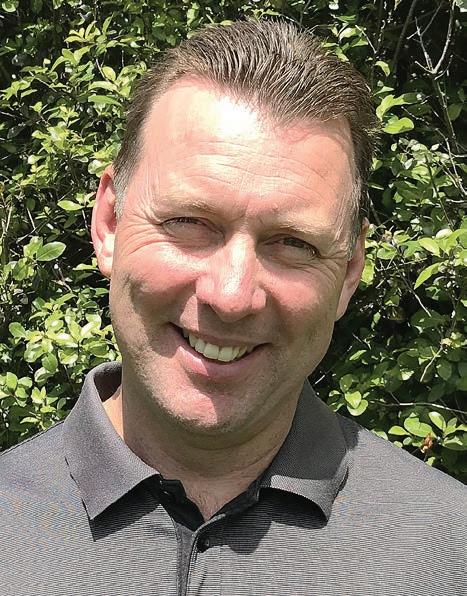

A NEW study has found there is no link between emissions efficiency and profitability on New Zealand dairy farms.
DairyNZ looked at data from its own Dairybase, Fonterra and LIC and discovered every farm system in every region could reduce emissions while maintaining profitability.
The study answers the question of whether pursuing emissions efficiency would adversely affect other farm business goals, something many farmers worry about.
DairyNZ head of data science and modelling Mark Neal said the key was
to focus on homegrown feed.
“With the Fonterra emissions calculations, it’s a life cycle approach, which means that different feeds have a different footprint,” he told the Farmers Weekly Podcast
“There are feeds that have lower embedded emissions – like pasture and pasture silage.
“And then some have a higher embedded emissions – we’re talking about palm kernel and soybean, that come from overseas.”
Neal said it didn’t matter what farm system they looked at, with low and high intensity systems equally able to find a sweet spot that hit the dual targets of profitability and emissions intensity.
“Across those systems you can
find a range of high profit and low emissions intensity farms. Before we did the study, I would have thought I would have seen more of a difference, but I did not.
“It comes down to the footprint of the feeds you’re using, and how well are you are performing on that homegrown pasture metric.”
Knowing your numbers is the first step in being able to improve efficiency, Neal said.
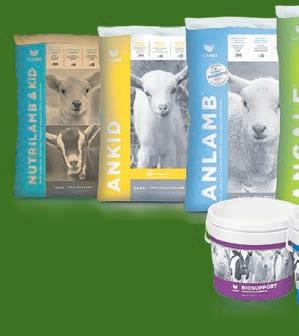
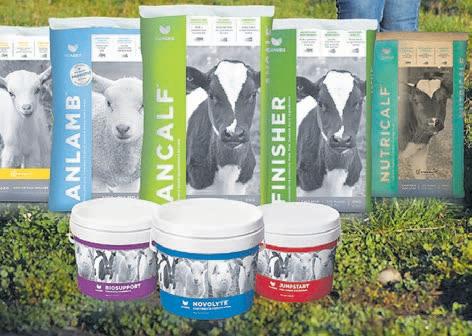
farmersweekly.co.nz/podcasts


Gerald Piddock TECHNOLOGY Animal welfare
WORK is underway at Massey University to create a 30-minute bovine mastitis diagnosis test for the dairy industry, after it recently received $1 million from the Ministry of Business, Innovation and Employment’s Endeavour Fund.
Professor in Microbiology Jasna Rakonjac will lead a team of global experts to develop a rapid, highly sensitive and specific on-farm test for diagnosing mastitis.
The project is being undertaken in partnership with Koru Biotech. Together, they are combining microbiological, immunological and biotechnology expertise to create a test that distinguishes between the common bacterial groups causing bovine mastitis.
This will allow farmers and veterinarians to make fast, accurate treatment decisions in the milking shed.
Mastitis is a condition that affects a million animals annually in New Zealand and current diagnostic tests to identify its cause can take between 24 and 48 hours, often leading to antibiotic overuse and financial losses due to delays in treatment and ineffective screening.
Rakonjac said that improving the speed and accuracy of diagnosis could save the sector $33m annually in antibiotic use alone.
“The overall cost of mastitis is around $150 per animal, so the numbers add up quickly. With faster, targeted treatment, we can reduce disease spread, improve recovery and lower antibiotic use, helping profitability while also meeting growing consumer demand for sustainable dairy practices.”
The new equipment-free technology is designed to be easy to use and affordable, with potential for wider applications across veterinary, medical and environmental fields. Its use could significantly reduce the amount of antibiotics entering the environment and help combat the growing global issue of antibiotic resistance.
The test is most likely to be based on using a milk sample from the cow that would then be tested for the presence of specific microbes.
The results will indicate to the farmer the type of bacteria that is present, guiding the treatment decisions.
The test could also be done during milking when the cow is stationary, and the farmer is able to observe any cows that possibly have sub-clinical mastitis and can take the sample.
“It will be a very quick test, and
NEW artificial intelligence-driven technology is helping a Waikato organic dairy farmer improve udder health on his 250-cow farm, he says.
Dedicated to producing
high-quality organic milk, Michael Vosper installed GEA’s iSprayvision walkover teat sprayer, and said he has seen fewer cases of mastitis and better udder health, and has saved time in the dairy shed.
The Vospers are fifth-generation farmers and owners of the awardwinning Jersey Girl Organics, a

family-run organic dairy milk processing business.
Vosper has continued the family legacy, milking 250 cows on his organic farm in Manawaru, near Te Aroha in the Waikato region.
Vosper chose the GEA equipment for its advanced AI camera technology and cost-effective teat spraying. Within six months, he said, he saw better results in herd udder health and the teat care routine became much more efficient.
“Since the installation, our cell count has dropped by 100,000.
“Our mastitis cases have also dropped compared to this time last year, and teat condition has improved.”
Alongside udder health benefits, the technology has streamlined Vosper’s milking routine. He’s now saving 30 minutes each milking, which allows him to reallocate staff to other on-farm tasks.
“Cow flow is better because they just walk straight out. No one’s
With faster, targeted treatment, we can reduce disease spread, improve recovery and lower antibiotic use.
Prof Jasna Rakonjac Massey University
it will recognise things that are signalling that there are microbes there either at the moment or have recently been there.”
Rakonjac hopes the test will be as fast and simple as the rapid antigen tests used for covid-19.
Rakonjac hopes to have a prototype finished in two years’ time.
“It’s a high-risk project, but we do have preliminary data that this could work. It’s sort of like a trip to Mount Everest and we are very enthusiastic.”

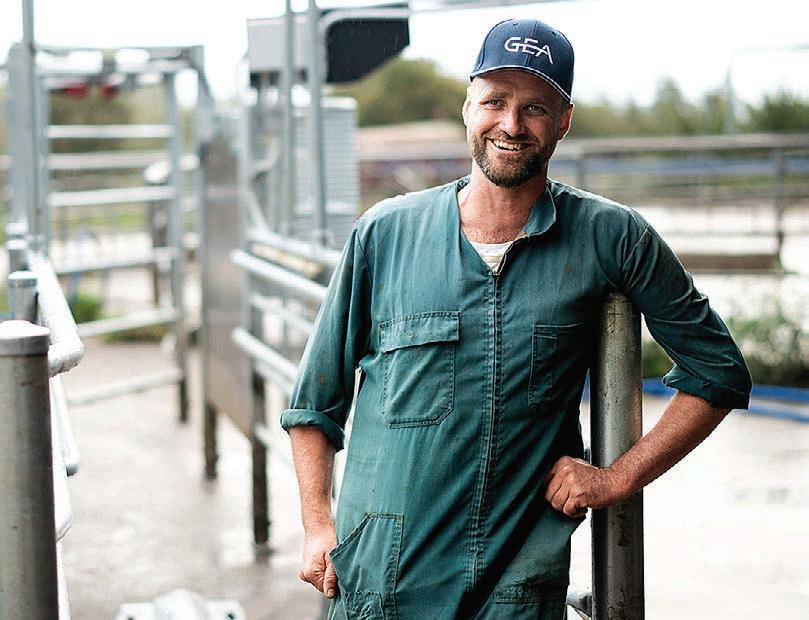
touching or spraying them in the shed.”
As the cows exit the dairy, they walk over the spray unit in the exit race where the teat spray is applied. To further automate the routine, Vosper installed the FIL Intelliblend in early 2025. This system automatically mixes teat spray to the correct ratios and
delivers it to the sprayer.
With the two systems working in tandem, Vosper is confident his cows are receiving the correct amount of teat spray and complete coverage of the teats.
Looking ahead, Vosper’s goals for the 25/26 season is to reduce cases of mastitis and lower somatic cell count to below 150,000.


JULY, as the second month of the New Zealand dairy season, typically passes with a low profile while milk production gradually builds toward the peak spring months. However, weather conditions and a shifting global political and economic backdrop have kept the dairy industry alert.
Of particular note are the latest tariff announcements from United States President Donald Trump, which have reignited concerns over trade disruptions.
While some measures are currently on pause, they are expected to bring mixed sentiment to the
market and will be closely watched in the weeks ahead.
New Zealand’s May milk production closed the 2024/25 season on a high, with milksolids up 8.0% year on year (YoY) to a record 104,120,000kg. This brought the full season’s total to a 3.0% increase in milksolids.
Late autumn conditions in the South Island proved favourable, with pasture growth significantly above average, helping to extend the milking season. In contrast, many North Island farms dried off early due to drought, particularly in Waikato.
Globally, milk production trends in May were mixed. The US reported a modest 1.4% YoY increase, while Argentina and Uruguay recorded stronger gains of 14.1% and 11.1% respectively.
Australia saw a -3.8% decline, as poor weather hampered output across several key states.
In Europe, April milk production rose by 1.2% YoY, pointing to some recovery following a slow start to the year. China, meanwhile, reported a further -4.1% YoY decline in domestic milk production for May, reflecting persistent supply pressures.
GDT auctions followed the seasonal softening trend in July, though results were mixed. Event 383 saw the index drop by -4.1%, led by a -5.1% fall in whole milk powder (WMP), -4.3% in butter, -4.2% in anhydrous milk fat (AMF), and -1.7% in skim milk powder
(SMP). Event 384 showed a modest lift of 1.1%, led by increases in SMP (+2.5%), WMP (+1.7%) and AMF (+0.8%).
Despite these fluctuations, average prices for most products remain well above levels seen at the same time last year, offering some reassurance to farmers and market participants.
Export activity continues to reflect firm commodity pricing, although volume trends have varied by region. In May, New Zealand’s dairy export volumes fell -2.6% YoY, while export value rose 11.6%.
China’s dairy imports lifted 2.0% by volume and 8.3% by value in May, reflecting ongoing demand despite economic headwinds.
The US saw April export volumes fall -5.5% YoY, though export value rose 4.2%.
Australia posted a 3.6% volume lift with a 9.1% increase in value, while Argentina recorded a 7.6% gain in export volumes and a 13.5% rise in value. In the European Union, April dairy export volumes dropped -4.0%, though export value rose 8.4%.
New Zealand enters this season in a stronger position than it did a year ago, with confidence buoyed by a solid end to last season and a firm opening forecast for the farmgate milk price. However, the evolving global trade landscape introduces a new layer of uncertainty.
Trump’s “Liberation Day”

Many of the countries targeted are key markets for New Zealand dairy exports.
announcements earlier in the year briefly paused some shipments and had traders on high alert. While tariffs remain on hold until August, the potential for broader impact remains.
Many of the countries targeted – such as China, Indonesia, Malaysia, Thailand and Vietnam –are key markets for New Zealand
dairy exports. Should major tariffs be imposed, demand could be disrupted if consumers face higher food costs amid wider economic pressures.
For now, we watch and wait. Continued negotiations and diplomatic efforts are hoped for, in the interests of maintaining stable trade flows and avoiding unnecessary shocks to the global economy – or to dairy prices.
With heatwaves continuing to put pressure on European milk production, there should still be solid demand and placement for New Zealand dairy while the US continues efforts to lift its output.

Gerhard Uys NEWS Animal welfare
THE dairy industry needs to support the development of a lowstress cow handling course, says a researcher.
Waikato based agri-business consultant Mandi Mcleod has been awarded a scholarship by the
University of Queensland to study the relationship between dairy cow handling, human and animal injuries, productivity, welfare and sustainability.
Poor cow flow can be frustrating and lead to injuries or lost time –both costly, McLeod said.
The attention that farmers and the media are giving to technology that attempts to





replace poor handling, such as virtual fencing and backing gate management systems, highlights the frustration the industry has with dairy cow handling, she said.
The Animal Welfare Act places a lot of emphasis on animal handling, yet New Zealand has no official avenue for training on cow handling, she said.
As part of her research, a survey asks farmers about cow flow, where there is opportunity for better stock handling on farms, who benefits from better handling and how training can be delivered.
McLeod said she hoped that targeted low-stress cow handling courses can be developed in New Zealand.

In New Zealand, Annexa, Safer Farms and a2Milk support her research, she said.
In Australia, Lactalis, a2MC, South Australia Dairy Industry, EastAusMilk and the University of Tasmania supported her.
McLeod said researchers need support from processors and industry bodies who have a wide reach.












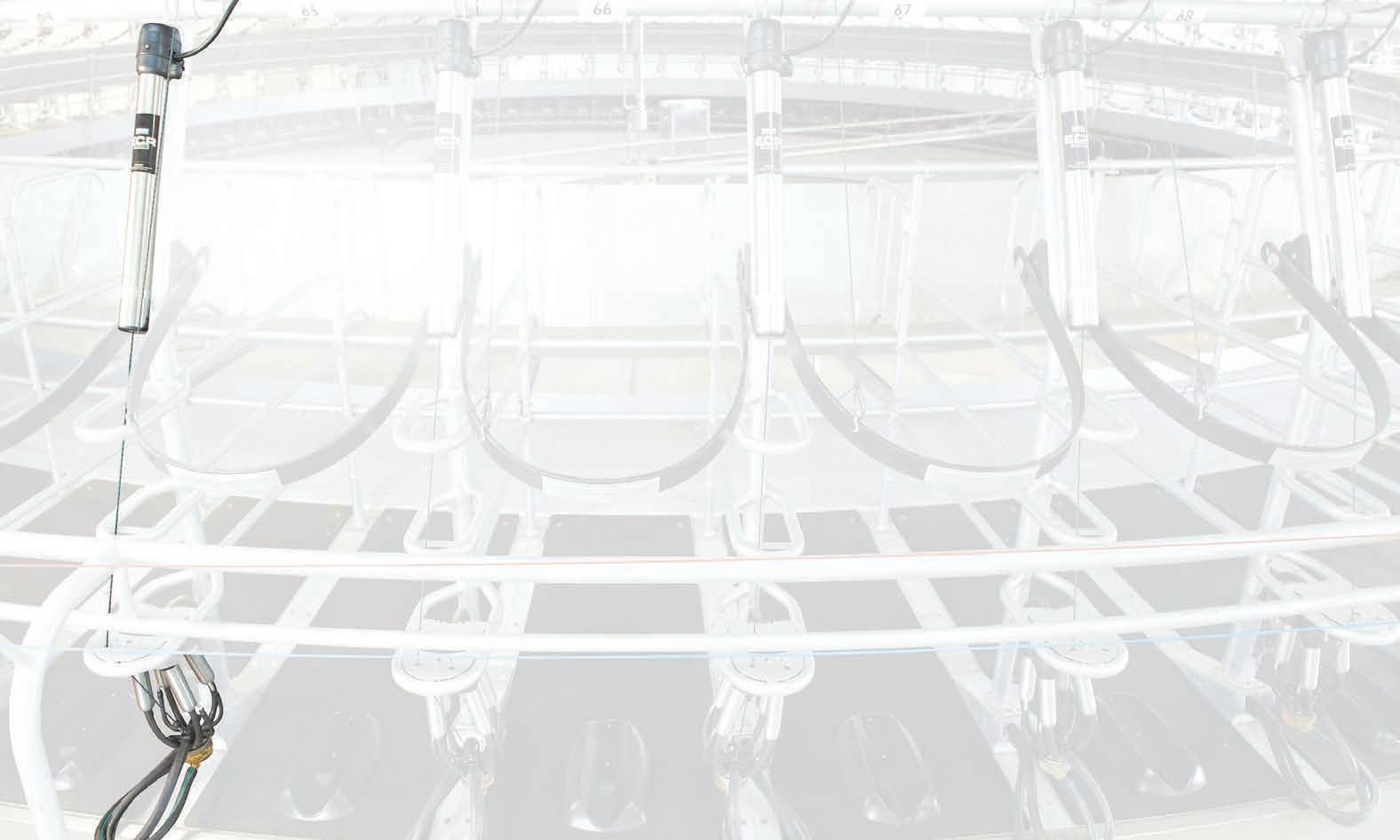

Tracy Brown Brown is chair of DairyNZ
AS DECISIONS around freshwater rules edge closer, the message from dairy farmers is clear. Farmers want – and DairyNZ is strongly advocating for – sensible rules that provide certainty, a focus on ecosystem and human health outcomes rather than just strict nutrient numbers, support for catchment groups and practical mitigations, and policy settings that enable
both environmental progress and the future of our dairy sector.
Thank you to everyone who has joined our webinars, spoken with us at catchment meetings, or sent in your views. Your input is important as the first phase of the government’s freshwater consultation wraps up at the end of July and DairyNZ prepares its submission. Another opportunity will come later this year – likely October – when we see the first draft of the new rules.
What I’m hearing from those I talk with is that without a doubt, dairy remains a valued and valuable sector critical to New Zealand’s future economic success – with more enabling policy a shared interest between DairyNZ and the government.
The government’s proposals include updates to Te Mana o te Wai, simpler wetland rules, a review of nitrogen limits, and more flexible ways to set freshwater objectives.
These changes could reduce red tape, but only if they result in rules that are practical and workable on farm. We support the consultation process and the goal of improving freshwater policy, but we are advocating for change that reflects
on-farm realities and builds confidence for the future.
We support a shift away from rigid numerical limits. Instead, we want to see greater focus on ecosystem and human health outcomes. We support better use of tools like certified and audited Freshwater Farm Plans. More enabling rules around constructed wetlands is another priority.
The dairy sector is investing heavily in science-backed solutions to reduce its environmental footprint, including nitrogen, phosphorus and sediment losses.
Proven practices like using plantain, catch crops, good farming practices and stacked mitigations through Low N Systems are already delivering results, such as the potential for nitrate reductions of up to 60%, with further gains possible with supportive policy.
These efforts show the sector’s strong commitment to improving freshwater quality while remaining economically viable.
DairyNZ has spent the past year preparing to provide a workable replacement to the existing policy.
Our team has developed an alternative freshwater framework
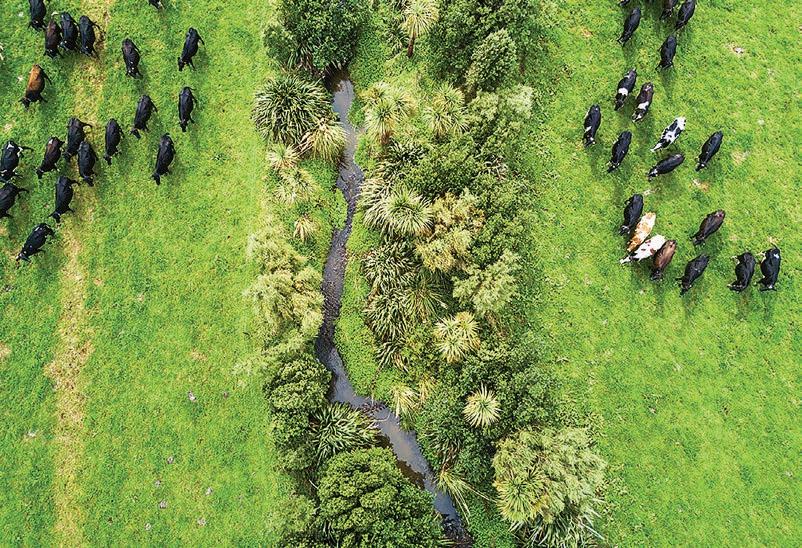
to support a constructive, scienceled response.
We are pushing for four key outcomes: practical, sciencebased rules; clearer focus on environmental and human health; farmer-led, catchmentscale solutions that reward good practice; and a policy package trusted by farmers, communities and markets.
Beyond freshwater, we are involved in the wider Resource Management Act reform, where we have concerns. We’ve submitted on both recent Amendment Bills and the Fast-Track Approvals Bill, calling for enduring and enabling policy settings with pragmatic consenting pathways. We are also working with
regional councils to ensure the pause on new freshwater plans is used to improve, not shelve, the evidence base for environmental limits.
We know that right now, many of you are doing your best to interpret complex rules while managing the day-to-day realities of farming. And with calving underway or around the corner, it’s all hands on deck.
In the meantime, keep doing the basics well: record nitrogen use, keep stock out of waterways, and implement your Freshwater Farm Plan. Together, we can ensure the next generation of policy supports both a thriving dairy sector and a healthy environment. Thank you for everything you do.

Your future herd needs all the help it can get to go from good to great Calf Max with its high starch content is just what a calf needs to energise rumen microbes and develop the rumen to ensure good nutrients in grass can be utilised So max out where it counts with Calf M ax.































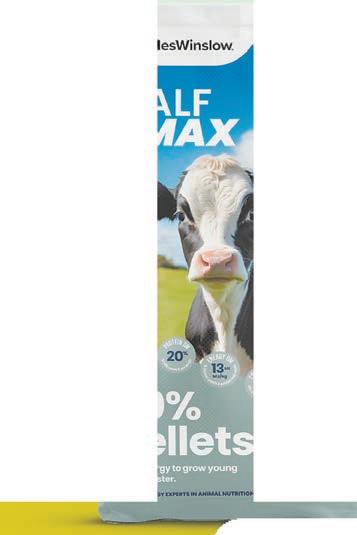



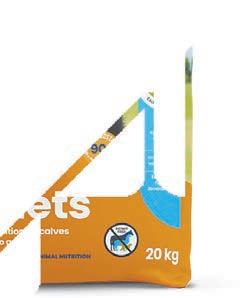









COGNITION: The a2 Milk Companyfunded work showed that daily consumption of A2 milk was beneficial to a broad range of cognitive measures among its elderly test subjects.
Photo: Pexels


Gerald Piddock NEWS Dairy
NEW research from Australia supports the role that milk plays in improving cognitive function and quality of life in older adults with mild cognitive impairment.
The a2 Milk Company-funded work also showed that A1 proteinfree (A1PF) milk may provide this age group with better outcomes. A1PF milk is milk that contains only A2-type proteins, which is touted to have better digestive benefits compared to conventional milk.
The study, which was published in the Journal of Nutrition,
Health and Aging, found daily consumption of two serves of ordinary skim milk or A1PF milk over three months was beneficial to a broad range of cognitive measures in 88 Chinese adults aged 65-75 years with mild cognitive impairment (MCI).
It is estimated that around 840,000 Australians, or 20% of those aged older than 65 years may be living with MCI, the paper said.
Cognitive health refers to the brain’s capacity to think, learn, remember and perform everyday tasks that are essential for communication, decision-making and social engagement.
The participants who consumed A1PF milk showed a greater improvement in a range of cognitive measures and in their reported quality of life.
These improvements included increased ability in memory, selfcare, interpersonal and social skills, sleeping and overall quality of life.
Professor Stephen Robinson, a researcher at Melbourne’s RMIT University and corresponding

Gerald Piddock NEWS Dairy
A NATIONWIDE DairyNZ survey shows farmers have an increasingly positive outlook about their future, with the vast majority proud to be working in the sector.
The View from the Cowshed report showed nearly 85% are proud to work in the sector, and over three-quarters believe the outlook for dairying will remain stable or improve over the next three years – signalling a lift in confidence despite ongoing challenges.
The findings paint a picture of a sector that is passionate, resilient and progressive, DairyNZ chief
executive Campbell Parker said.
“What stands out clearly is farmers’ pride in their work and their deep commitment to animal welfare, environmental stewardship and their communities.
“Even as farmers face increasing demands from consumers and markets, they are stepping up, demonstrating adaptability and a clear focus on long-term sustainability.”
The survey of 204 farmers was conducted in April-May before Fonterra and other dairy companies announced their new season forecasts.
Whether the survey’s findings translate into farmer spending is largely dependent on their circumstances.
That spending could be in the
form of deferred maintenance.
The government’s 20% tax back on capital could have a positive flow-on effect, he said.
“It will come down to individuals – but you’re definitely seeing through the banks that farmers are paying down debt.”
While confidence and pride are evident, the report also highlights key areas of concern.
Rising farm expenses –particularly for feed and fertiliser – are the top challenge for farmers, closely followed by regulatory compliance impacts. At a sector level, the need for greater longterm regulatory certainty emerged as the most pressing issue, with many farmers wanting clearer, more practical and enduring rules.
Environmental and climate-
author of the clinical study, said the new data represents a promising step forward in understanding how nutrition can play a role in supporting and preserving cognition as people age.
The most important finding from this study was that milk in general has benefits when consumed regularly by healthy older adults.
Professor Stephen Robinson RMIT University
“The most important finding from this study was that milk in general has benefits when consumed regularly by healthy older adults. While the group that received the A1PF milk showed a stronger effect in comparison to ordinary milk, we saw important overall effects of dairy milk on aspects of cognitive performance, reported quality of life and vitamin D levels.”
FOODiQ food and nutrition scientist Dr Emma Beckett said it is an exciting study because it shows that a small dietary change, adding A1PF milk, may be effective for those experiencing cognitive changes.
“As Australia’s population continues to age, A1PF milk may offer an accessible way to support overall health and wellbeing, particularly in adults living with MCI.”
The research reflects that A1PF has the potential to benefit all life stages and could be a superior option to ordinary milk in some contexts, said Dr Andrew Clarke, a2 Milk Company chief scientific adviser.
“The outcome of this research is consistent with the hypothesis that A1PF milk may enhance the benefits contained in milk, notably with respect to cognitive function.
“Importantly, the study highlights the potential for improving aspects of health and quality of life for the elderly through nutritional as opposed to pharmaceutical solutions.”
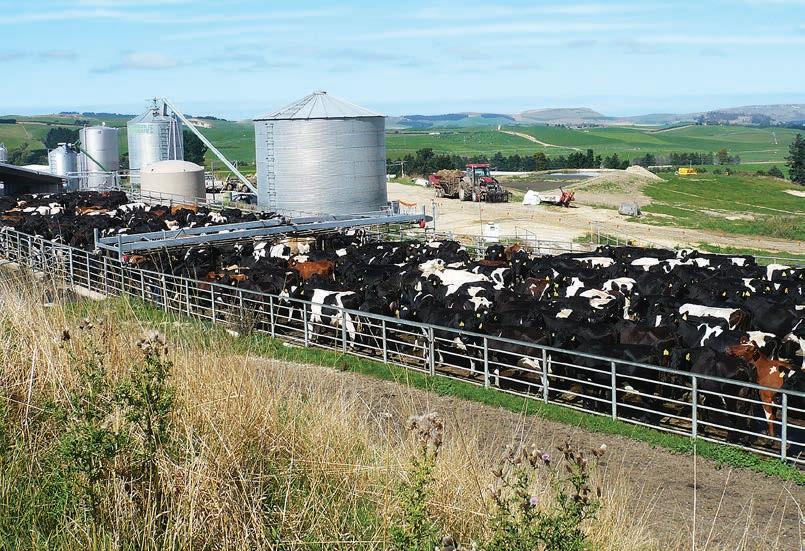
related challenges also remain a top priority for farmers. Many are seeking better access to tools that will help reduce their
environmental footprint and are asking for fit-for-purpose regulations that support real progress on farm.
The Pro Start™ range has been developed to provide a range of balanced and nutritious calf feed supplements for growing good calves, with options to suit all systems and budgets.












Richard Rennie NEWS Dairy
SUPPLY constraints on New Zealand’s ability to produce enough dairy protein to meet global demand are becoming apparent, but any increase needs to be managed in the right way, says Fonterra chair Peter McBride.
Speaking to Farmers Weekly, McBride acknowledged the growing shortage of quality protein is a supply constraint. The limitation was something also confirmed by Fonterra staff during a recent Farmers Weekly visit to Taiwan.
Commanding premiums of 10-15% and up to 70% of some ingredients markets in Taiwan, the co-op’s protein ingredients are in high demand, coming as New Zealand cow numbers are well past their peak.
The resulting strong returns have anecdotal reports of more dairy farm conversions happening after almost a decade of minimal new farm supply growth.
But McBride was cautious about any prospect of a new “white gold” boom.
“We have to manage any increase in the right way. There is not one size fits all for increasing volume and it has to be on a catchment- by-catchment basis. We are starting to see an increase in conversions, there is potential for growth. How much? That is a moot point.”
Nitrate losses and ensuing water quality issues are the main constraint – one Fonterra has to manage carefully as it invests heavily in the “grass-fed, natural” message for NZ-sourced milk ingredients.
“Those farms that are converting, they are going to require more infrastructure, more concrete and a focus on the environment.” He said environmental constraints are playing a role in global limitations on dairy protein growth, pointing to the likes of the Netherlands, where farmers are retreating from dairying.
In addition, disease issues like blue tongue, also in Europe, are a brake on the ability of farmers to grow herd supply volumes.
The United States remains the one country capable of growing volumes relatively rapidly.
“But what is interesting is the low beef herd numbers, the lowest since the 1970s.
“There are now dairy farmers who are making choices about how they can optimise revenue from beef on their dairy operations.”
Smaller, often older family-type farm businesses are opting to put terminal beef sires over cows, in a market where four-dayold beef-cross dairy calves are worth US$800 a head.
“It is almost as if they are looking at it as a way to move out of dairy.
“But we are also seeing the US work on growing its milk components [fat and protein] deliberately rather than just volume growth, in part responding to lower demand for liquid milk and growing demand for ingredients.
“Those marginal milk solids are now being exported.”
Accompanying this is increased investment in specialised plant capacity to take the liquid product to a more sophisticated ingredient form.
McBride was confident about Fonterra’s farmers’ ability to meet the co-op’s imposed target of 30% farm emissions intensity by 2030 compared to 2018 emissions. It comes as its main market, China, is also
establishing its own reductions targets.
“Their targets appear to be similar to ours, and it definitely seems to be coming from top down.”
McBride said picking the right emissions reduction target is a delicate business.
“The target needs to be aspirational, but we need to also be cogniscent about trade access and free trade agreements. If we get it wrong, we invite non-tariff trade barriers based on emissions.”
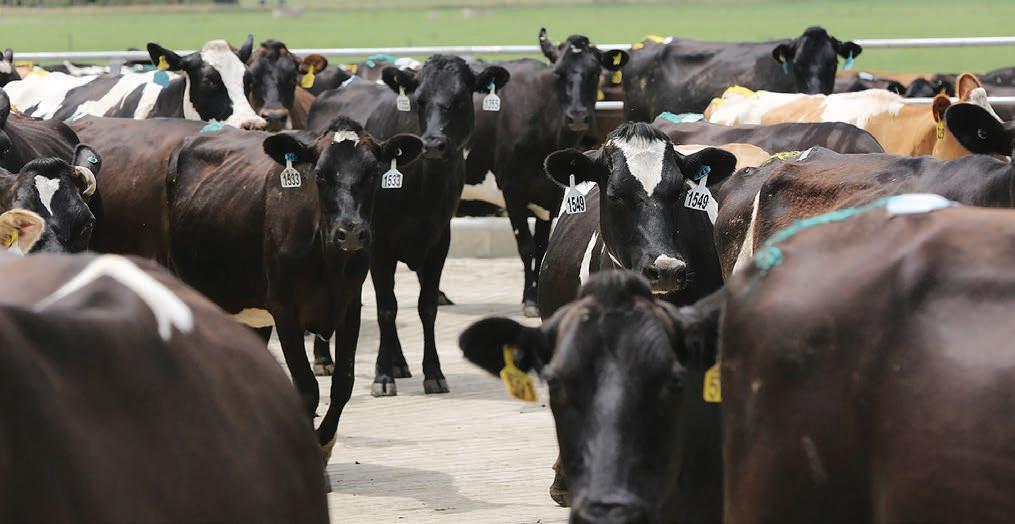
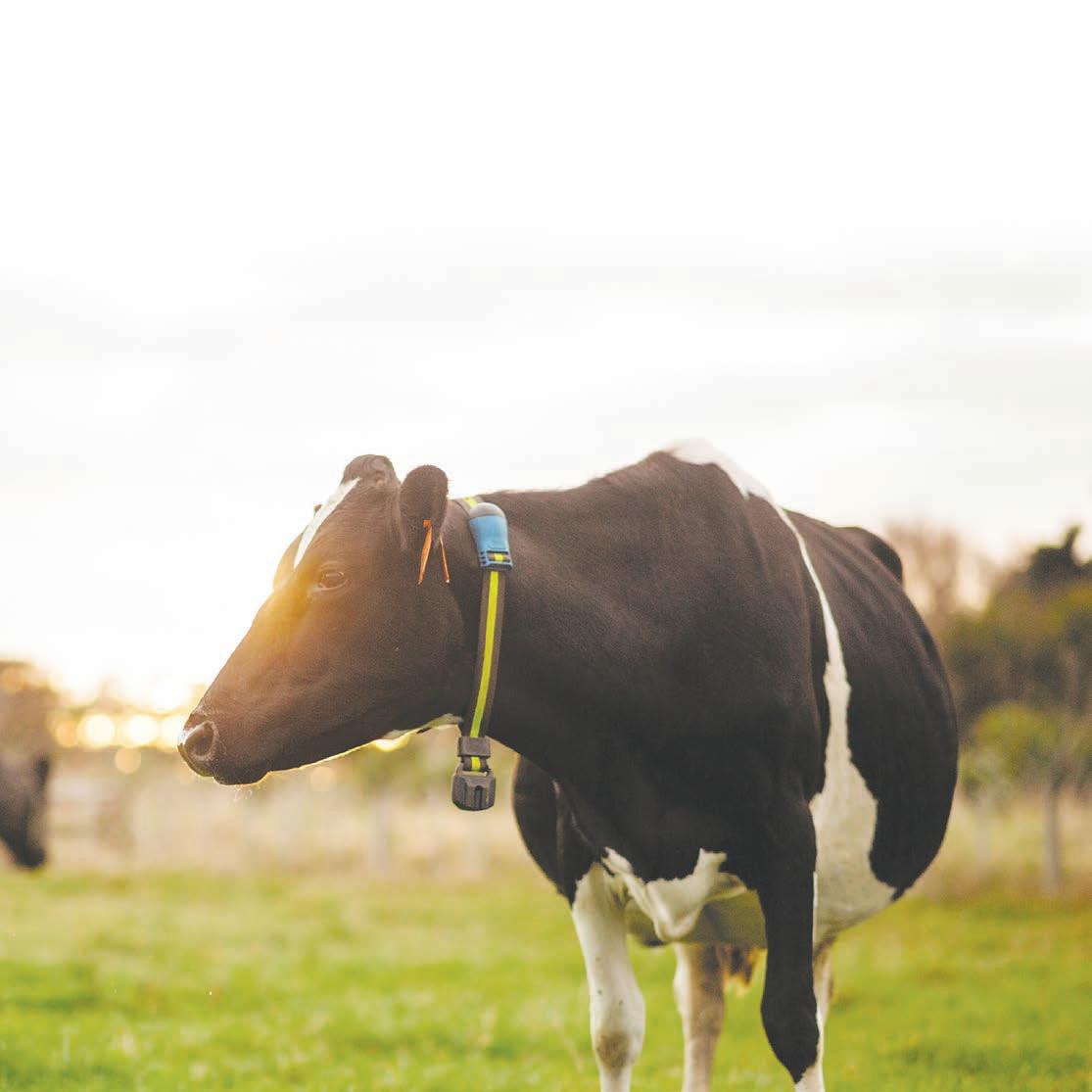


Annette Scott NEWS Environment
FROM monthly skip bins to becoming a recycling pro, south Taranaki farmer and 2019 Dairy Woman of the Year Trish Rankin is on a mission to help farmers minimise waste.
She hosted workshops for farmers last month to share strategies for managing waste on farms.
Rankin’s mission goes back to the day she and her husband Glen bought a dairy farm.
The couple had spent the previous 20 years working hard to save and learn all they could about dairy farming, while raising their four boys.
In 2017, they were sharemilking in Taranaki when they started noticing they had a skip bin of waste collected every month.
“I started to think, how do we have this much rubbish on the farm, and it’s all going to landfill?
There must be another option.”
In 2019, through the Kellogg Leadership Programme, Rankin began researching waste minimisation on farms and how a circular economy model could be developed in New Zealand.
She found growing requirements for manufacturers of on-farm products to be a part of a recovery scheme.
Every
farmer
I know is trying to do better, but it takes time, money and education.
The missing link, she said was that many farmers still didn’t know what they could recycle, and how, because it hadn’t been well communicated.
“The great thing about the workshops is people can share solutions.

“It’s not me telling people what to do. Someone might have a solution for tractor batteries and someone else might know more about recycling bale wrap. That way we can learn from each other.”
Rankin found many farmers were unaware they were already paying a product recovery levy.
“Let’s just say I buy a $1000 drum of alkaline: $75 of that might be a levy to get that collected, but you don’t know you’ve paid that and instead you’re paying more money to get it collected in your skip bin.”
There are many changes people can make to better the environment and sometimes that can feel overwhelming, “which is why I suggest focusing on one goal at a time”.
The “should be” list can be very long in farming.
“You should be doing better for your animals, for your people, for your climate.
“We [farmers] seem to get judged for our environmental footprint in everything we do.
“Every farmer I know is trying to do better, but it takes time, money and education.”
Instead of opting for products that could be wasted after a single use, Rankin is encouraging farmers to choose sustainable products with Agrecovery stickers signalling they’re part of a recycling scheme.
“My biggest hope is that after finishing a workshop, people would leave with the confidence to make one decision a month towards minimising and managing waste.
“This month it might be Fun Day Friday, where you take a load to the recycling depot and have a fish and chips lunch with your workers.
“That’s one change, and then next month you might look at doing something with your silage or baleage wrap or composting.”

Staff reporter TECHNOLOGY Livestock
RECORD demand has seen Halter expand the number of winners in its Win Halter FREE for a Year competition from three to four farms.
Two dairy farms and two beef farms will receive a full year of Halter for free. This will give them access to the full suite of virtual fencing and farm operating system tools designed to increase productivity, improve farm management efficiency and sustainability.
This is the second year that Halter has offered the competition to dairy and beef farms across the country.
Entries are judged on their potential impact, motivation and appetite to embrace Halter innovation on farm.
The winners will be fully supported by the Halter team as they integrate Halter into their day-to-day farming.
Wairarapa beef farmers Matt and Lynley Wyeth said in their team’s winning application that as farmers with a hunger
to improve, Halter “would be a game-changer across our scale, systems, and standards”.
Canterbury dairy farmer and winner Helen Elliot said in her application that Halter would add extra confidence.
“We have pretty strong performance already, but we know there’s always room to improve – Halter would help push results further.”
Canterbury beef farmers Mark and Joanne Stevenson, also Halter winners, said: “This is about better feeding, better animal performance, and making our tough terrain easier to manage.
“Halter will help us optimise pasture production and utilisation alongside animal feeding and productivity.”
Winning Waikato dairy farmer Elizabeth Wilding said she uses technology to drive every decision on her 140 hectare, 480-cow farm.
“Halter would take my pasture management to the next level. Halter would help me grow more, waste less, and push performance in a sustainable, future-focused way.”




















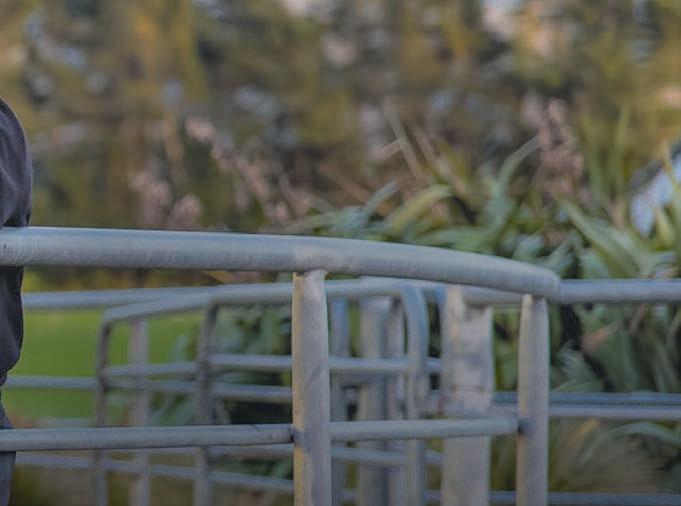







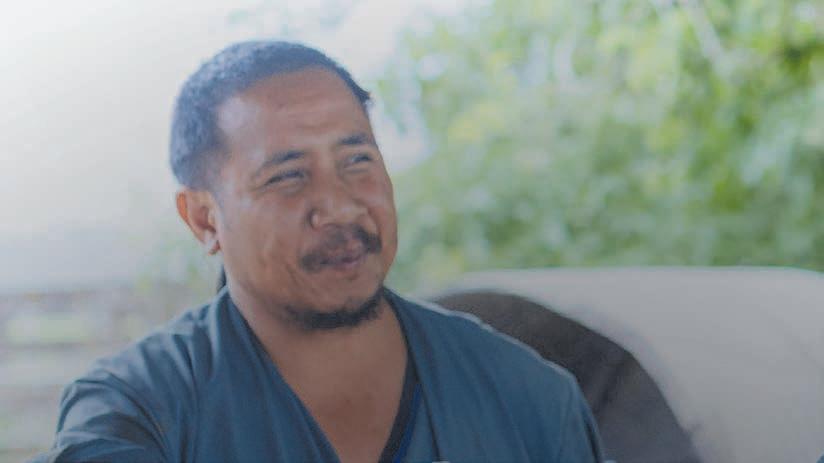











































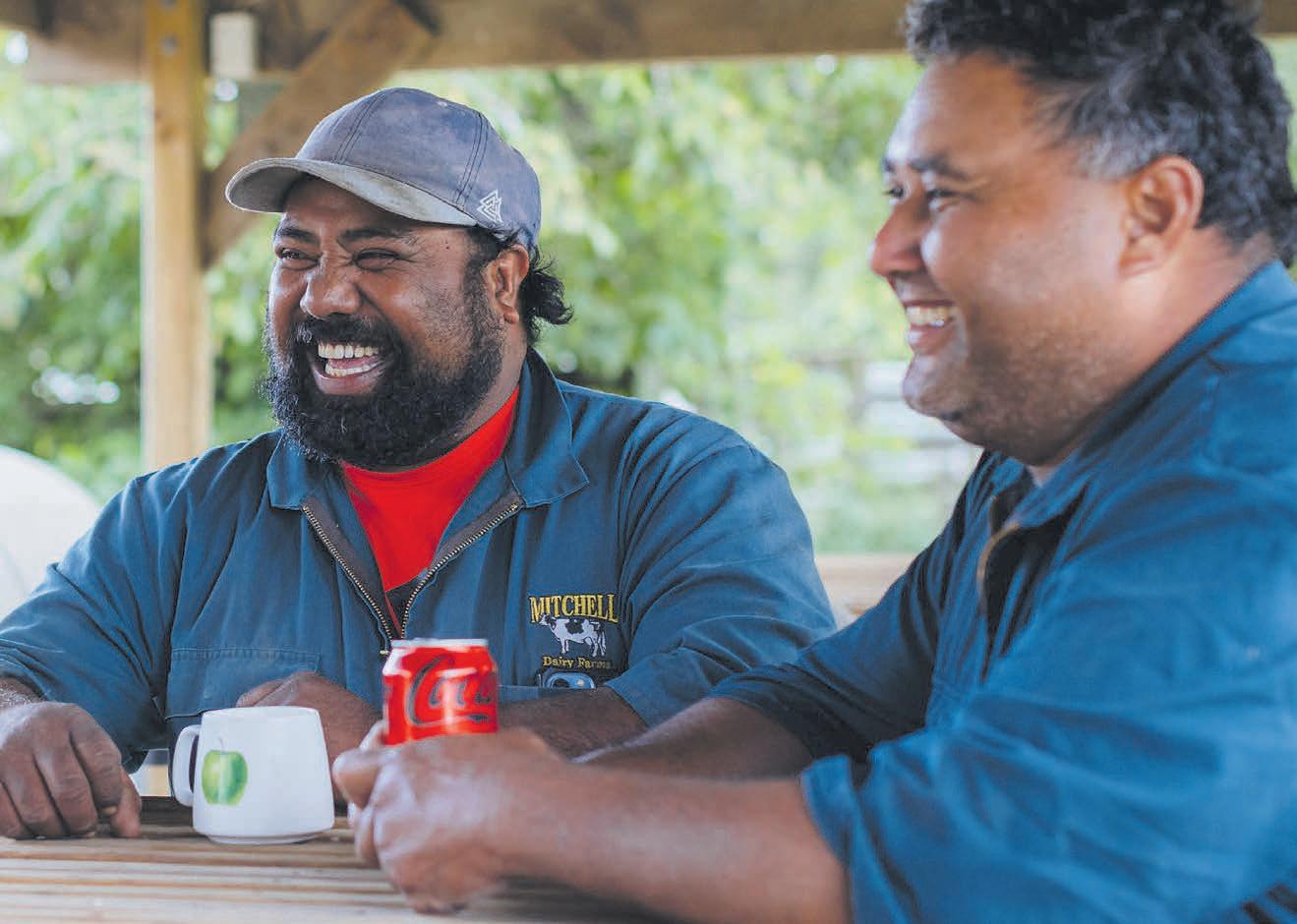
leading a team or working solo, Workplace 360 helps you identif y what ’ s working well and where there’s room to grow


Creating great workplaces is essential to the long-term success of New Zealand’s dair y sector and it ’s something I’m passionate about .
At D air yNZ, we know that when people enjoy coming to work , it ’ s good for business, good for wellbeing, and good for the future of our farms That ’ s why we ’ ve relaunched our Workplace 360 tool, which is a prac tical, easy-to -use selfassessment that helps farmer s take a fresh look at how things are going on-farm
We’ve listened to farmer feedback and streamlined the design and content to make Workplace 360 more intuitive and user-friendly The tool suppor ts farmer s to reflec t on how they ’ re m anaging their team, meeting health and safet y responsibilities, and creating a positive work environment Whether you ’ re
Impor tantly this updated ver sion is focused on learning not compliance It ’ s designed to build confidence and capabilit y, not tick boxes The tool takes about 25 –30 minutes
urbanisation, to lower bir th rates and rapid tech advancement To at trac t and keep great people, we need to think differently about how we lead, how we communicate, and what today ’ s employees are looking for




By Jane Muir, Dair yNZ senior people specialist

to complete and is split into t wo par ts: a checklist of essential workplace prac tices, and a deeper dive into the areas that mat ter most to each individual farmer
O nce completed, farmer s receive a per sonalised repor t with feedback and link s to prac tical resources that can suppor t improvements It ’ s about giving farmer s clarit y and control to make changes that are meaningful and sustainable
Why is this work so impor tant? Because like ever y business in New Zealand, dair y farming is being shaped by some big social shif ts from an ageing work force and increasing
Build on your wins, strengthen your workplace
• Focus on what mat ters most to your business and team
• Get practical advice tailored to your farm
• Enjoy a simpler, faster tool – shaped by farmer feedback
Use the Workplace 360 self-assessment tool at dair ynz .co.nz/workplace360


n, grow th and ac tion It reflec tio
helps fa they ’ re p their tea of our se

rmer s build workplaces roud of, for themselves, ms, and for the future c tor
The good news is we have a great stor y to tell D air y farming offer s ur ose - driven mahi
p p , the oppor tunit y to be outdoor s and work with animal s and the increasing use of technology means a wider range of people can see themselves in the sec tor We just need to keep showing we ’ re commit ted to being great employer s
Workplace 360 is one par t of D air yNZ’s Increasing Workplace Productivity programme, which focuses on research and tool s that suppor t great people in great jobs, in great workplaces It ’ s designed to be prac tical, for ward-thinking, and above all el se useful
We’ve tested this tool with farmer s to make sure it adds real value It ’ s more than a checklist, it ’ s a resource for
For Font complet al so con the requ Co - oper ro ra
erra supplier s, ing Workplace 360 tributes to meeting irements of the ative Difference p g mme The tool can be completed online at any time, but we recommend get ting it done at least a week before your Co - operative Difference audit
If we want a successful future for dair ying, we need to invest in our people today That means creating farm workplaces where people can grow, feel valued, and enjoy what they do Workplace 360 is here to help make that happen
Workplace 360 is free to use and available now at dair ynz .co.nz/workplace360
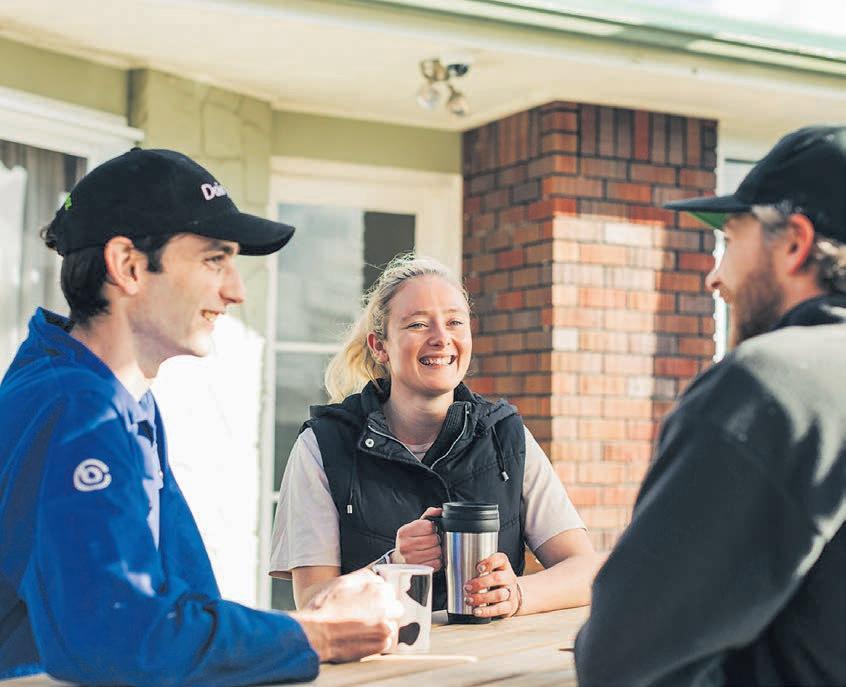
Federated Farmers has fronted up to Parliament this week calling for urgent changes to stop the wholesale conversion of productive farmland into carbon forests.
Appearing before a Select Committee, new meat and wool chair Richard Dawkins urged MPs to close loopholes and said the proposed legislation doesn’t go far enough.
“Our members are still incredibly concerned about the continued conversion of entire farms to pine trees, incentivised by the carbon market,” Dawkins says.
“We’re alarmed by the continued rapid pace of land use change driven by high carbon prices, and the resulting social, environmental and economic consequences.
“While we fully support the intent of this Bill – to protect foodproducing land from being lost to pine trees for carbon farming –there’s still work needed to ensure that goal is achieved.
“The current draft leaves loopholes that would allow the damage to rural communities to continue.”
Dawkins only recently stepped into
the role but is determined to carry on the momentum of the Save Our Sheep campaign and keep pressure on decision-makers.
“This issue isn’t going away, and neither are we,” he says.
Under current ETS rules, landowners can earn carbon credits by planting exotic trees such as radiata pine.
The potential earning from this government-controlled market exponentially outweighs the returns from food production.
That’s led to a wave of whole-farm conversions, particularly on sheep and beef country, where overseas investors and carbon-focused forestry companies are buying up land for permanent forests.
Federated Farmers has repeatedly warned this trend isn’t being driven by timber production or community benefit, but by artificial incentives in the ETS.
The impacts are being felt across rural New Zealand, from depopulating schools and shrinking local economies to worsening pest problems and wilding pines.
“Reviewing the ETS forestry settings was one of our 12 key policy

priorities ahead of the last election,” Dawkins says.
“We welcomed the Government’s commitment to act quickly, and we appreciated the strong cross-party support the Bill received at its first reading. But now’s the time to get the detail right.”
Federated Farmers’ submission argues the proposed moratorium on whole-farm conversions should apply not only to land classified as Land Use Capability (LUC) classes 1–5, but to all land classes.
As it stands, the Bill allows a potential ‘lottery’ system for class 6 land, where conversions could still occur on a first-come-first-served basis.
There are also no restrictions on class 7 and 8 land – effectively open slather.
“This introduces unnecessary confusion and undermines the Bill’s
purpose,” Dawkins says.
“Just because land is steep or class 6 doesn’t mean it’s unproductive. These hills are often vital breeding country that underpins our red meat sector.
“If we keep losing it, we’ll see knock-on effects across the supply chain.”
Instead, Federated Farmers proposes a consistent rule: allow up to 25% of any farm to be used for ETS forestry, regardless of land class.
This approach would prevent large-scale, full-property conversions while still protecting private property rights and enabling planting where it makes sense.
“This is about the right tree in the right place,” Dawkins says.
“Integrated landscapes – not carbon forests – are what we need. We shouldn’t let distorted carbon

prices drive land-use decisions.”
Dawkins says farmers aren’t anti-forestry.
“We see the value, but carbon forestry is a distortion that’s costing us good land, good people, and the backbone of our economy.”
He also raises concerns about the Bill’s clarity around planting deadlines, particularly how ‘intent to plant’ before 4 December will be defined.
“Greater clarity is needed,” Dawkins says.
“Ordering seedlings or hiring a consultant to do an assessment shouldn’t qualify. We need clear, enforceable criteria to prevent backdoor conversions.
“In the meantime, Federated Farmers has written to Ministers naming farms that we think haven’t been adhering to the December 4 rule.”
Dawkins also urges the Government to look at sequestration opportunities on public land, particularly the eight million hectares managed by the Department of Conservation.
“If carbon sequestration is going to be central to our climate efforts, then DOC land has to be part of the solution,” he says.
“Improving sequestration across even a small portion of this area would be more effective – and less damaging – than planting pine trees on productive farmland.”
Federated Farmers’ message remains clear: protect productive land, support balanced land use, and stop the unintended consequences of a poorly designed carbon market.
“Now we need to make sure this legislation delivers on that. We owe it to the communities on the frontlines.”








Federated Farmers is calling on growers to back the renewal of the Herbage Seed Levy, to help ensure public cultivars like Nui ryegrass and Huia white clover remain available.
The levy, due to expire in December 2026, supports the maintenance of these nonproprietary cultivars (NPCs), often referred to as the ‘Commons’.
These publicly available varieties are a trusted, vital option for growers who choose not to grow under contract with seed companies.
“Growers must understand the importance of voting to renew the levy,” says John McCaw, chair of Federated Farmers’ Herbage Seedgrowers Subsection.
“Without a strong ‘yes’ vote, we risk losing a system that protects
access to reliable, proven cultivars developed here in New Zealand.”
Currently, the levy is collected on certified NPC production as well as on all uncertified ryegrass, red clover and white clover.
However, McCaw says the market has changed.
Without a strong ‘yes’ vote, we risk losing a system that protects access to reliable, proven cultivars developed here in New Zealand.
John McCaw Chair of Federated Farmers’ Herbage Seedgrowers Subsection
“It’s no longer safe to assume uncertified ryegrass and clover crops are derived from NPC genetics.
“Much of today’s uncertified seed comes from proprietary or overseas cultivars that were never meant to be covered by the levy.”
To address this, Federated Farmers is updating the wording of the levy order to ensure it applies only to non-proprietary cultivars, regardless of their certification status.
McCaw says Federated Farmers doesn’t make any profit from the levy.
“It’s purely about generating enough revenue to keep muchneeded cultivars available. This is an industry-good activity we do for the sector.”
Voting opens on 18 July and runs through August. If successful,

Federated Farmers says urgent action is needed to plug a looming gap in treatments to fight native grass grub, which costs the agricultural sector hundreds of millions of dollars each year.
“This is our biggest agricultural pest by a country mile, yet there’s a real risk farmers’ arsenal to fight it will soon be empty,” Feds biosecurity spokesperson David Birkett says.
“It’s pleasing that manufacturers have work developing new chemicals underway.
“We also need the Environmental Protection Authority to prioritise and fast-track their assessment of any new options.”
Costelytra giveni is a scourge for pasture and lawn, and also a risk to horticulture and native plant root systems.
The two most effective chemicals to control the grub – chlorpyrifos and Diazanon – are both being phased-out after decisions by the EPA to ban them.
Chlorpyrifos, a broad-spectrum organophosphate insecticide, is

banned in the European Union and Canada, and its use is heavily restricted in Australia.
The EPA recently consulted on banning chlorpyrifos here. After submissions and a public hearing, a decision-making committee found risks to people and the environment – especially to those spraying it –outweighed the benefits.
“We’re pleased the EPA listened carefully to our submission, and decided that for the agricultural sector, the ban would come at the end of an 18-month phase-out period,” Birkett says.
“However, stocks of chlorpyrifos are already very limited and in the face of bans, manufacturers are taking it out of production.”
fer tiliser delivers nutrients precisely while reducing waste. From Vineyards to the High Countr y, the little guys can be tailored to your farm’s needs.
Federated Farmers understands AgResearch and ag chem companies are well underway with developing a new tool for combatting grass grub.
“We’d really like to see them accelerate that development work. It would be disastrous for food production and our agricultural exports if our farmers are left high and dry for any period without an effective control method,” Birkett says.
A 2018 study said native scarab grass grub causes losses of up to $380 million on dairy farms and $205 million on sheep and beef farmers every year – and that was with access to chlorpyrifos.
Birkett says the EPA also needs to play its role swiftly.
“Federated Farmers has been critical of the EPA’s failure to get on top of a backlog of assessment applications for agri-chemicals and animal health treatments.
“We’ve welcomed Government announcements on new measures
aimed at streamlining assessment processes.
“The EPA’s key focus shouldn’t be assessing generic chemicals already available,” Birkett says.
This is our biggest agricultural pest by a country mile, yet there’s a real risk farmers’ arsenal to fight it will soon be empty.
David Birkett
Federated Farmers biosecurity spokesperson
“Their work stream needs to take better account of how far off approvals are for effective replacement products, including biosecurity and pest increase issues, and how much delays would cost the country.
“New chemicals that offer greatest economic benefits should get priority in the queue – and I’d put any new treatment for grass grub in that category,” Birkett says.

Federated Farmers is calling for new proposed ‘green’ finance rules to be scrapped, warning they’re ideologically driven, unworkable, and risk doing real harm to rural communities.
In a letter sent to Ministers and key officials on July 11, the organisation outlined a series of serious concerns with the Sustainable Finance Taxonomy.
“This framework is fundamentally flawed,” Federated Farmers banking spokesperson Mark Hooper says.
“It has been created without meaningful input from working farmers, it imposes unrealistic standards, and it risks cutting off financial services to legitimate, productive rural businesses.”
The Sustainable Finance Taxonomy is being developed by the Centre for Sustainable Finance and the Ministry for the Environment to provide a consistent framework for defining what is ‘green’ or ‘sustainable’ in financial markets.
Federated Farmers says it would create major risks for New Zealand’s agricultural sector and is urging the Government to halt the process entirely.
“One of our core concerns is the lack of practical farming expertise involved in developing the taxonomy,” Hooper says.
“There are no hands-on farmers involved with the Technical Advisory Group. Instead, it’s full of shinyshoed bankers, sustainability advisors, and forestry lobbyists.
“If you’re designing a finance framework for agriculture, farmers must be at the table. This is a total governance failure.”
Without real-world knowledge of farming systems, the framework fails to reflect the operational realities and sustainability efforts already embedded in New Zealand’s primary sector.
For example, the proposed
taxonomy defines ‘green’ farming as producing less than one tonne of CO₂ equivalent per hectare per year.
“This threshold is so low that no working New Zealand farm could realistically qualify, even though we’re home to the most emissionsefficient food producers in the world,” Hooper says.
If you’re designing a finance framework for agriculture, farmers must be at the table. This is a total governance failure.
Hooper Federated Farmers banking spokesperson
“It sends a message that no farm is green, regardless of how well it’s managed or how efficient it is.”
Another concern is that productive farmland would be disqualified from being considered ‘green’ if it was ever a natural ecosystem since 2008.
“This ignores decades of
sustainable stewardship and penalises farms that have long been operating responsibly,” Hooper says.
The proposal also includes requirements that Federated Farmers says are simply unworkable.
One rule would require 80% of fertiliser use to come from lowemission products within three years – a target Hooper says isn’t feasible.
“Those alternatives are not yet economically viable or widely available in New Zealand. Farmers can’t use what doesn’t exist.”
He says another major burden is the requirement for Farm Environment Plans to include extensive biophysical documentation.
“While many farmers already have FEPs, the new standard would dramatically increase complexity and cost, particularly for small and medium-sized farms.
“This is a compliance nightmare with no clear benefit.”
Despite the potential impact on rural capital flows and lending, there has been no economic analysis of how the taxonomy might affect


farm businesses, landowners or rural lenders.
“For a framework that could fundamentally alter access to finance, this is an unacceptable oversight,” Hooper says.
Federated Farmers also warns the taxonomy duplicates many requirements already covered by national regulation or industry programmes.
“This adds unnecessary red tape without delivering meaningful environmental or financial benefits,” Hooper says
At the same time, by defining sustainability through a fixed list of approved practices and technologies – such as specific fertilisers or methane inhibitors – the taxonomy risks excluding innovative new solutions still in development.
“This will lock us into today’s technology and penalise tomorrow’s breakthroughs,” Hooper warns.
While the taxonomy is currently non-binding, the design intent is to become mandatory.
That shift would make it harder for legitimate farm businesses to
access lending, insurance, or investment – not because they’re unviable, but because they don’t meet an arbitrary ‘green’ standard, Hooper says.
“This would create a two-tier financial system, where productive and lawful farms are denied services because they don’t fit a narrow ideological framework.”
Federated Farmers supports the intent of two Members’ Bills currently before Parliament, introduced by Andy Foster MP and Mark Cameron MP, which aim to prevent financial institutions from making lending decisions based on ideology or reputational risk.
“The taxonomy, in its current form, directly undermines that intent,” Hooper says.
Federated Farmers is urging the Government to disband the taxonomy process entirely, warning it will do more harm than good.
“This is not a path to sustainable finance. It is ideologically driven, practically unworkable, and risks serious harm to rural New Zealand,” Hooper says.
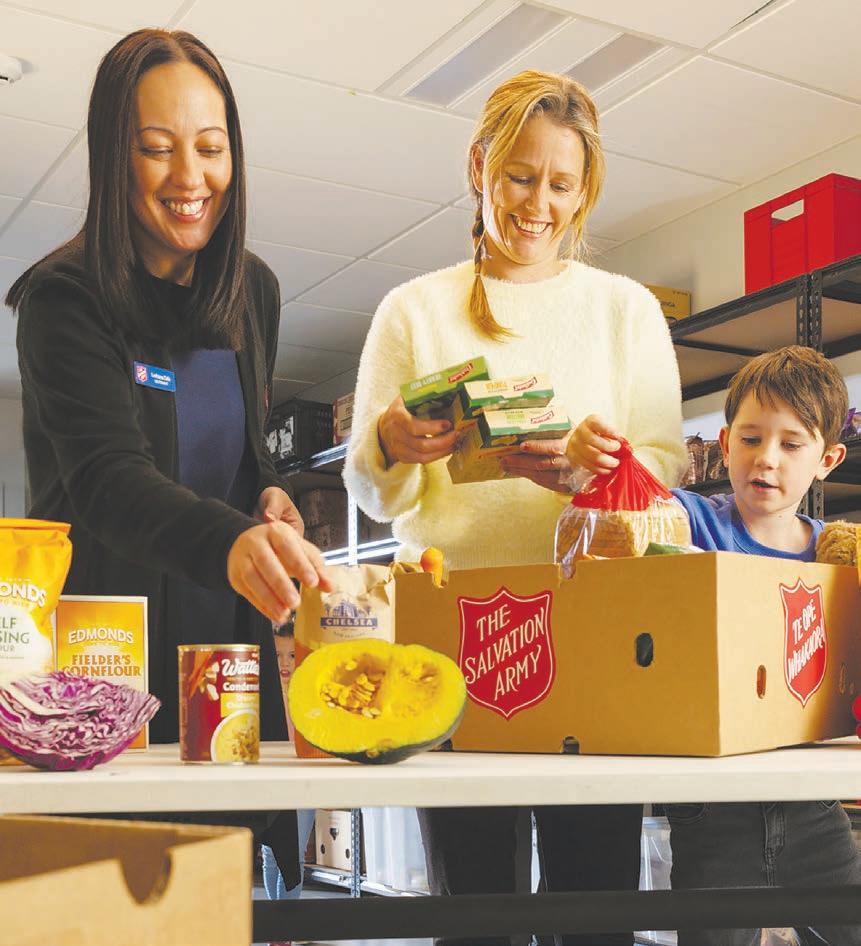








Jimmy Emmett used to run a popular bar in downtown Christchurch but now he’s all about another favourite Kiwi beverage – milk.
“It sounds a bit corny, but I’m lucky I found my passion when I was mature enough to know what I wanted to do with the rest of my life, and to go for it,” he says.
“Sure, there are days in dairy when you just feel like pulling your hair out. But I’m loving the lifestyle, the outdoors and a sense of freedom that comes with being a contract milker – it keeps the cup full.” Emmett, South Canterbury
Federated Farmers’ dairy chair, has just been named Feds’ Dairy Advocate of the Year for his thoughtful and solutions-focused approach to the industry’s big issues.
In the words of Feds president Wayne Langford: “Jimmy consistently goes out of his way to seek support and advice for farmers doing it tough and he puts in the work to make a real difference in their lives.”
It’s quite a switch for a Whanganui and Tauranga-raised “city boy” who once knew little more than milk came from the local dairy, and meat from the supermarket.
Emmett came down to Christchurch to start a Bachelor of Education degree, studying PE, and funded that by working at The Mad Cow, a country-themed bar favoured by Lincoln Uni students.
“I was finishing later and later at night and eventually decided uni wasn’t for me. So, I bought shares in the bar, and that’s also where I met my wife Charlotte.”
After nine years of living in the city and the long hours in hospitality, he’d had enough.
“Charlotte’s brother had just gone dairy farming, and reckoned we should give it a go.
“She gave up being a florist and I sold the partnership in the bar –good timing as it turned out, as the first big Christchurch earthquake hit not long after.
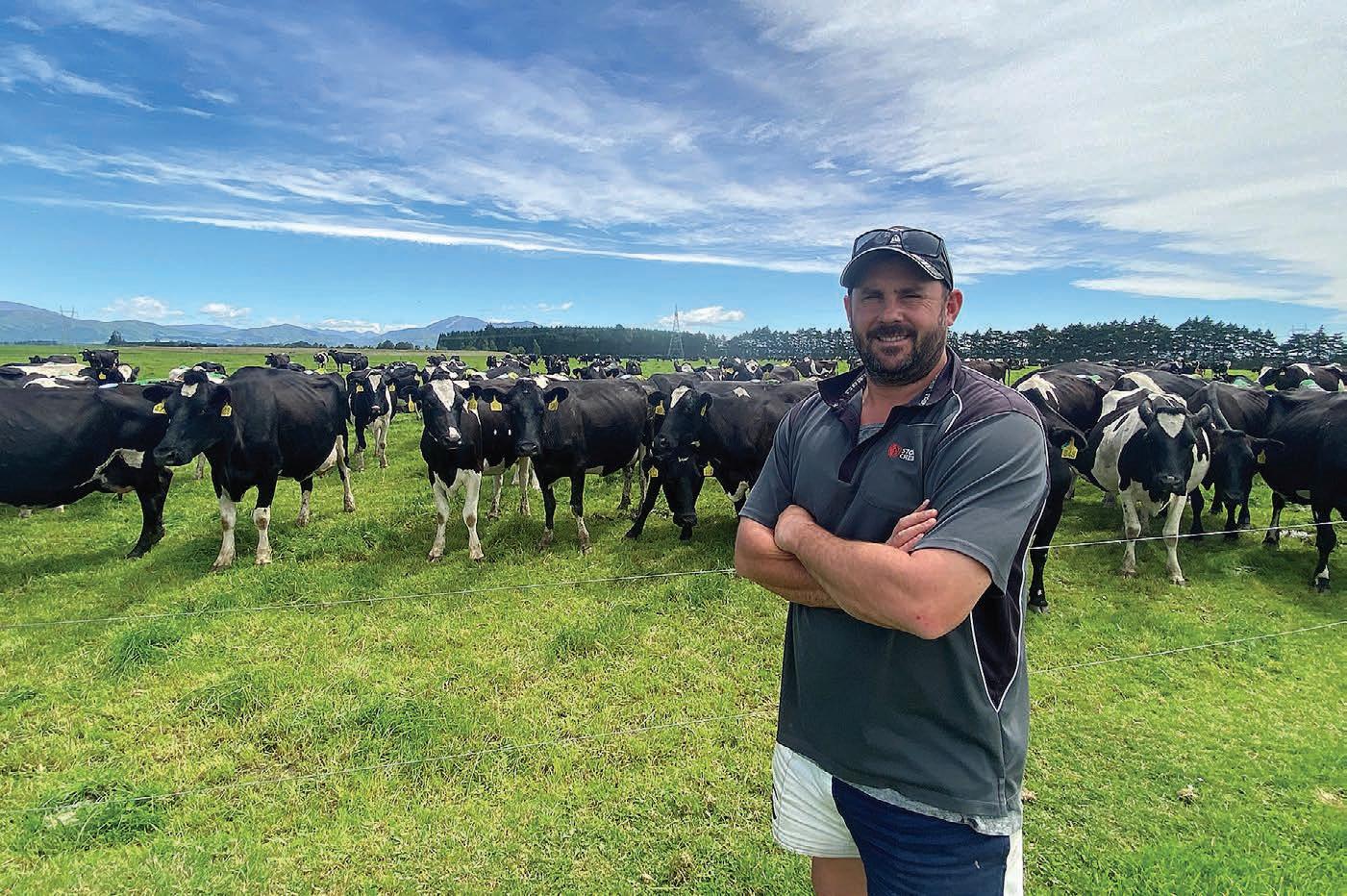
We get to help steer the direction of the industry – and keep the worst of the ‘crazy’ out of some of the policies coming from central and local governments.
Jimmy
Emmett Federated Farmers South Canterbury dairy chair
“We thought ‘we’ll give it a year in dairy’. The first time I saw a real-life cow, I was putting cups on it!
“That was 16 years ago and we’ve never looked back.”
Now with three kids aged 12-16, Jimmy and Charlotte are contract milkers on two of the Pye Group’s farms out of Geraldine, milking 1700 cows and with eight staff.
Farm ownership was once the
dream, but the reality of how much capital it would take made them realise it probably wasn’t on the cards.
“Once we understood that, a whole lot of pressure and stress came off, and we were able to focus on what we do well.
“Ownership is different for different people,” Emmett says.
“For us, it’s become about owning our own destiny and decisionmaking.”
Just because they don’t own the land doesn’t make them any less farmers, he says.
“We’re in the trenches, blood and guts; we treat the farms and animals like our own, we’ve aligned ourselves with some great people.
“But we’re not saddled with debt and don’t have those succession worries down the track.
“Contract milking is low risk and lower reward, but we have
investments off-farm and we’ve built a scale of business that means we live a pretty cool lifestyle.”
Emmett didn’t exactly plan to step into leadership at Federated Farmers – but when opportunity knocked, he didn’t hesitate.
It started nearly five years ago, when the South Canterbury sharemilker chair had a baby on the way and needed to step back.
Emmett put his hand up to fill in.
Then, just 14 months ago, came a classic case of being in the wrong place at the right time.
“About five minutes before the AGM, dairy chair Ad Hendriks shoulder-tapped me and said he was off travelling – and I was it.”
He’s not complaining.
“We’ve got a pretty cool team – Greg Anderson as provincial president, Ad’s now the sharefarmer owners chair, and Jared Crawford’s the sharemilker rep.
FARMING CONVERT: After selling his stake in The Mad Cow bar,
and wife Charlotte gave themselves a year to make a go of dairy farming. Sixteen years later, they’re still there.
“On the national dairy council, we’re well aligned on what needs to be done, and I think we can make strong steps forward.
“The thing I like about Feds is being part of the conversation. We get to help steer the direction of the industry – and keep the worst of the ‘crazy’ out of some of the policy coming from central and local government.”
For Emmett, the two biggest sector challenges ahead are finding enough motivated staff to fill farm roles long-term, and waiting for promised RMA reforms to reduce and re-shape council red tape.
“It’s like we’re hurrying up but still waiting. We’re aching for some certainty so we can plan a course.”
One thing’s for sure: Emmett will continue doing what he loves –farming hard, speaking up, and keeping the cup full.
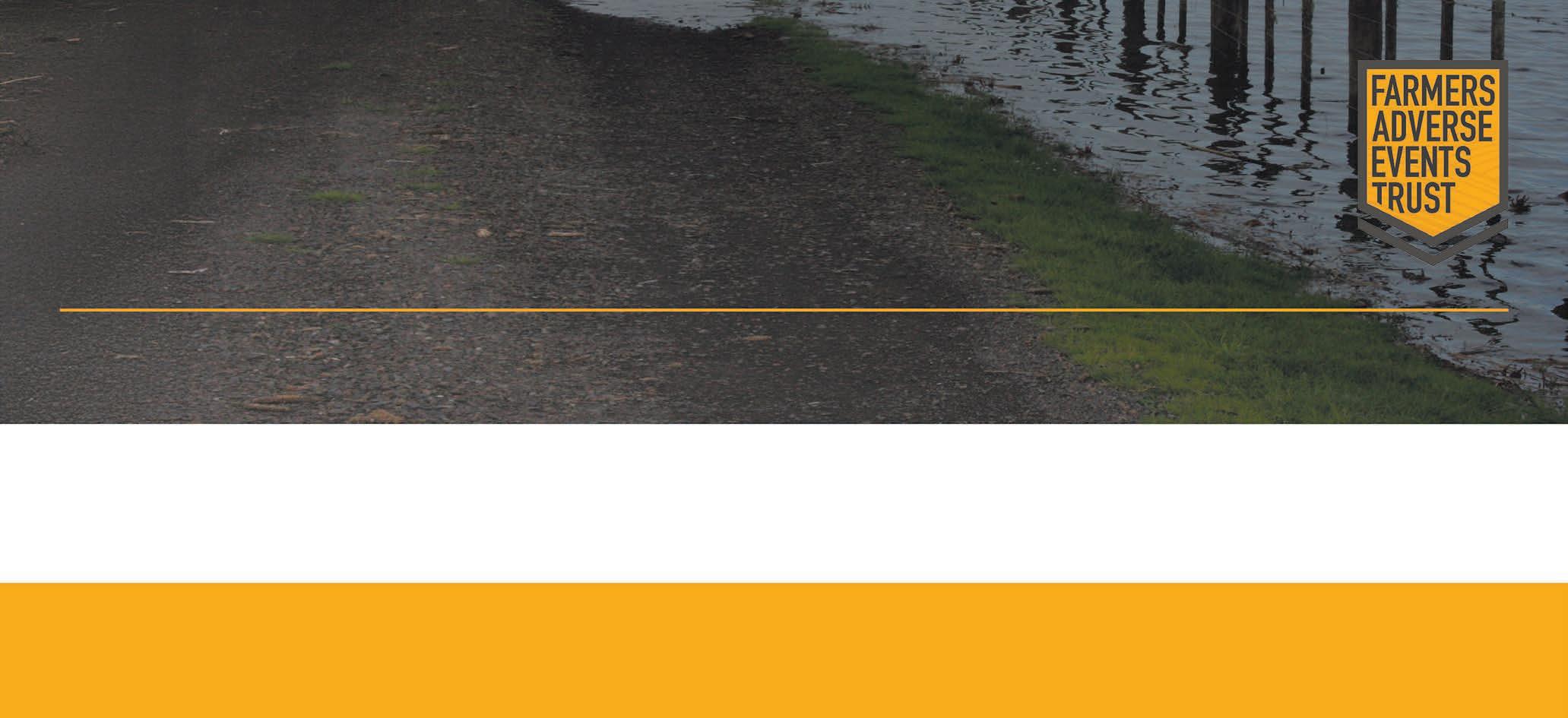

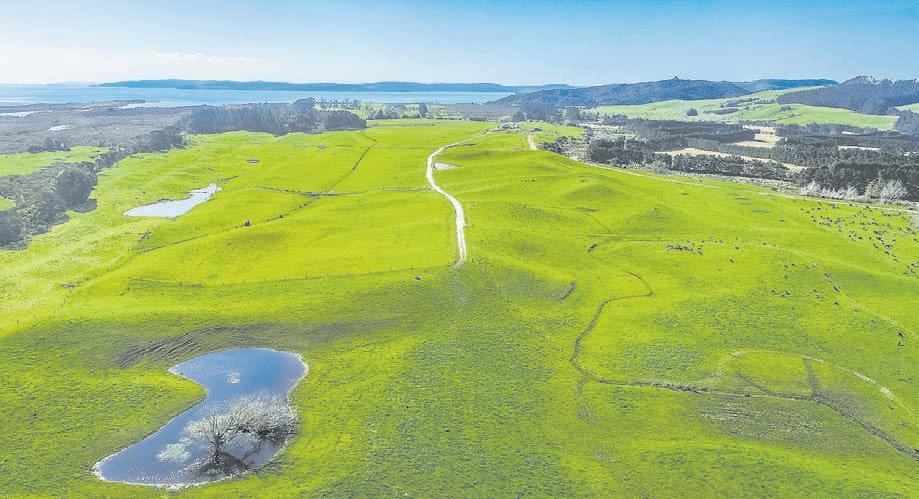


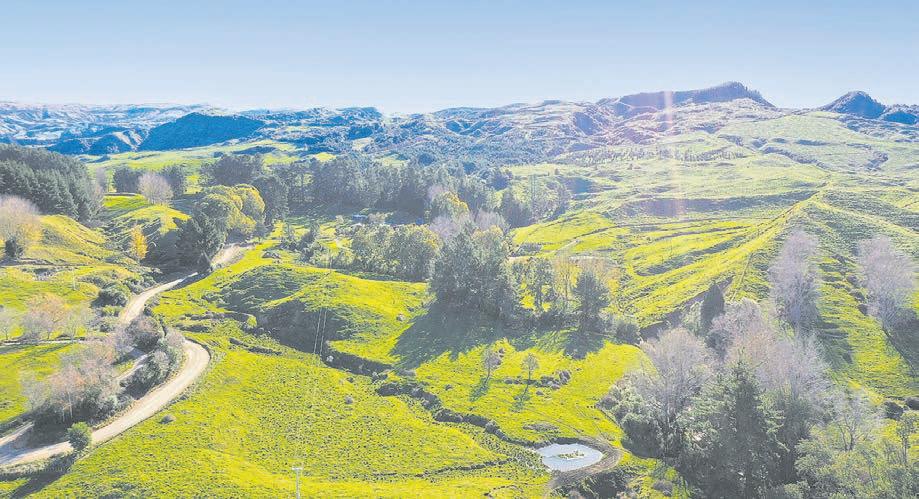


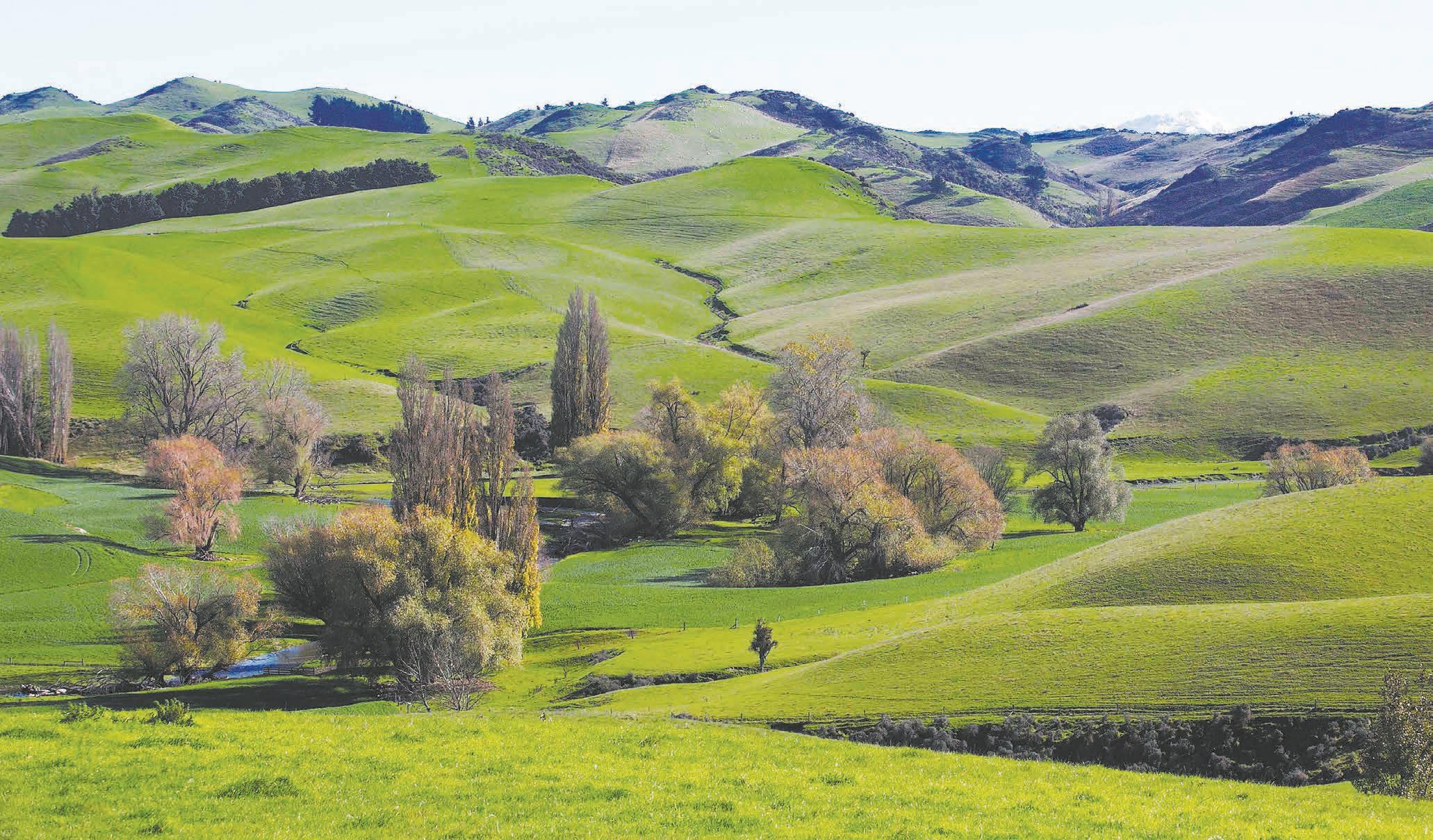
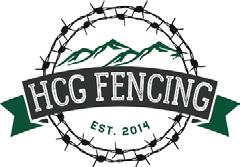







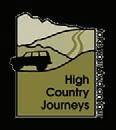


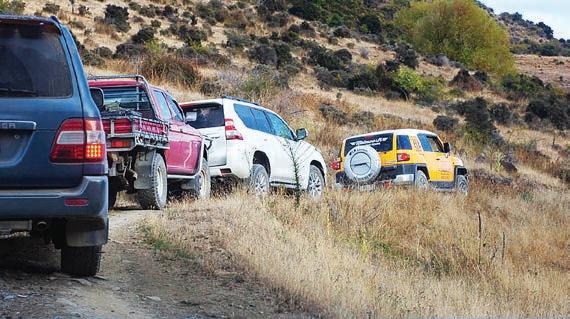

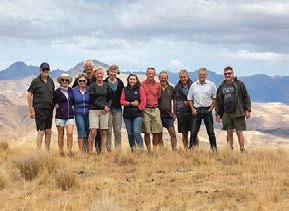








FOR ONLY $3.30 + gst per word you can book a word only ad in Farmers Weekly Classifieds. Phone 0800 85 25 80.
DOGS FOR SALE
11-MONTH-OLD black and white Heading dog. Well bred. Keen. Stop and go commands. $1800. Phone 027 230 6664. PURINA PROPLAN WHATATUTU dog sale. Saturday 9th August. At Otara Station, 319 Whatatutu Road, Te Karaka, Gisborne. Sales start at 12 noon. Dosing clearance required, Enquiries and to enter go to: Whatatutu Dog Sale - Facebook page or phone Bea Tomlinson 027 342 8626. GOATS WANTED. All weights. All breeds. Prompt
GOATS WANTED
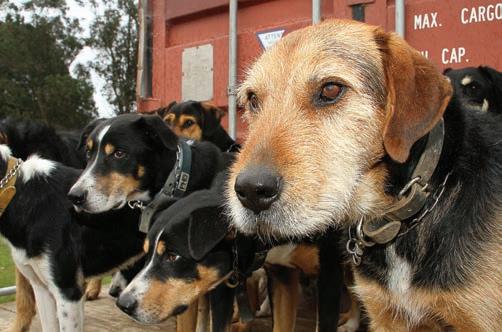


Also Bull trailer tandem, braked, 2 pens, rego on hold. And a Maize silo approximately 10 tonne capacity. $2000+gst. Phone 027 283 8794.

Did you know that Carrfields conduct weekly cattle sales on the outskirts of Cambridge every Tuesday at Hickey Road.
Carrfields is committed to providing the best possible outcomes for both vendors and purchasers of the livestock presented and as such is pleased to be able to offer certified selling weighing scales in the very near future.
Take the guess work away, remove the ‘eyeometer’, and buy and sell with confidence at Carrfields’ Cambridge saleyards.
CONTACT YOUR LOCAL TEAM
Ben Deroles – 027 702 4196
Luke Gilbert – 027 849 2112
Mike Mckenzie – 027 674 1149
Matt Hancock – 027 601 3787
Kelly Higgins – 027 600 2374
Paul Nitschke – 027 481 3160
Pat Sheely – 027 496 0153
Danny O’leary – 021 954 283
John Price – 027 594 2544
www.carrfields.co.nz

Carrfields Hawera Calf Sale
Thursday 24th July
Hawera A & P Showgrounds 12:30pm Start
Comprising of:
x Frsn Bulls
x Mixed Sex Beef Every consecutive Thursday till advised otherwise
Carrfields Cow/Store Cattle Sale
Tuesday 29th July
Duthie Road Saleyards 11:30am Start
Comprising of:
x Cull/MT Cows
x M/S R2
x
x
Yard and buy with confidence, all cattle sold over the scales with weight displayed! Take advantage of the premiums being made at auction and yard your cattle with us.
CONTACT YOUR LOCAL AGENTS:
Hornby – 027 636 2090
Crowley – 027 215 3609
Espin – 027 551 3660
Hurley – 027 414 6756
Kiernan – 027 823 2373












A wealthy real estate investor is looking to buy more land for development, but a local farmer won’t sell the last plot he needs
The investor makes many offers to buy the farmer’s land. But he always refused to sell. So he gets the idea that if he sabotages the farmer’s crops, then he’ll go broke and have to sell. Then he looks around for a couple of braindead thugs to hire that’ll do whatever he wants for cheap, and gets them to sabotage the farmer’s crops. So the two thugs he hired leave and come back a few days later, filthy and smelly. And they tell their boss that it’s done. And there’s no way that farmer’s crops will survive now. And the real estate investor says “Great! How did you do it?”.
The two thugs look at each other with big smug grins and say “We covered all his fields in cow manure! Ain’t nothin’ growing in that nasty stuff!”
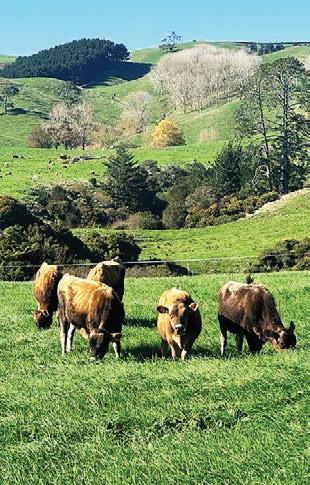




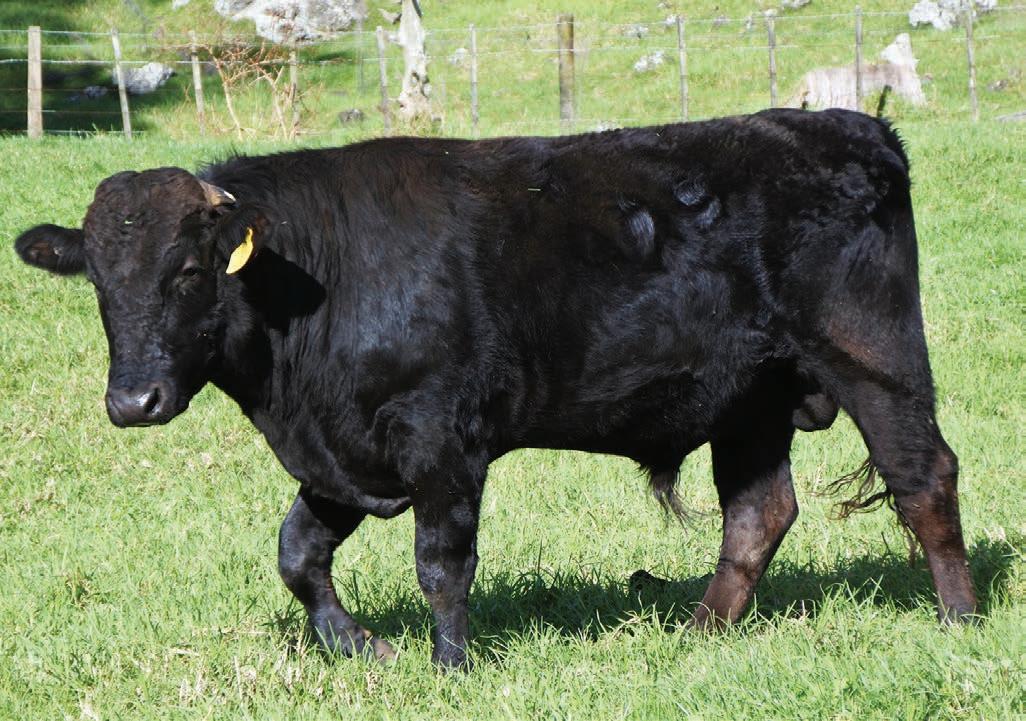
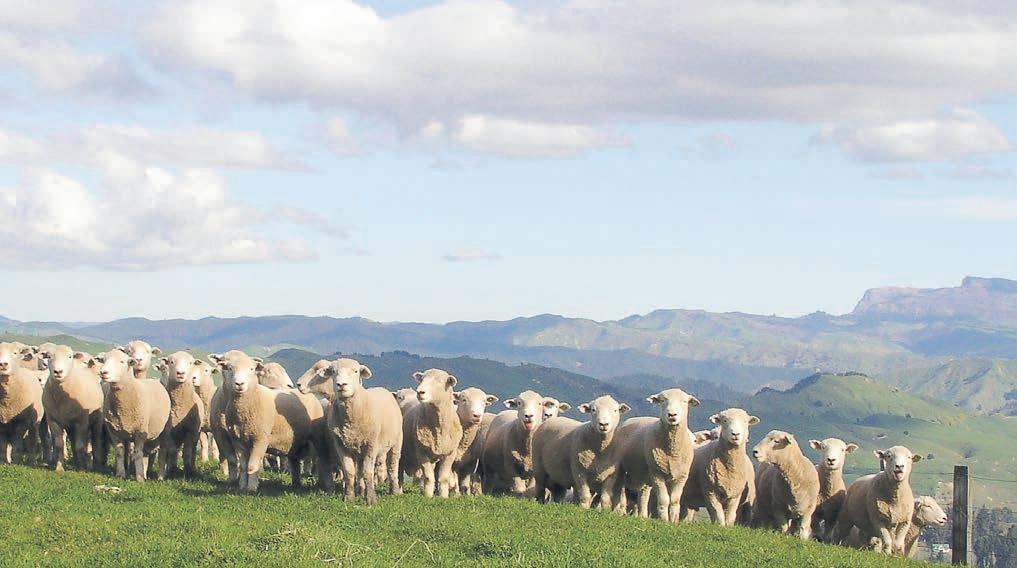

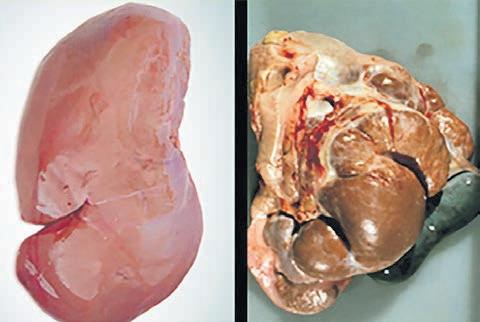


Drought in the United States is raining healthy returns on NZ beef and, with a shortage of bulls to fill orders, processors are turning to cows.

Fiona Quarrie MARKETS Livestock
WHEN a new record for Coalgate saleyards was set on prime traditional dry cows on July 10, it was almost a shame that quantities in the yards were so low. The 22-head of Angus and Angus-Hereford were drafted into two lines and the top cut at 618kg fetched $3.53/kg liveweight.
Those who follow the yards closely will know that the following Monday, Temuka saleyards blew these results out of the water, and this time there were numbers. There were 320-head of cows available that day, a mix of mostly traditional or dairy.
Even at these numbers, which are high for the time of year, there was no shortage of demand. The regulars had to compete with out-of-region buyers and a range of previously sporadic new faces. This meant that bids were flowing from in-house and online.
Returns for traditional cows started at $3.50/kg, just 3c/kg behind the record at Coalgate, but rose to $3.74/kg and that figure was achieved by multiple pens. In
the end, traditional cows averaged 560kg and $3.65/kg.
While differences in yield meant dairy cows didn’t reach the same levels, there was still plenty of upside for them too. A large proportion traded from $3.33/kg to $3.38/kg and Friesian averaged $3.35/kg in the end, an increase of 10c/kg from the previous week.
Demand for manufacturing beef has certainly increased in recent years, predominantly due to the decrease in the United States herd size caused by drought and their demand for imported lean grinding beef. On home soils, there is a shortage of bulls to fill orders, so processors have turned to cows instead.
All of this has contributed to closing the gap between schedules for prime steer and cow. The premium for prime steer over cow had been in excess of $2.10/kgCW through 2023 but it has since narrowed to $1.40/kgCW as an average for July 2025.
This puts the premium for steer at just 20% compared to a peak of 59% in 2023. The last time such strong cow schedules relative to prime were seen was 2015, and it is no coincidence that this too followed drought in the US.
As is often the case, good times don’t last forever. The spike in the
Get ahead of the market
Make informed livestock trading decisions with AgriHQ. Track key saleyard, paddock and slaughter prices, market indicators, and forecast prices through a suite of reports. Customise your selection and access everything in one convenient platform: myAgriHQ.

The last time such strong cow schedules relative to prime were seen was 2015.
cow schedule has come early this year and meat companies have suggested that narrow margins will limit any further upside. On the other hand, prime steer could still have some room to move and so the gap between the two schedules will likely grow again. At a time when we would all appreciate some sunny days, the old adage of “make hay while the sun shines” applies to those who have excess cows not already spoken for in contracts.
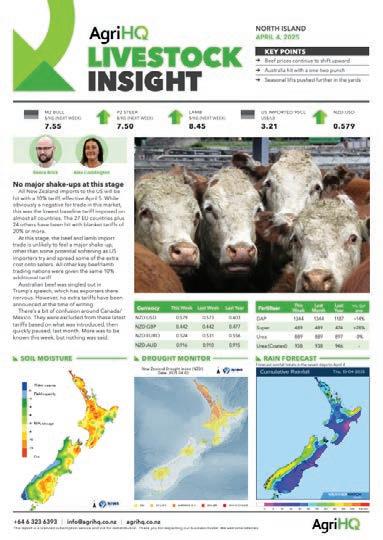



These weekly saleyard results are collated by the AgriHQ LivestockEye team. Cattle weights and prices are averages and sheep prices are ranges. For more detailed results and analysis subscribe to your selection of LivestockEye reports. Scan the QR code or visit www.agrihq.co.nz/livestock-reports
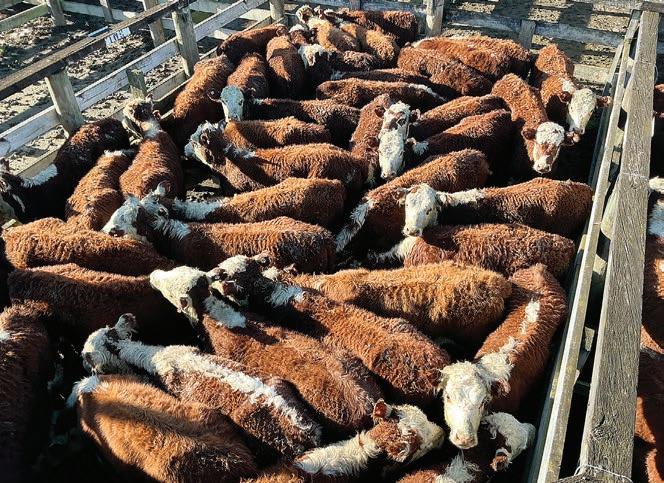















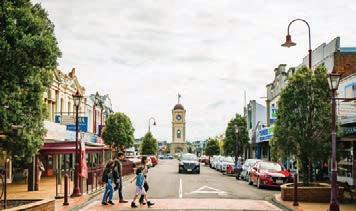
















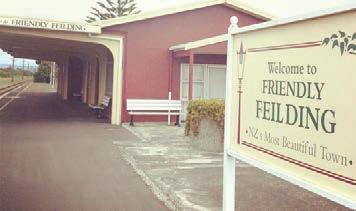

















Stortford Lodge | July 16 | 244 cattle
| July 10 | 511 sheep
Feilding | July 11 | 904 cattle, 11,803 sheep
Feilding | July 14 | 110 cattle, 2977

Philip Duncan NEWS Weather
THE first half of July kicked off with more rain than usual over many regions.
In the North Island all regions have been wetter than usual in July’s first half, with the exception of some eastern spots like eastern Coromandel Peninsula, East Cape to Gisborne, and central Hawke’s Bay to Wairarapa, which all had below normal rainfall.
The rest of the North Island leaned wetter. Wettest in the North Island was eastern Bay of Plenty, around Lake Taupō, Taranaki, Whanganui, western coastal Manawatū, Horowhenua, Kāpiti and Wellington, which were all about 200 to 400% wetter than usual.
Over 300mm was recorded around Mt Taranaki and also the tops of the Tararua Ranges.
In the South Island it’s not going to be a surprise to hear that it was northern regions that were the wettest, following the significant rain and flood events.
Large lows in the Tasman Sea
tapped into subtropical northerly airflows, jam-packed with moisture and then held up by all the mountains and ranges that “cradle” areas like Tasman, Nelson, Marlborough.
This whole area was up to 400% wetter than normal for the first half of July with over 300mm falling around Tākaka/Tasman area and around the Marlborough Sounds. Many times above the norm.
More big stuff is coming. This week kicks off with a powerful storm south of Australia and a potential tropical low north of NZ.
Further south and it’s been colder and drier for other South Island regions. Lowest rainfall has been through northern Southland and central Otago, with just 10% of normal rainfall and, according to NIWA’s maps (now “Earth Science’s New Zealand” but the NIWA brand is still being used) just 5mm fell in some of these areas over the past two weeks.
After some much wetter than usual months, Canterbury has been drier lately (by that, I mean rainfall hasn’t been as high as previous years at this time),with anywhere from 20 to 80% of normal rainfall being recorded by NIWA’s weather stations.
The West Coast is even more interesting when in contrast to saturated Nelson/Tasman, with wetter than usual conditions in the north, normal in central areas and drier than usual in south Westland and Fiordland.
Fiordland is one of the wettest places on earth and estimates of rainfall vary from 14 metres, to 18m to even over 20m of rain per year.
In the first half of July this wet part of New Zealand only had 20 to 50% of normal rainfall, equalling only about 50 to 100mm.
We said July would be about big highs and big lows and that has certainly been happening – so what is coming next?
More big stuff. This week kicks off with a powerful storm south of Australia and a potential tropical low north of NZ.
However NZ looks to have the first big high pressure system in
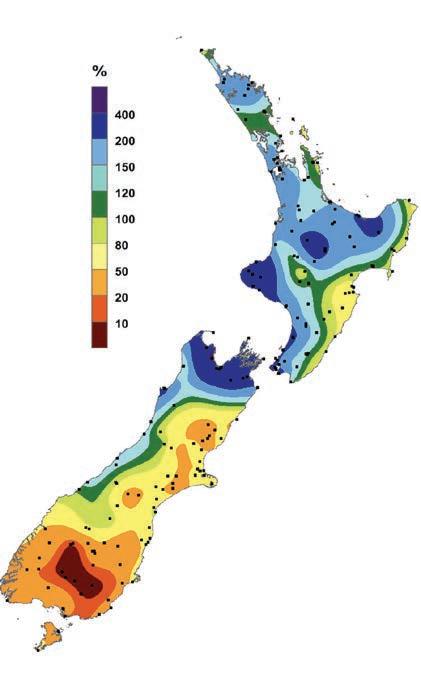
Rainfall Anomaly 9am 30/06/2025 to 9am 15/07/2025
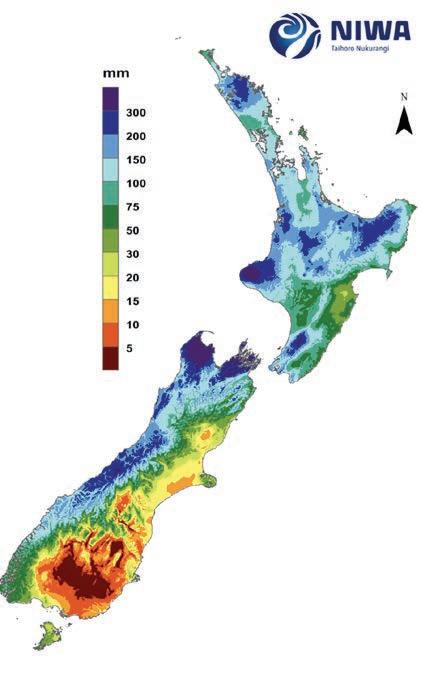
ALL RELATIVE: How much rain fell – and whether that is wetter or drier compared to previous Julys. Image: Earth Sciences NZ
weeks trying to move through, which for saturated regions spells great news.
But I think it’s fair to say Australia will likely send us a large
low towards August – as they are being hit by wintry, severe, weather week after week after week. Worth watching to see if that comes our way next.



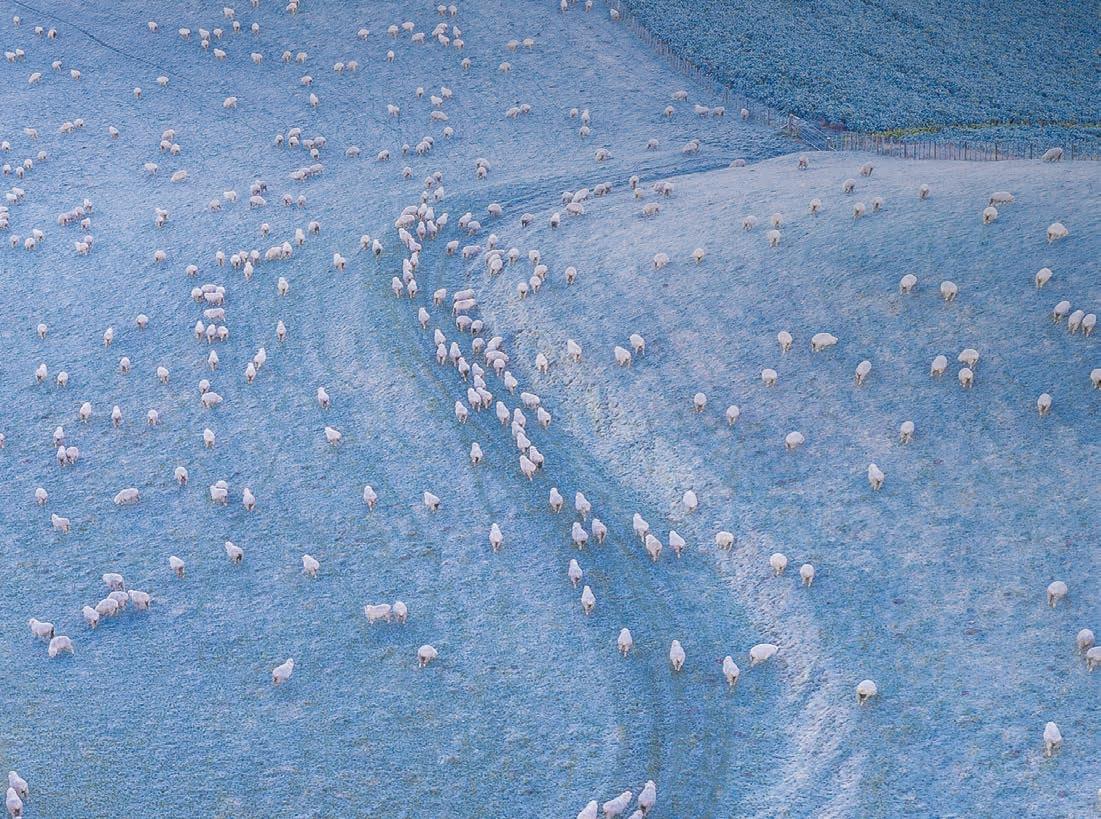

Welcome to the FMG Post , now part of Farmers Weekly
FMG clients will be familiar with FMG Post
For over a decade FMG has prod uced FMG Post using separate print and mailing partners, mailing and emailing it directly to Members and clients.
As an organisation owned by its Members, we have a responsibility to regularly share how the business is tracking provide insurance insights and advice and detail how, as a Mutual, we invest back into rural communities.
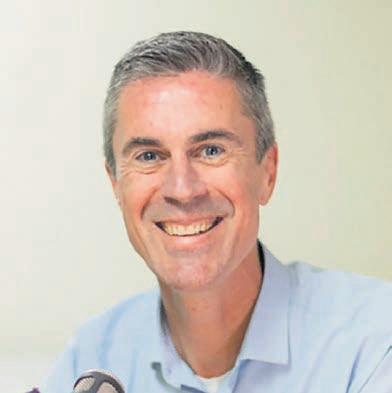

A large part of how we share this is through FMG Post , something our research shows is valued and trusted by readers
Prod ucing FMG Post with multiple suppliers was no longer cost effective and an alternative was needed, one that wasn’t just another email, as our research also showed that readers still appreciate hard copy material
Our solution team up with a trusted news agency The many benefits of partnering with Farmers Weekly include: the ability to continue to share important information with Members (and now others) in hard copy while red ucing the postage and packaging
costs. It’s saving Members’ money and we’re supporting a key rural media outlet at a time when media is struggling
FMG Post will be produced in Farmers Weekly three times a year, with the next editions in November and again in March 2026
While nearly 60% of farmers and growers already insure with FMG, we appreciate not everyone will be familiar with who we are. So, in this edition we’ll explain a little more about ourselves and what we do to deliver on our purpose of ‘Providing a Better Deal for rural New Zealand Aotearoa’
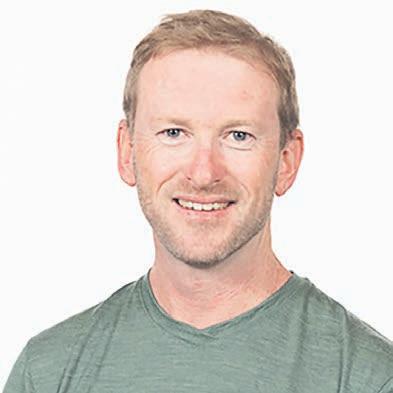
At Farmers Weekly, our mission is providing essential news, analysis and insights to navigate the sector We know how important trusted partners are who share that commitment
That’s why we’re delighted to welcome the FMG Post as a regular pull-out FMG’s dedication to New Zealand farmers and
growers matches our own They understand your unique challenges and opportunities, and their commitment to valuable information and support shows clearly in FMG Post
This partnership isn’t just about convenience - it’s about strengthening vital information flow to communities The FMG Post
brings practical advice, inspiring stories, and important updates directly to you complementing the trusted news and analysis Farmers Weekly delivers.
We believe a well-informed sector is resilient and confident. By bringing the FMG Post into Farmers Weekly, we’re creating a powerful partnership benefiting all readers
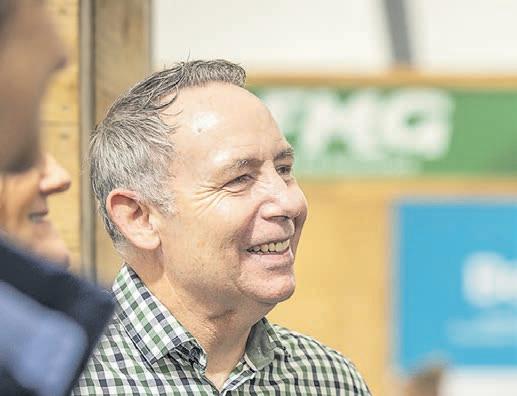

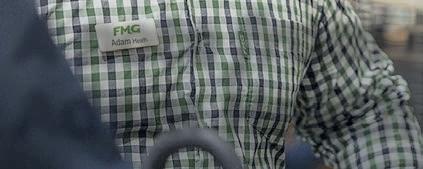

Kia ora koutou katoa
I’d like to open my first note in Farmers Weekly acknowledging those impacted by the recent weather events, and to offer assurance that our teams are doing all they can to help clients recover.
If you’re yet to lodge a claim, I encourage you to do so as quickly as is practical, as the sooner we have these details, the quicker we can help
Stepping back from this and looking more broadly, I feel there’s a sense of optimism across the sector
I recently attended the FMG Young Farmer of the Year Grand Final in Invercargill Waihōpai and the talent and passion on display was outstanding Congratulations to Hugh Jackson, for becoming the 57th winner of this prestigious contest, and to everyone who competed at all levels
With such committed and determined young farmers leading the way, the future of the rural sector is very bright
I also felt a sense of optimism from those I spoke with at National Fieldays last month, with many talking of increasingly positive farm gate returns which equally, is a great sign
FMG too is in good heart and on track to record a strong profit This year’s result will be down to a combination of solid insurance revenue, favourable investment markets and a benign year for major claims
FMG’s financial results will be available on our website later this month
We’re pleased to also deliver a positive result from our recent quarterly pricing reviews We’ve made around $35 million in premium reductions across several products, meaning clients holding these products may receive premium decreases or smaller premium increases on renewal
Finally I’d like to acknowledge this new partnership with Farmers Weekly, I hope you enjoy the articles Innovation doesn’t always need to be big – it just needs to be effective and this small shift in thinking is a great example of that and just one of the ways we aim to deliver our Vision of ‘helping to build strong and prosperous rural communities’
We are the leading rural insurer in New Zealand
Aotearoa, proudly 100% locally owned and operated.
FMG was created by farmers for farmers and has supported the rural sector in good times and bad for 120 years. Here we share a little about us.
This year, FMG celebrates 120 years of being there when the unexpected happens.
In 1905 a visionary and pioneering group of farmers, led by Sir James Wilson, became disenchanted with the offerings from proprietary insurers of the day and decided to take things into their own hands That pivotal decision led to the creation of the Farmers Union Mutual Fire Insurance Associations, the first seeds of what would become FMG
Those early pioneers started the Mutual with a promise in the form of £100 Promissory Notes, agreeing to honour the claims of other Members up to that £100 A great example of the essence of mutuality: what is returned is what a member contributes
We’re owned by the Members who insure with us We aim to be profit making, not profit maximising with any money we make remaining in New Zealand Aotearoa and going back into the business to: run FMG, be prepared for future events and to support the communities that support us
FMG either sponsors or supports more than 700 events across the country each year This ranges from lamb and calf days and A&P shows through to our bigger givebacks including our rural wellbeing programme Farmstrong FMG is a founding and funding partner of Farmstrong which is celebrating its 10th
year of supporting rural communities this year We’re also the Principal Sponsor of the FMG Young Farmer of the Year Contest which we’re also marking 10 years of supporting this year
If you look at our logo, you’ll see underneath it that the word Advice goes before Insurance. Why is that? As a Mutual we think it’s important to help you protect what you have, as well as be there when the unexpected happens. We use our own 120 years of experience, along with our claims’ insights and the expertise of specialist partners to provide Members with practical advice that can help prevent damage and disruption from happening in the first place.
We have around 950 employees – all based in our 30 offices around the country This includes some 200 mobile roles, driving up and down rural roads every week , backed by a service center in the Manawatū where our claims team is largely based. We have more client servicing roles based in our Canterbury office too
Whilst we’re a New Zealand Aotearoa based business, we’re backed by over 40 reinsurers globally We’re also part of the International Cooperative and Mutual Insurance Federation (ICMIF ) which brings together Mutuals and Cooperatives to share insights to help us all improve how we support our sectors.
Whilst FMG was started by farmers for farmers, our support of the sector has widened considerably over that time and covers four main segments.
• Farming and Growing
• Commercial Lifestyle
• Residential
We focus on long-term sustainability and resilience, fostering strong relationships and trust with clients and communities. Our approach provides support not just at claims time, but as a continuous presence within communities. We’ve become an icon with beanies, sunhats, and drink bottles spotted on farms and orchards across the country and our flags flying high at major provincial and national events
To further support strong and prosperous communities, in 202 3 we became the first B Corp certified general insurer in New Zealand Aotearoa
Our B Corp certification ensures we meet high standards of verified social and environmental performance, transparency, and accountability in everything we do


For some, Spring can often mean the windy season which can be a worrying time for irrigator owners.
After teaming up with IrrigationNZ we developed an Irrigator Advice Guide offering some thoughts on helping your Irrigator stay upright when strong winds hit This advice is built around Point , Park and Anchor
If strong winds are predicted, the advice recommends you point the irrigator into the prevailing wind, park it in a designated spot and ensure it’s correctly anchored. Wind accounts for over a third
of our irrigator claims, with about 60% of these incidents occurring between September and November.
Having a proactive plan for windstorms can significantly ease pressure.
Our work with ind ustry bodies like IrrigationNZ reinforce the importance of this approach. Your plan should cover wind prediction, responsibilities, and necessary actions. These preventative measures could help remove or red uce the high costs of repairs and potential disruption to your business operations.
Watch out for hazards
Beyond wind, irrigators are often damaged by hitting things such as
overgrown trees and machinery parked in the way Start the season by checking for hazards along the irrigator ’ s path. Walk the track before running the irrigator a small amount of work now could help prevent damage later
For a comprehensive guide to protecting your irrigator, visit our online advice hub at fmg.co.nz/advice/irrigators
What we know
- Corner arms have been damaged in up to 7 % of wind-related claims
- In 202 3 alone, we spent nearly $7 million on irrigator repair costs.

- Over the past five years, we’ve supported more than 1, 300 claims, totalling $28 million.
- The average cost of an irrigator claim totals around $21,000











On June 18, 2024 , dairy farmer A aron Kane from Shannon, Manawatū, experienced firsthand the impact of rural crime when thieves stripped copper piping from his milk vat The disruption to his business and repair costs far outweighed the value of the stolen copper leaving A aron with a profound sense of frustration and distrust
A aron’s experience isn’t isolated. Rural crime has been rising in New Zealand Aotearoa over the past five years, with nearly two-thirds of FMG’s theft claims coming from rural addresses Theft claims typically peak around farm change-over period: June to July, and again from December to February
In partnership with New Zealand Police, we’ve developed guidance to help you prevent rural theft and avoid experiences like A aron’s. While these tips may seem simple, they are often overlooked and contribute to common claims we see daily
Here are our top tips to help you reduce rural theft risk:
• Make it hard to get in - Secure all entry points with locks Make a habit of locking up your possessions and removing keys, valuables, and equipment from vehicles when not in use.
• Make it less attractive to take your belongings - Engrave or distinctively mark your equipment and tools. Welllit areas, motion sensor lights, alarm
systems, and security cameras also act as strong deterrents.
• Report it - If you are targeted by thieves, always report it to the Police This helps track patterns and increases the chance of apprehending culprits and may help retrieve your belongings.
• Understand your insurance - Stay vigilant about underinsurance. Regularly review your sum insured and policies to ensure they reflect your needs and the true replacement cost of items. Recording serial numbers and photos can also help track lost items and assist your claim
A recent Government commitment to use wool carpets in 4 , 500 new state homes is a significant and welcome win for New Zealand
Aotearoa sheep farmers
spent te we come or ew Z aland farmer t is frui n a ci lo p c s, h s ec
We encouraged this move earlier in the year and are delighted to see it come to fruition For farmers facing low prices, this decision provides a much-needed boost , supporting local jobs and the rural communities that rely on a thriving wool ind ustry.
What Do YOU Want to Read in the FMG Post?
n o i s -n ed o s p rt n ca o s r l o n t h t x her
Help us shape our n publication! Scan h to share your feedback and tell us what insurance-related topics are on your mind.



To help save lives, we are sponsoring a new, South Island-based skin cancer spot check van for Melanoma New Zealand. This expands the FMG Spot Check Roadie, making it easier for those in rural communities to get a free, expert check
New Zealand Aotearoa has one of the world’s highest melanoma rates, but early detection is key With vans now covering both islands, we encourage you and your family to take advantage of this life-saving service.
For Wairarapa farmer James Bruce, the key to managing a busy farm, breaking in horses, and coaching rugby is simple: stay organised and find joy in the small moments.
James runs 7,000 stock units, a job he used to do alone Now, with the help of a young farmer and local school kids, he’s found a better balance He actively combats the potential for isolation by celebrating the “fist pump moments” in his day – whether it’s singing on the bike or pausing to appreciate a stunning view “It just reminded me that’s why I love farming,” he says
A pillar of his community, James dedicates around 30 hours a week off-farm to coaching rugby and running gym classes p of his 60-hour week of farming ecret to fitting it all in is making firm itments “Making commitments like g up at 6pm for rugby training gives
Celebrating a decade of making a difference with Farmstrong For 10 years, we’ve been providing the tools to manage pressure, helping farmers live well to farm well.
me a reason to pull the pin each day and get some balance in my life,” he explains “It gets me off farm and helps preserve my love of farming ”
Find the full sched ule of upcoming visits at melanoma org.nz on to The s comm turnin
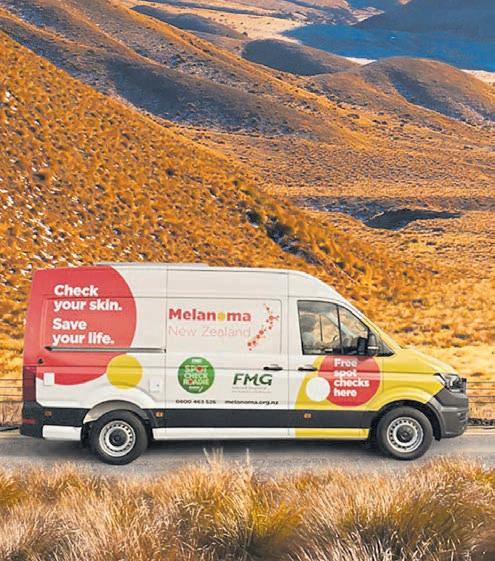

This structured approach is crucial. James is a meticulous planner, using a diary to ensure his week is manageable and he can relax d uring his time off This mental clarity allows him to be fully present , whether he’s with his rugby team or breaking in a horse. “It doesn’t matter what sort of day I’ve had, I’ve gotta leave it all at the gate.” His message to other farmers is about resilience and perspective. “ You’ve just gotta keep leaning forward,” James advises. “ There’s a reason they make rear vision mirrors so small You don’t see a whole lot back there, because you don’t need to ”

We’re committed to giving back to the rural communities that support us.
The Associate Director on the FMG Board of Directors is just one of the ways we do this The role provides a unique opportunity for an emerging agri-professional to join the FMG Board of directors for two years gaining firsthand experience in governance process and board discussions, all contributing to developing critical leadership skills to help drive the future of the Primary Sector
Jackie Dalziel is the current Associate Director and shares some of her reflections on her first year in the role.
Jackie’s governance journey began four years ago as the first female Director at the Lower Waitaki Irrigation Company, where she realised that experience is key to learning governance. This inspired her to apply for FMG’s Associate Director role.
“ The opportunity seemed like a great match, as I’m passionate about the ag sector but also interested in broadening that knowledge.”
Over the past year, Jackie has valued the Board’s mentorship, “ They ’ ve really welcomed me and are so willing to explain things to me while at the s ame time pushing me to perform as an Associate Director ”
“ This role isn’t just about attending a few meetings, it’s about constantly being better - growing my knowledge, my network , my skills ”
Jackie shared her appreciation for how FMG embraces mutuality “ The Mutual values are at the core of every single decision the FMG Board makes. It means people who really ‘get it’ are on the Board, and that we, as members, get a say in who those people are.”
Jackie acknowledges that applying for Director positions can be challenging, noting “ They can be daunting and the election process for Co-operatives and Mutuals in the agriculture ind ustry can be brutal ” She advocates for other organisations to offer Associate Director roles. “Getting that ‘middle of the road’ role creates a pathway for new Directors to be more role ready ”
Jackie urges aspiring leaders to find a Board that aligns with their values and take the leap, adding, “In New Zealand, we are fortunate to have an amazing primary industry But we do, and always will, need to protect that through good governance. So, we need people to be brave and have a go, but also to do it well ”
Jackie believes the FMG Associate Director role has been invaluable, encouraging others to apply when it next becomes available in 2026 “If you’ve had a taste for governance and you’re interested in developing further, then the FMG Associate Director role is definitely worth applying for ”
FMG’s Chief People Officer, Nicki MacKay, shared, “FMG’s Associate Director role is a powerful way we invest in the future of governance and promote leadership in rural New Zealand. It equips emerging leaders with experience to uphold mutual values, strengthen the long-term sustainability of FMG, and bring fresh perspectives to the boardroom.”*
*The FMG Associate Director role does not have voting rights, and whilst expenses are covered to attend meeting, it’s an unpaid position.